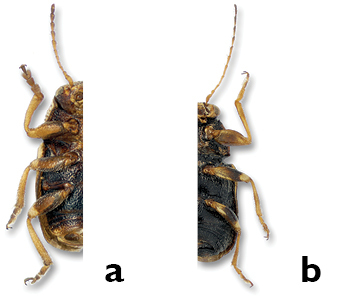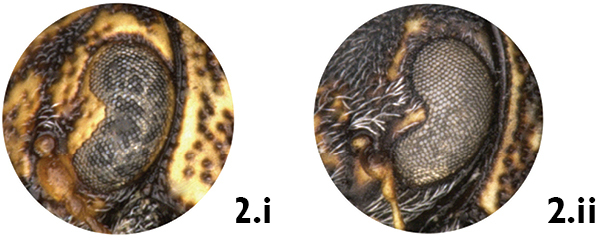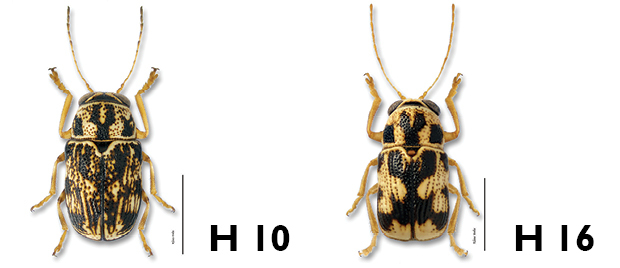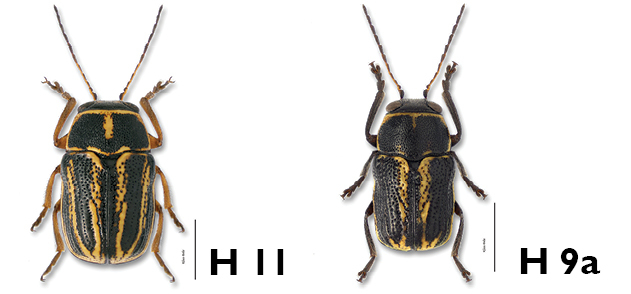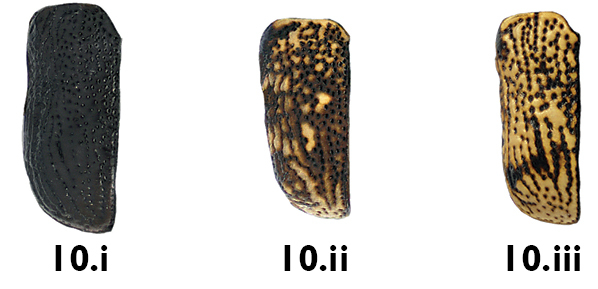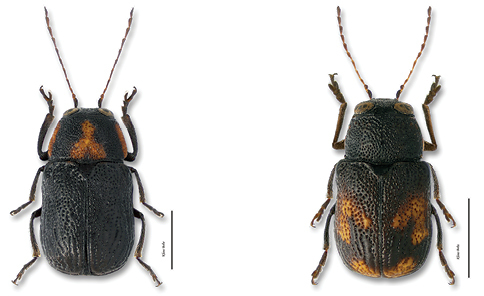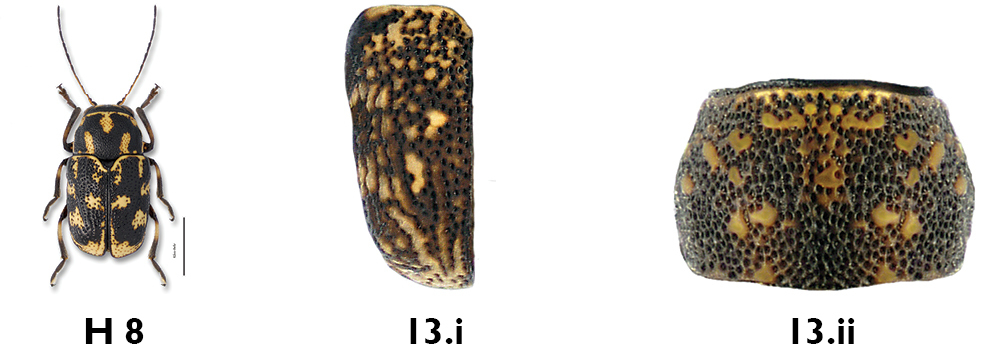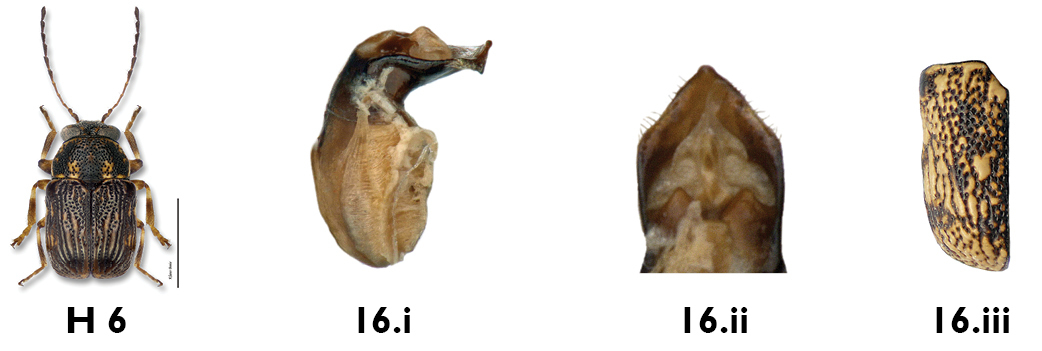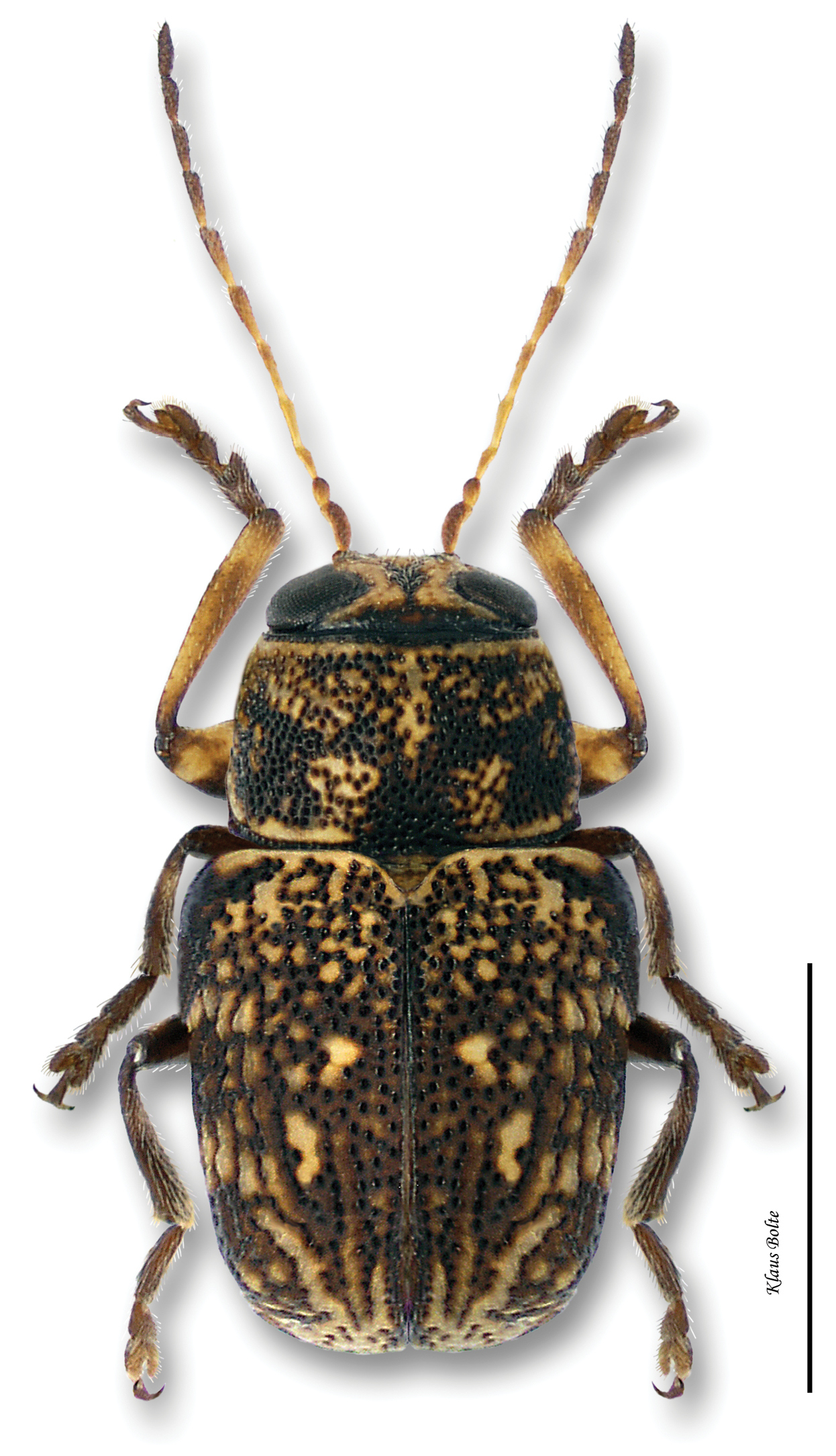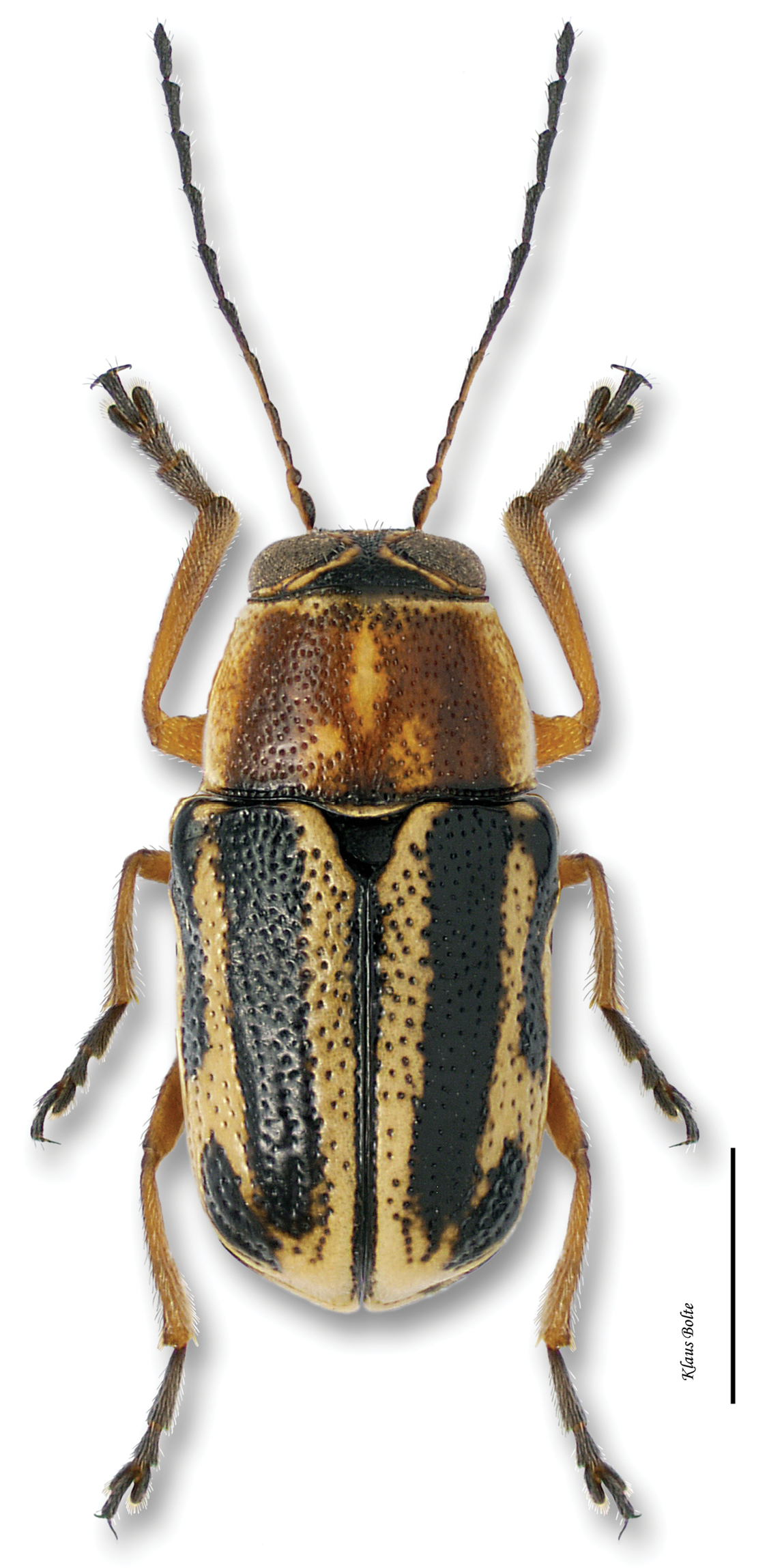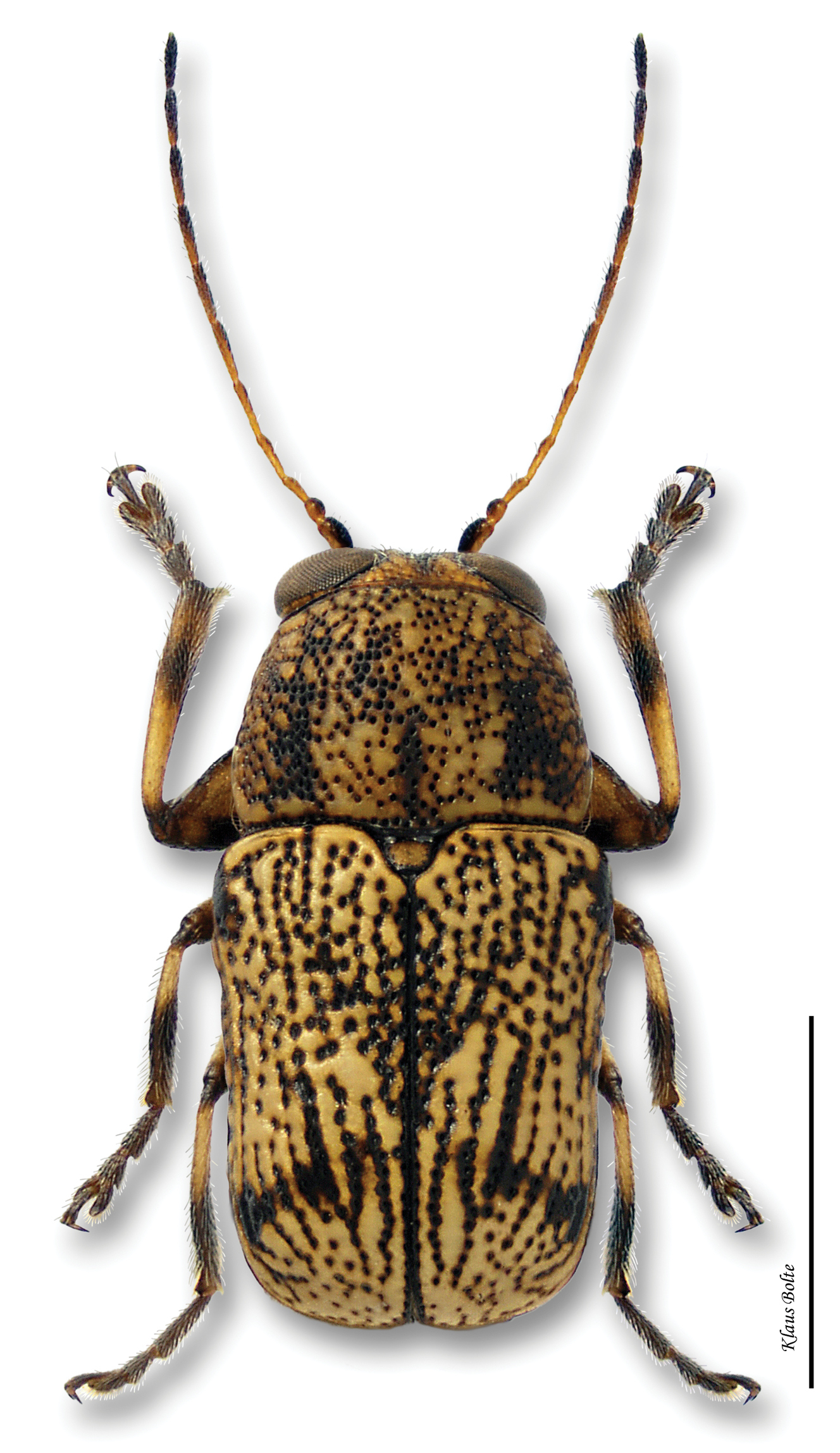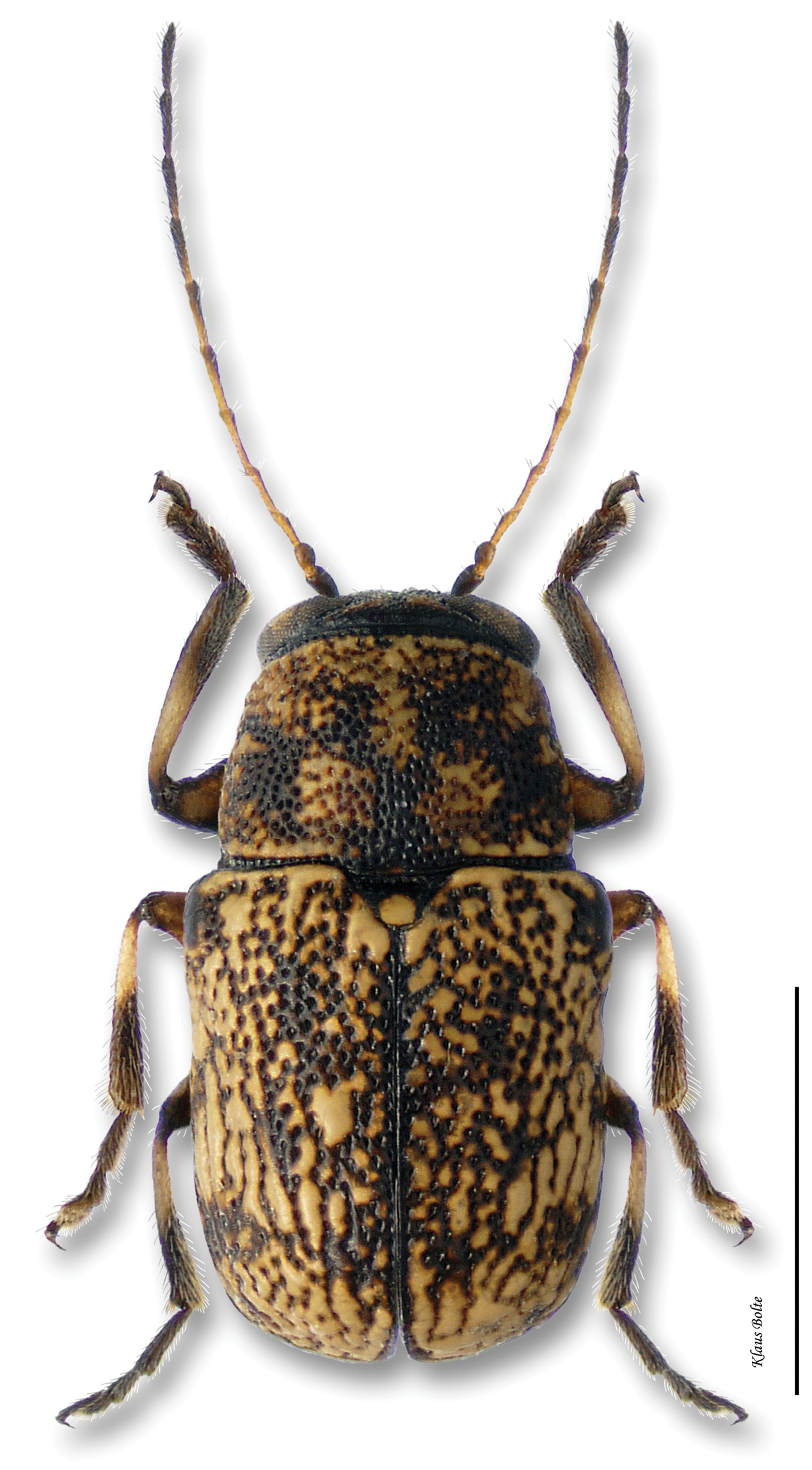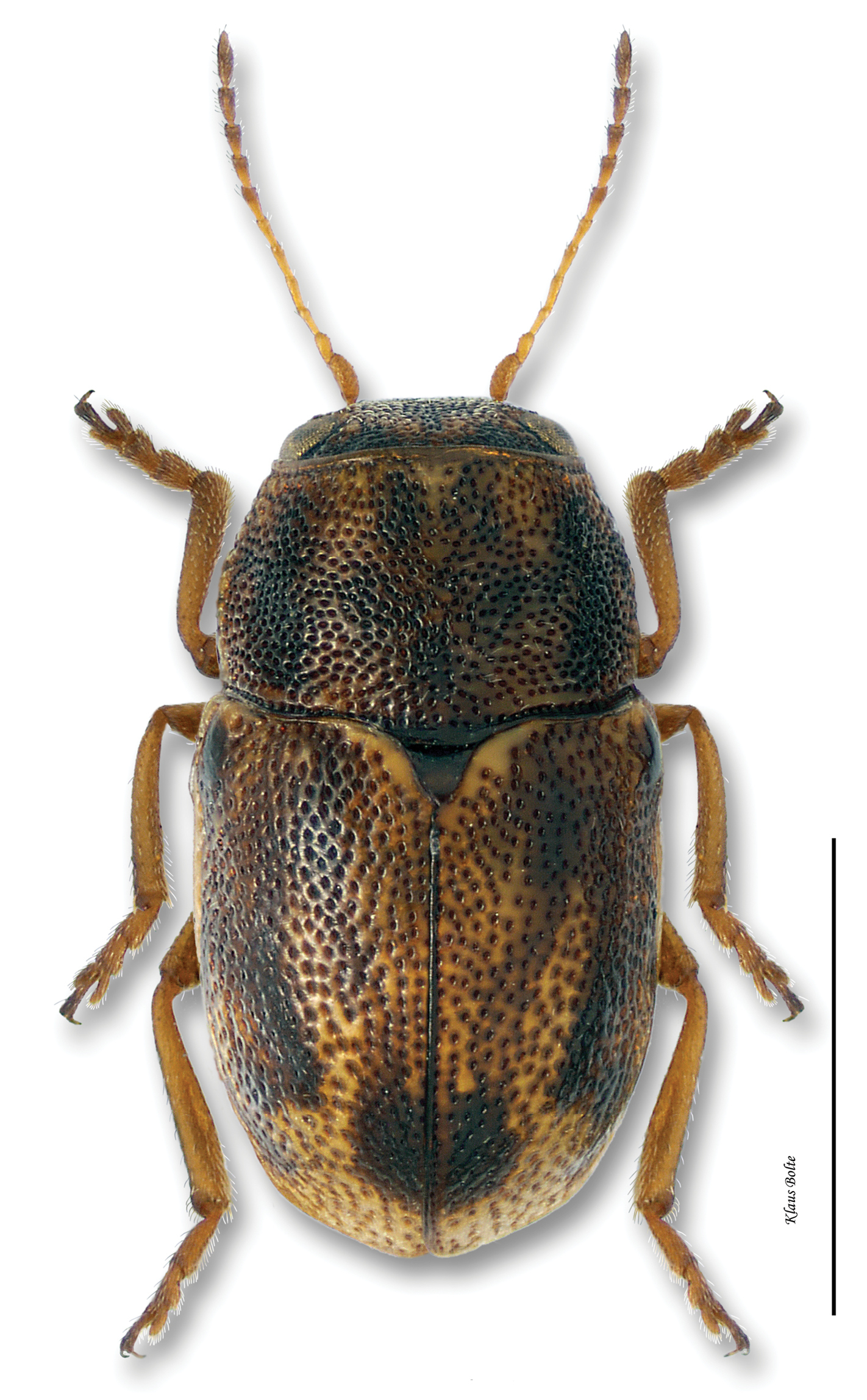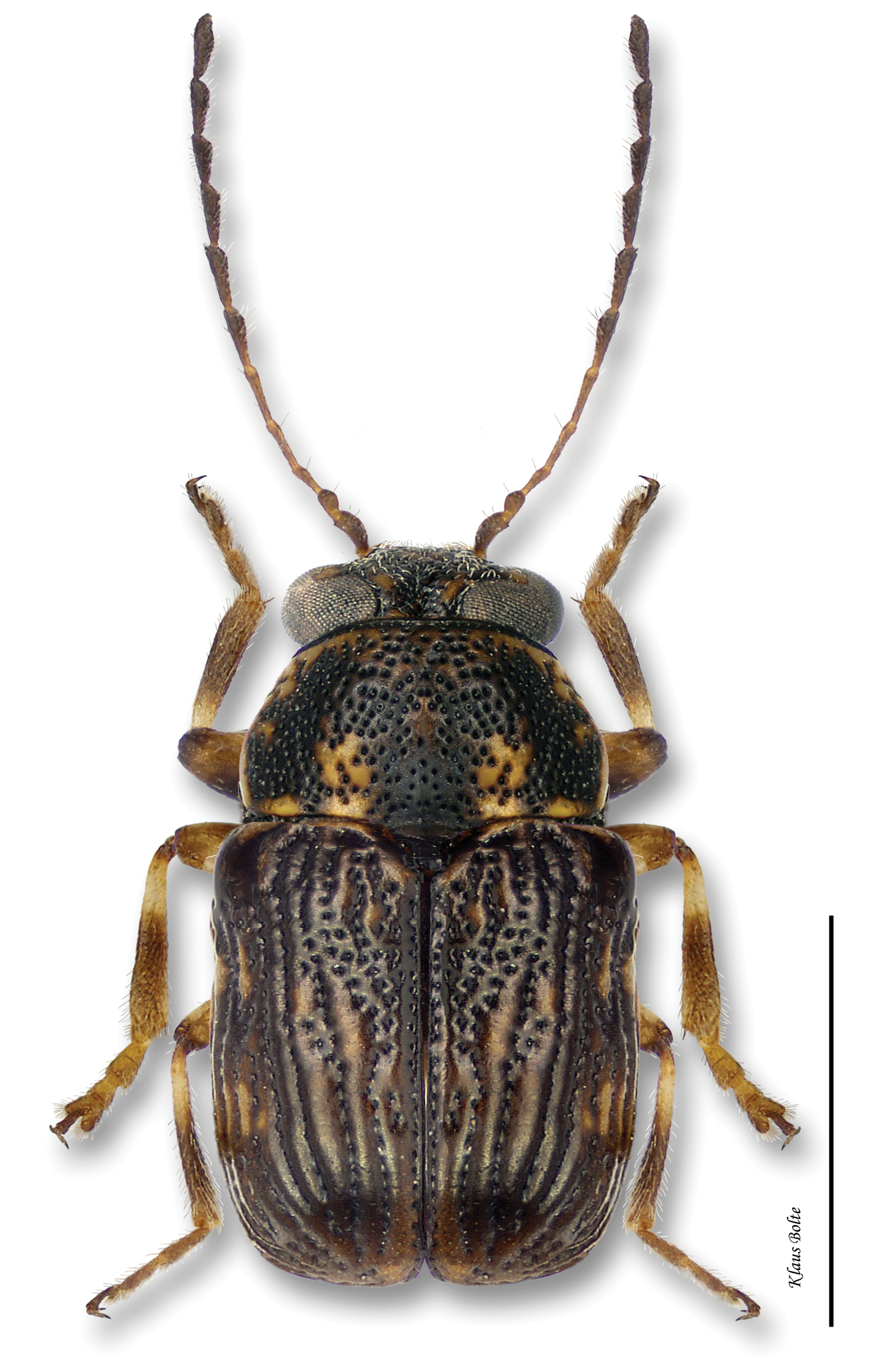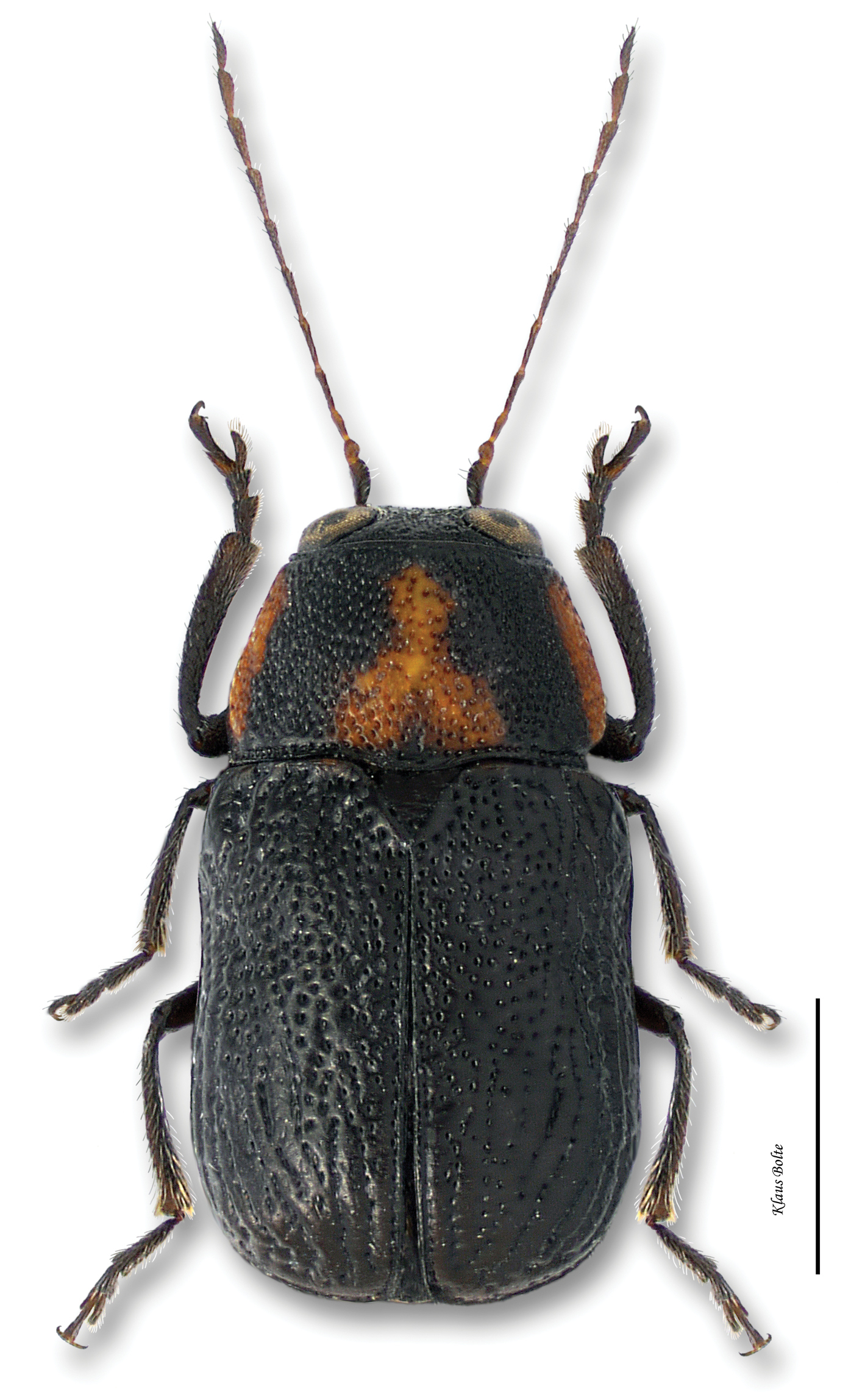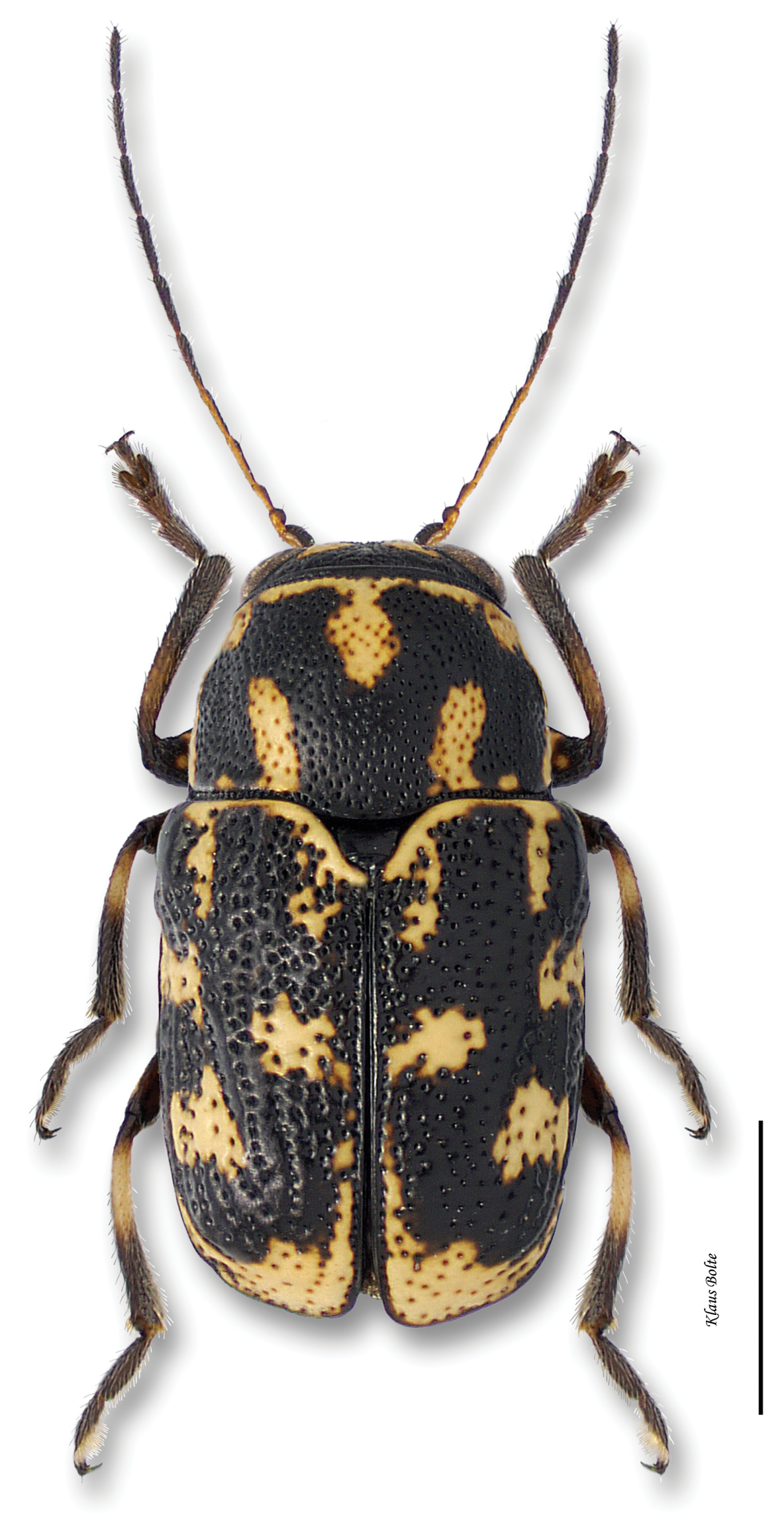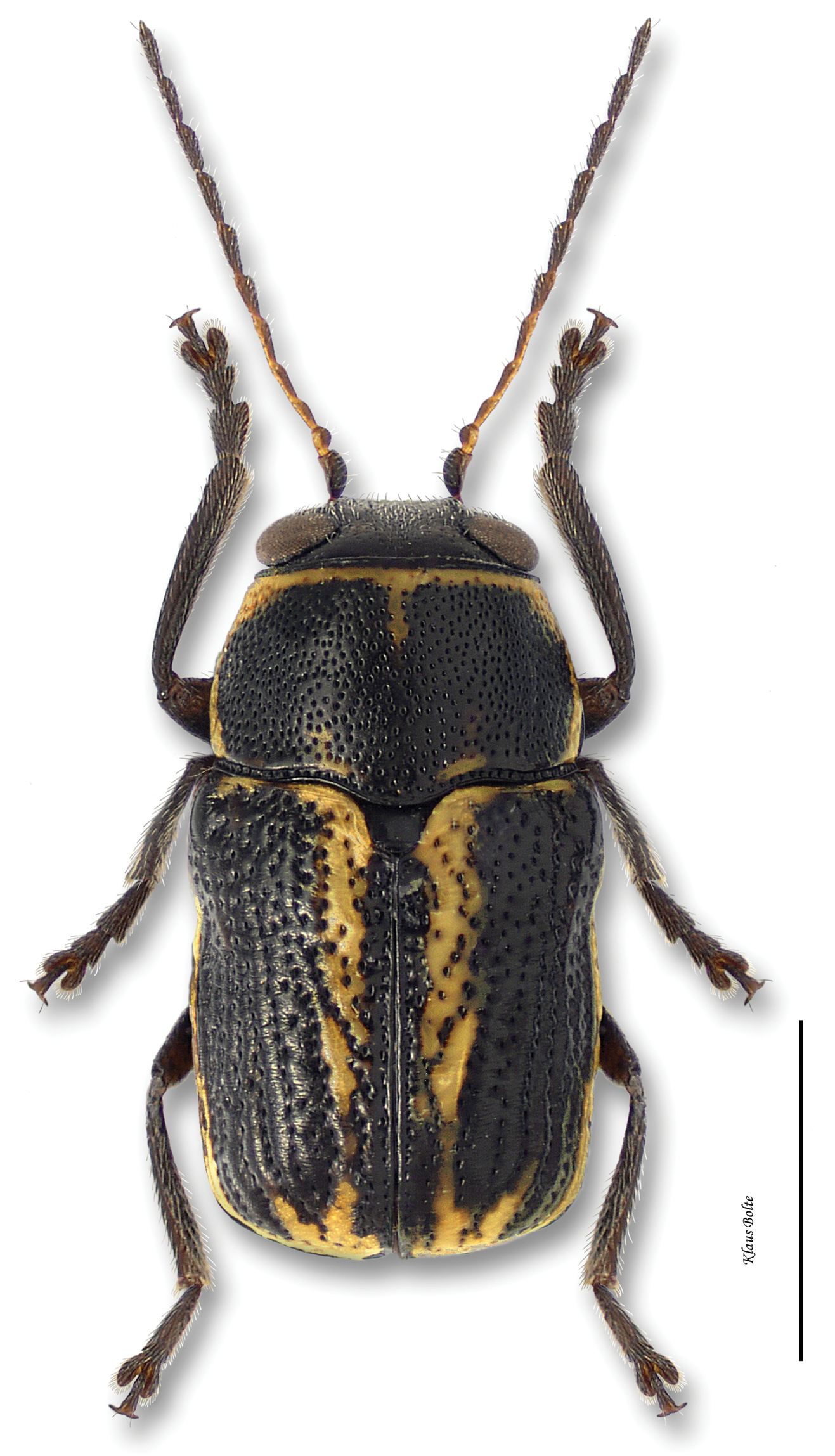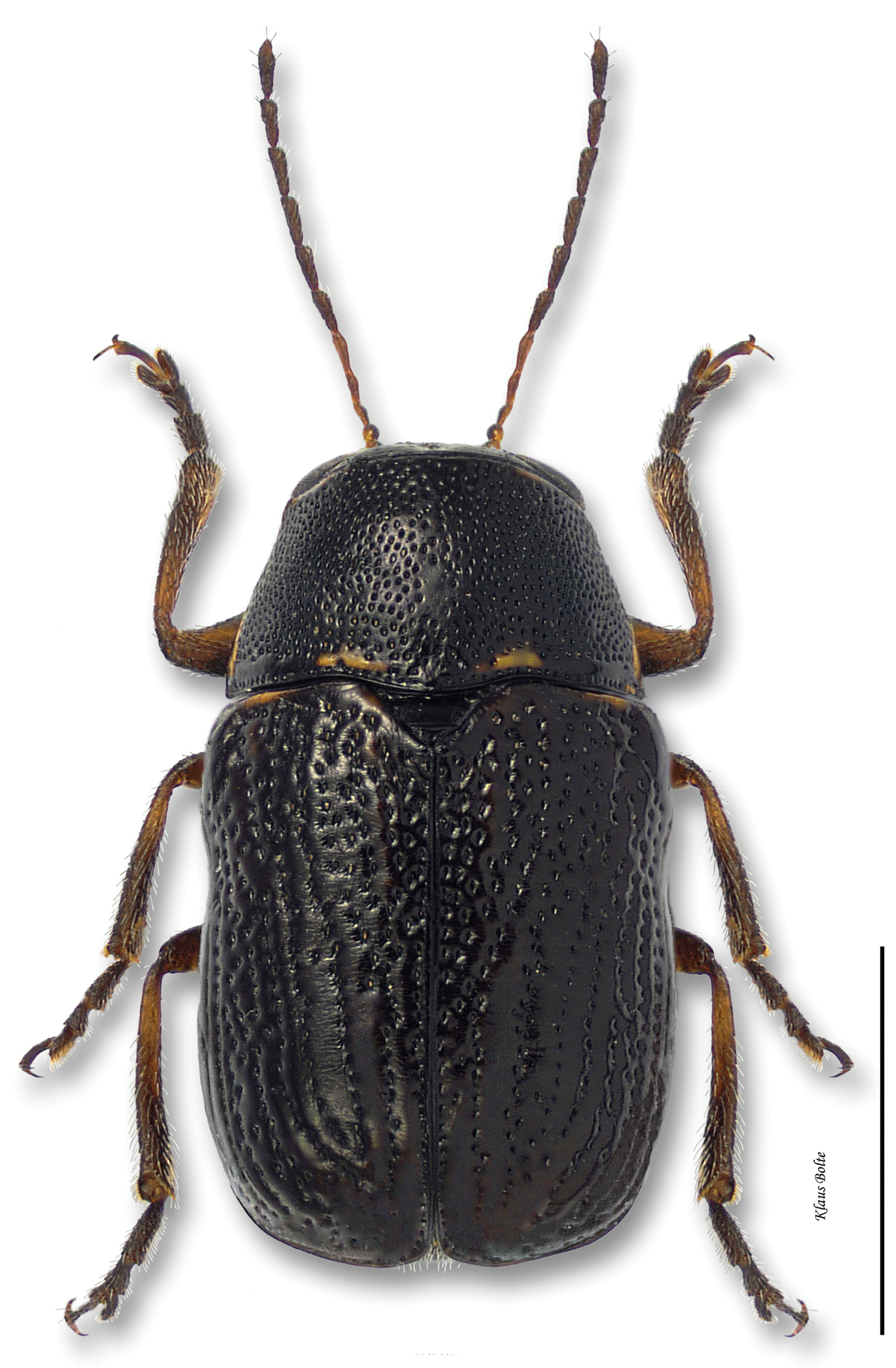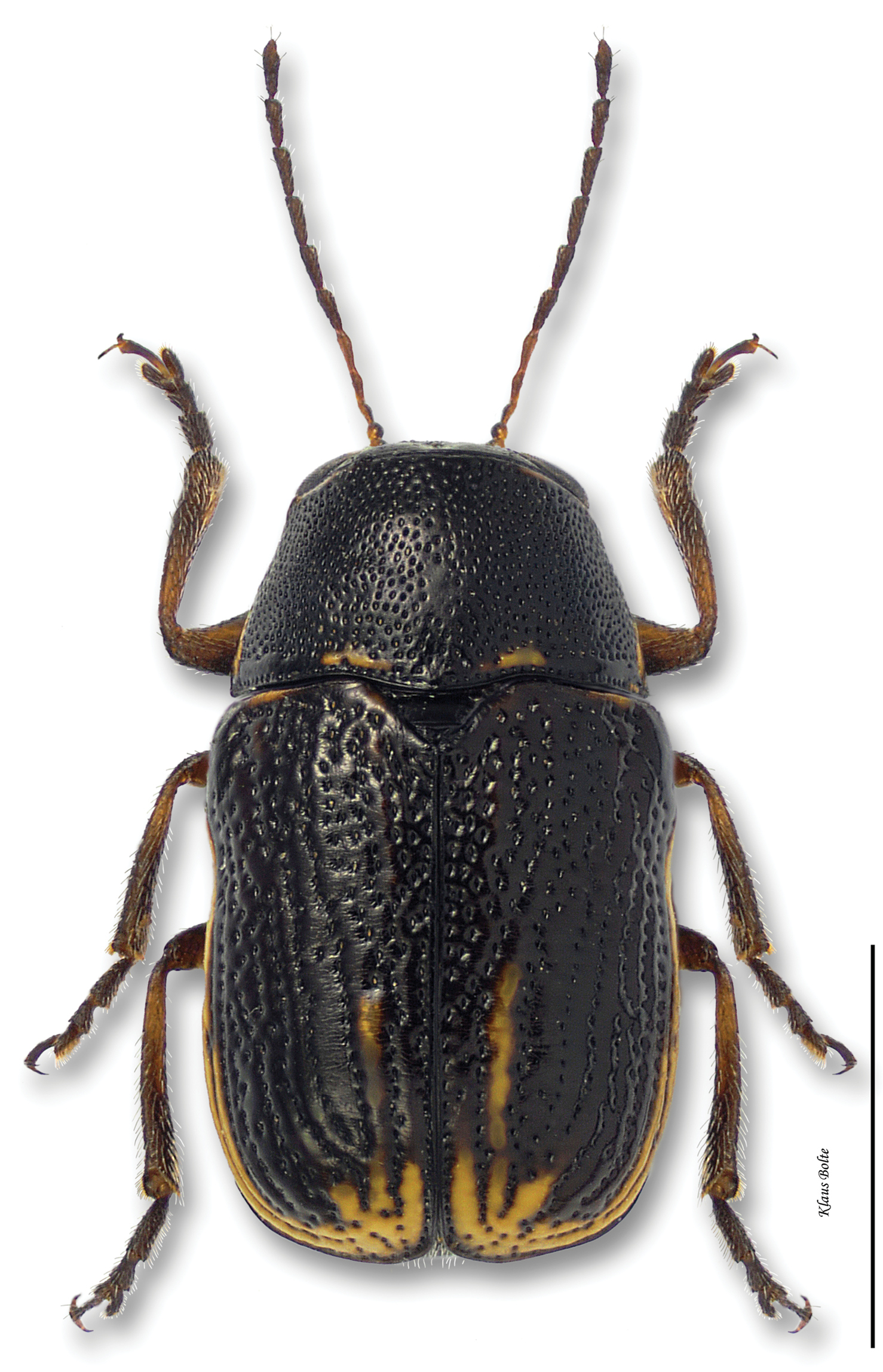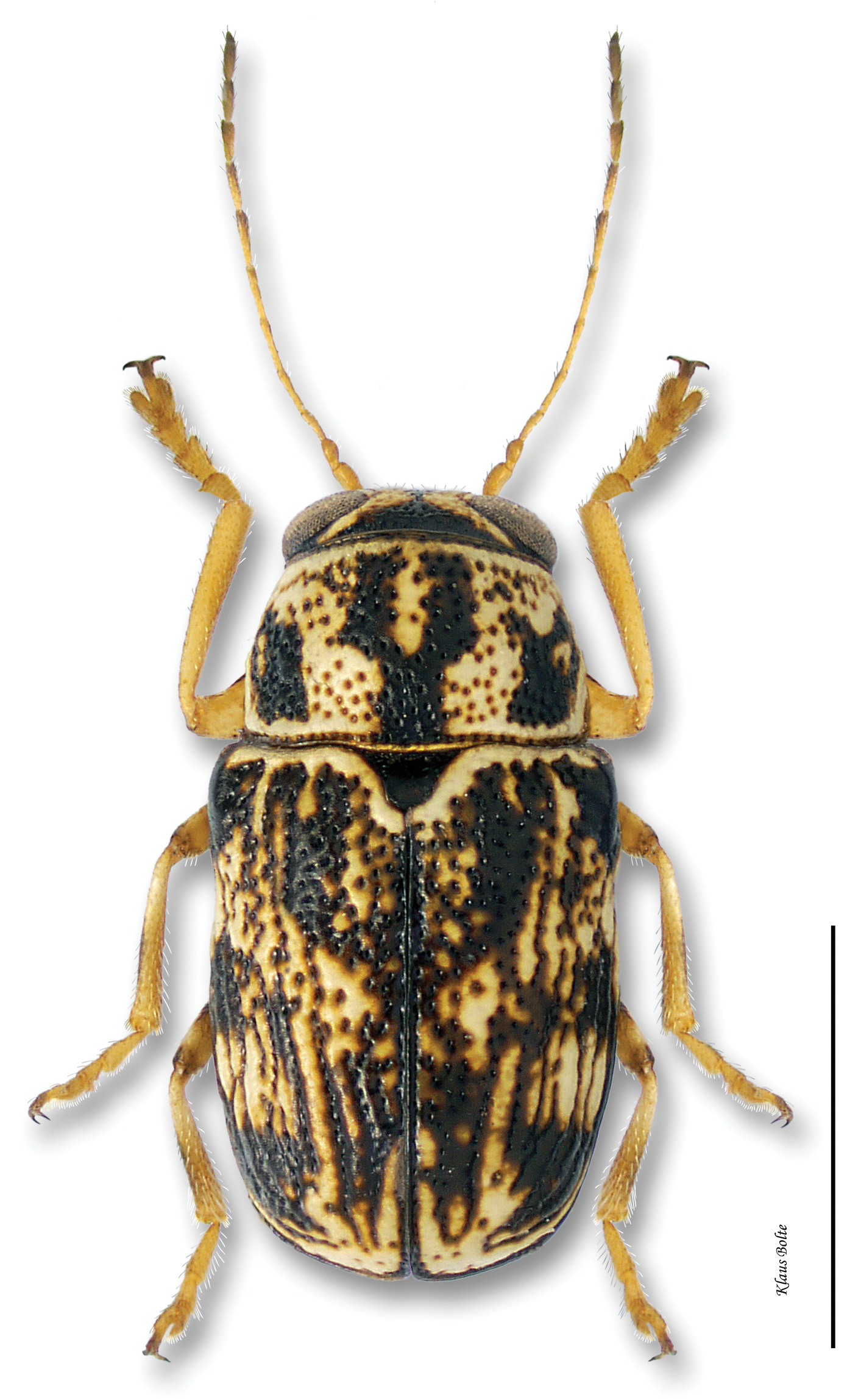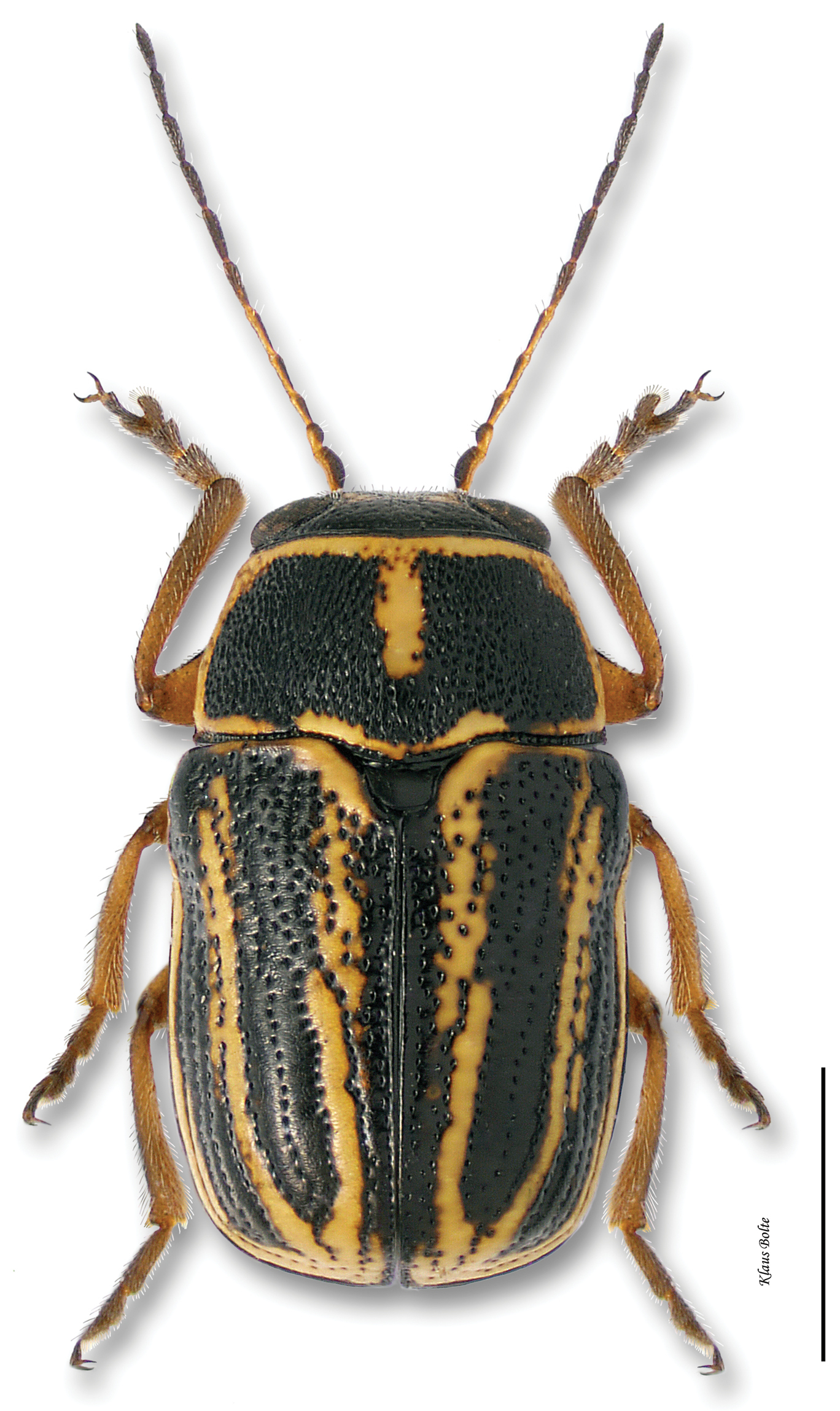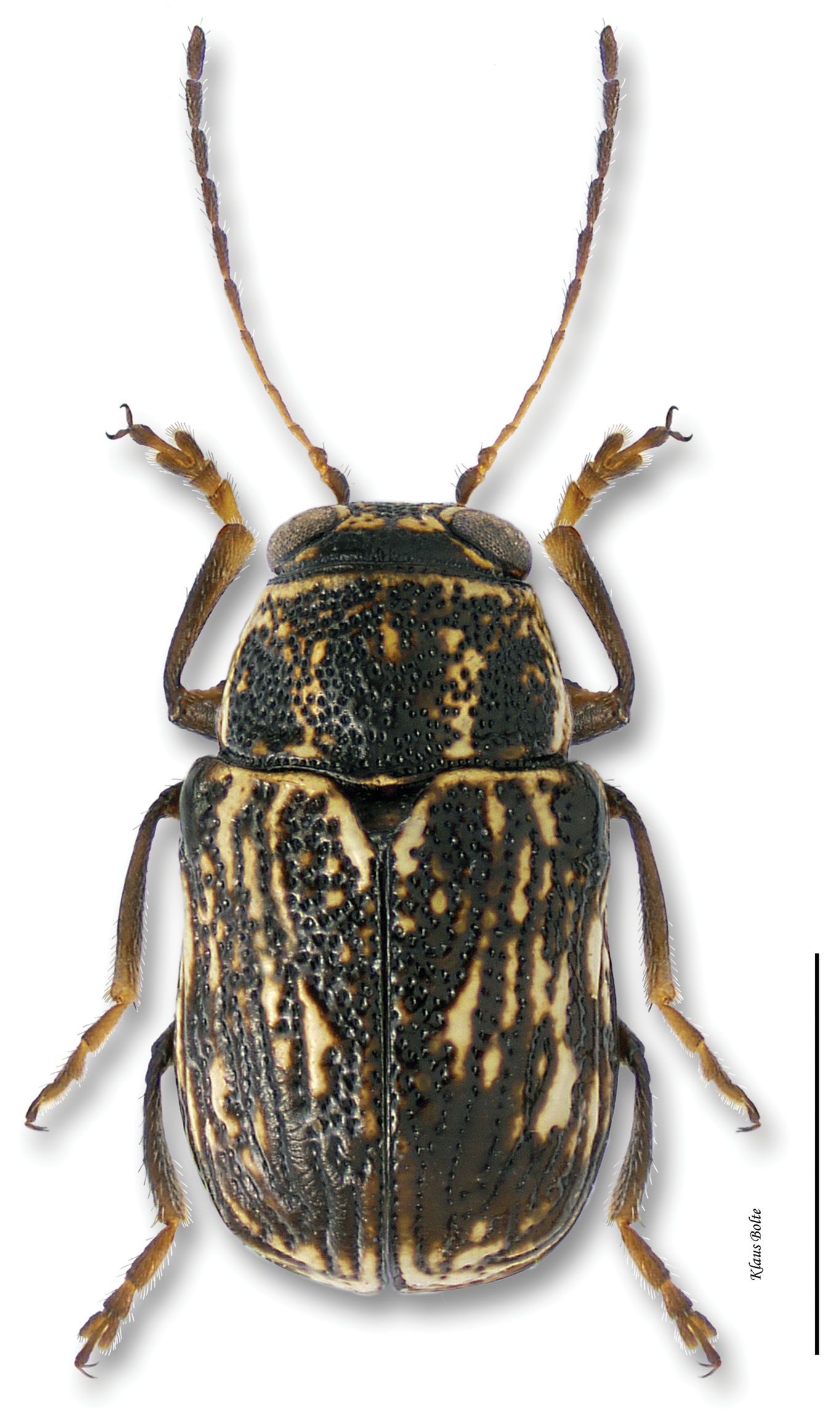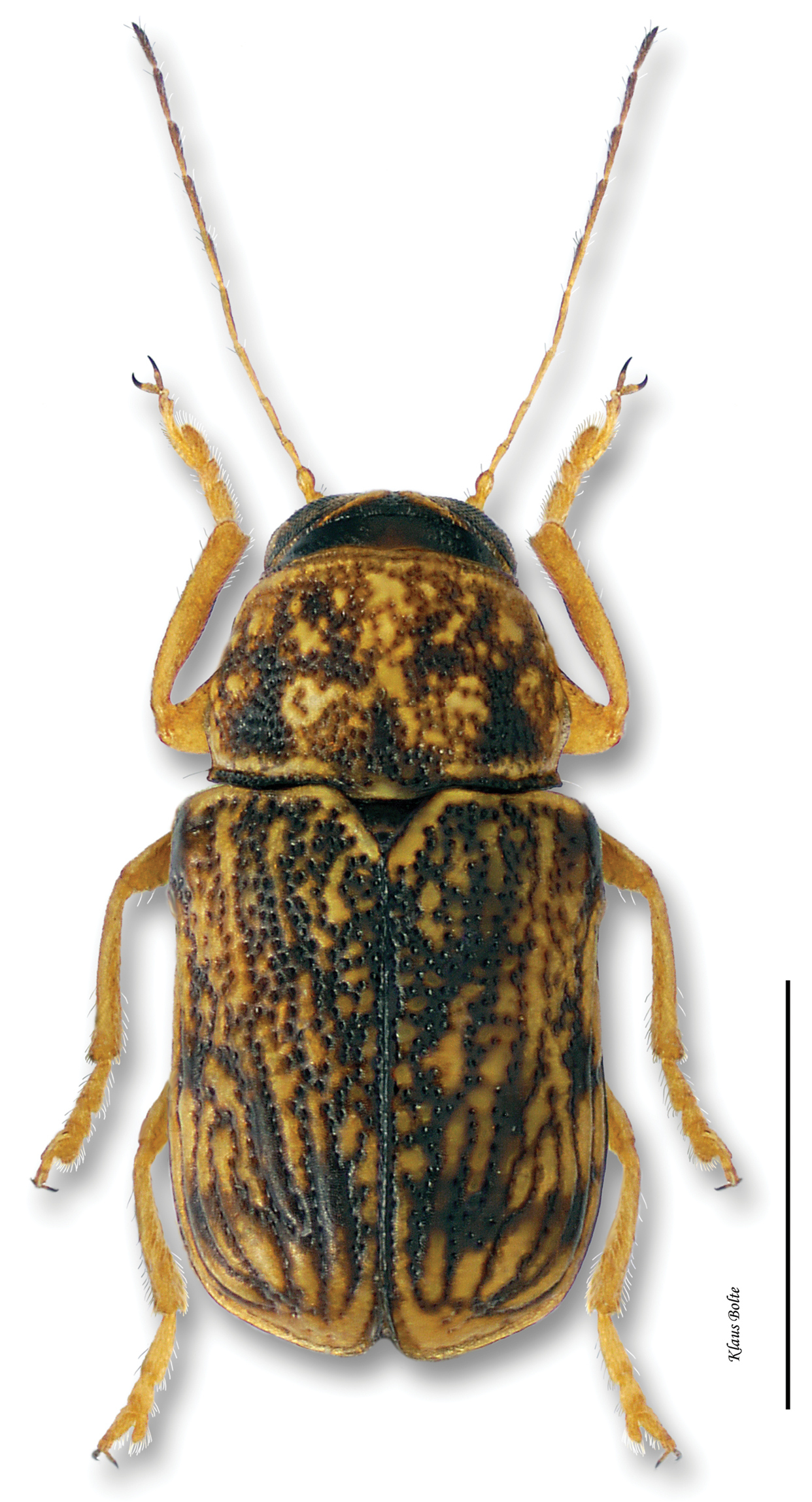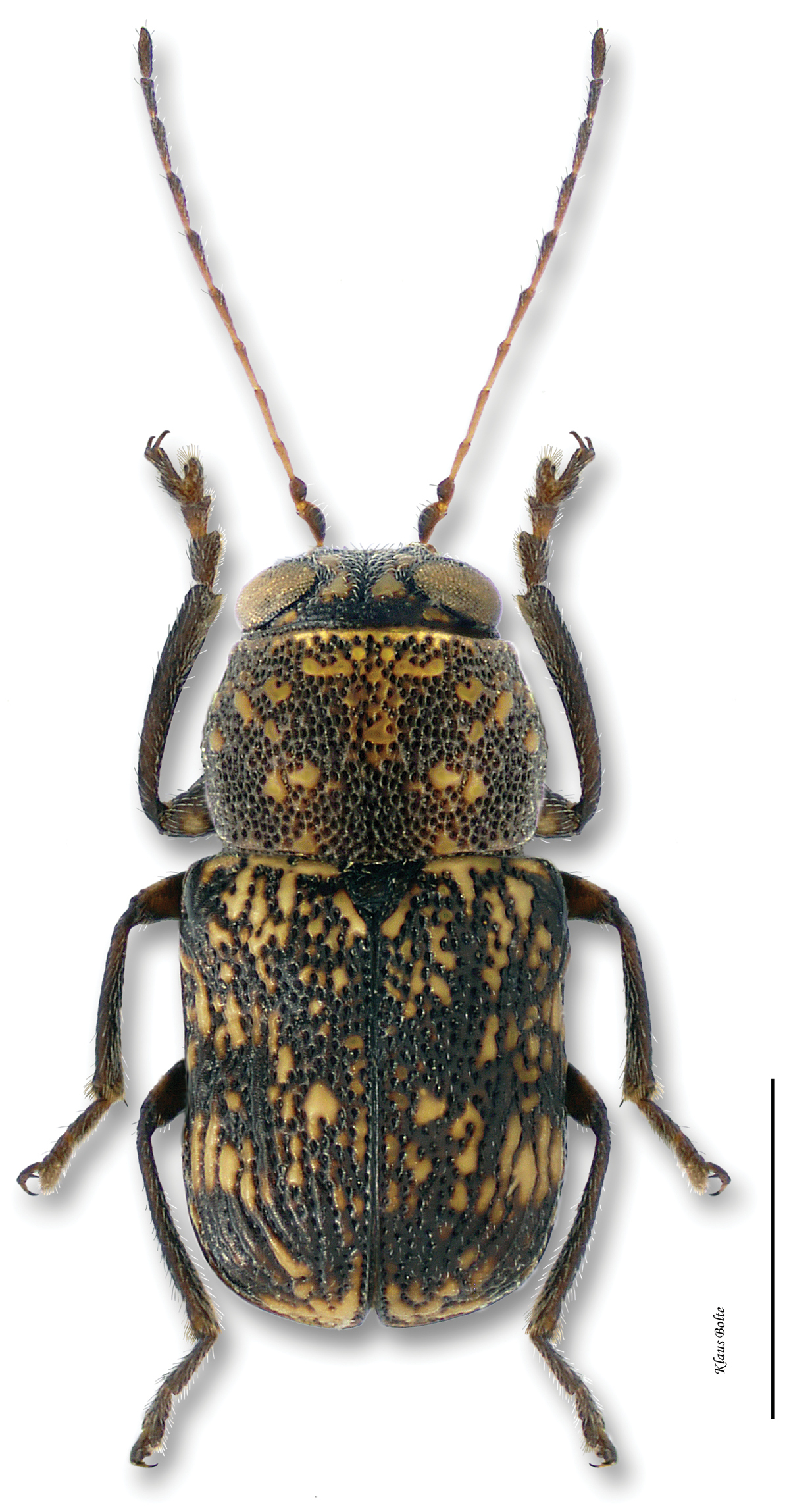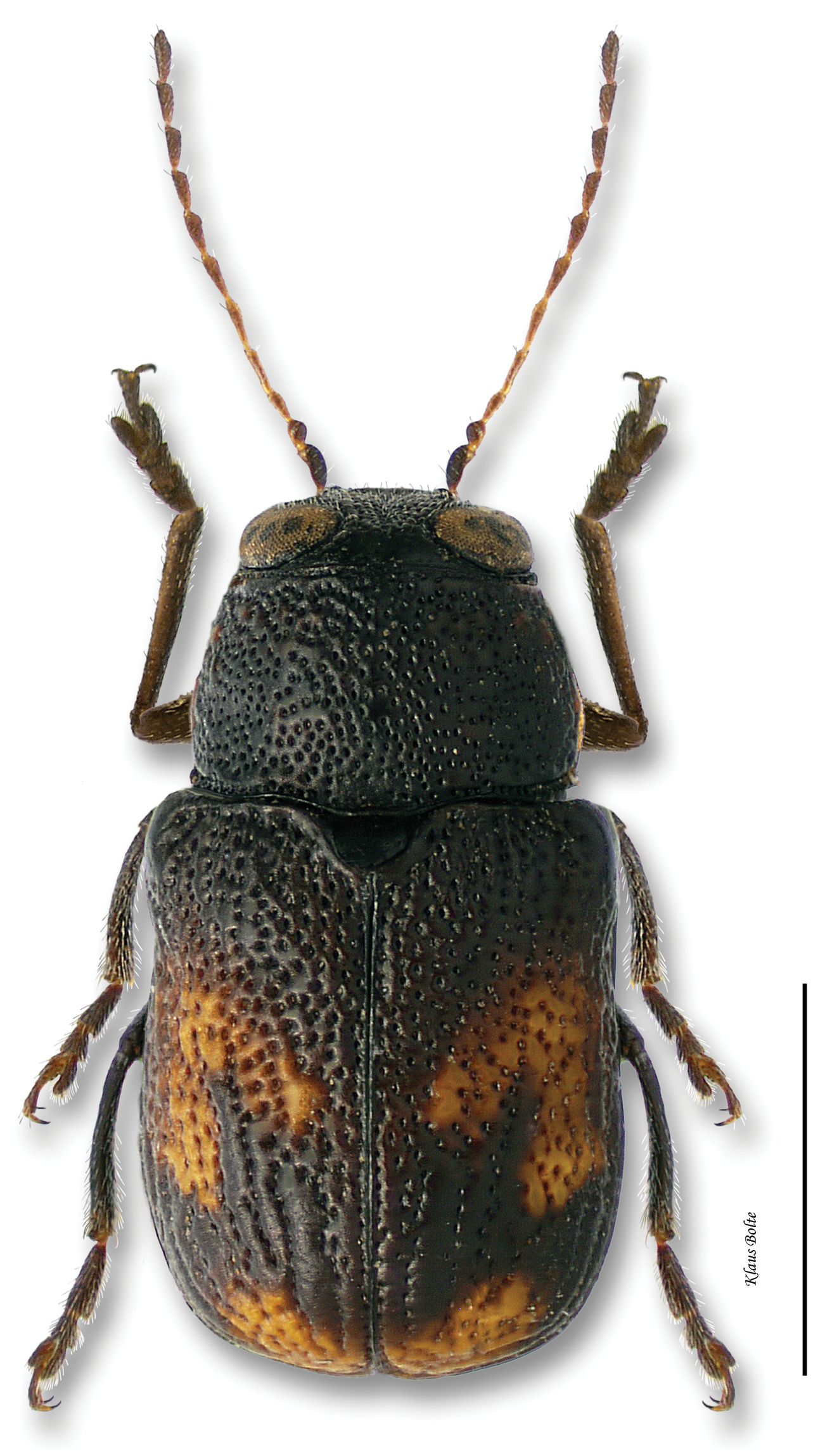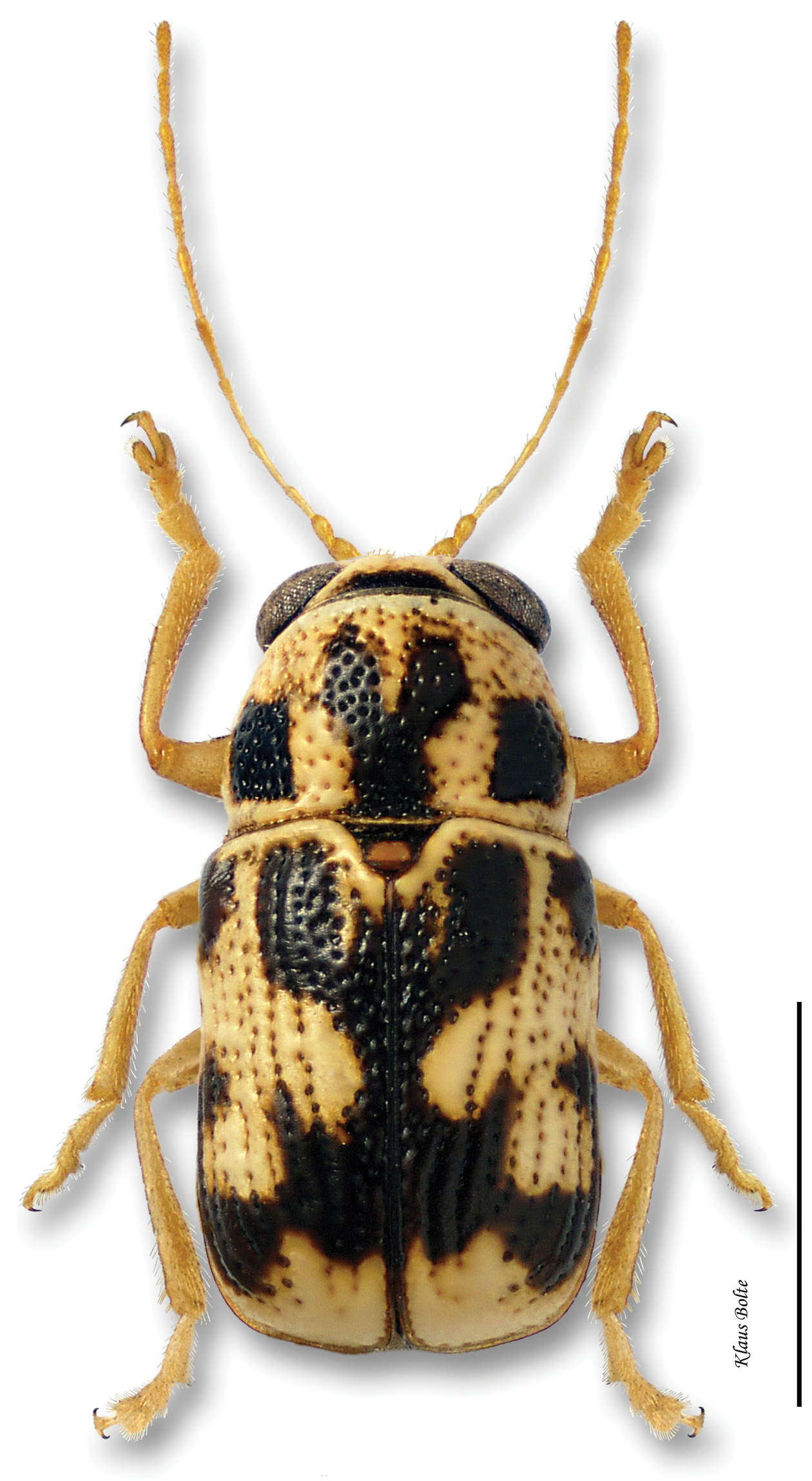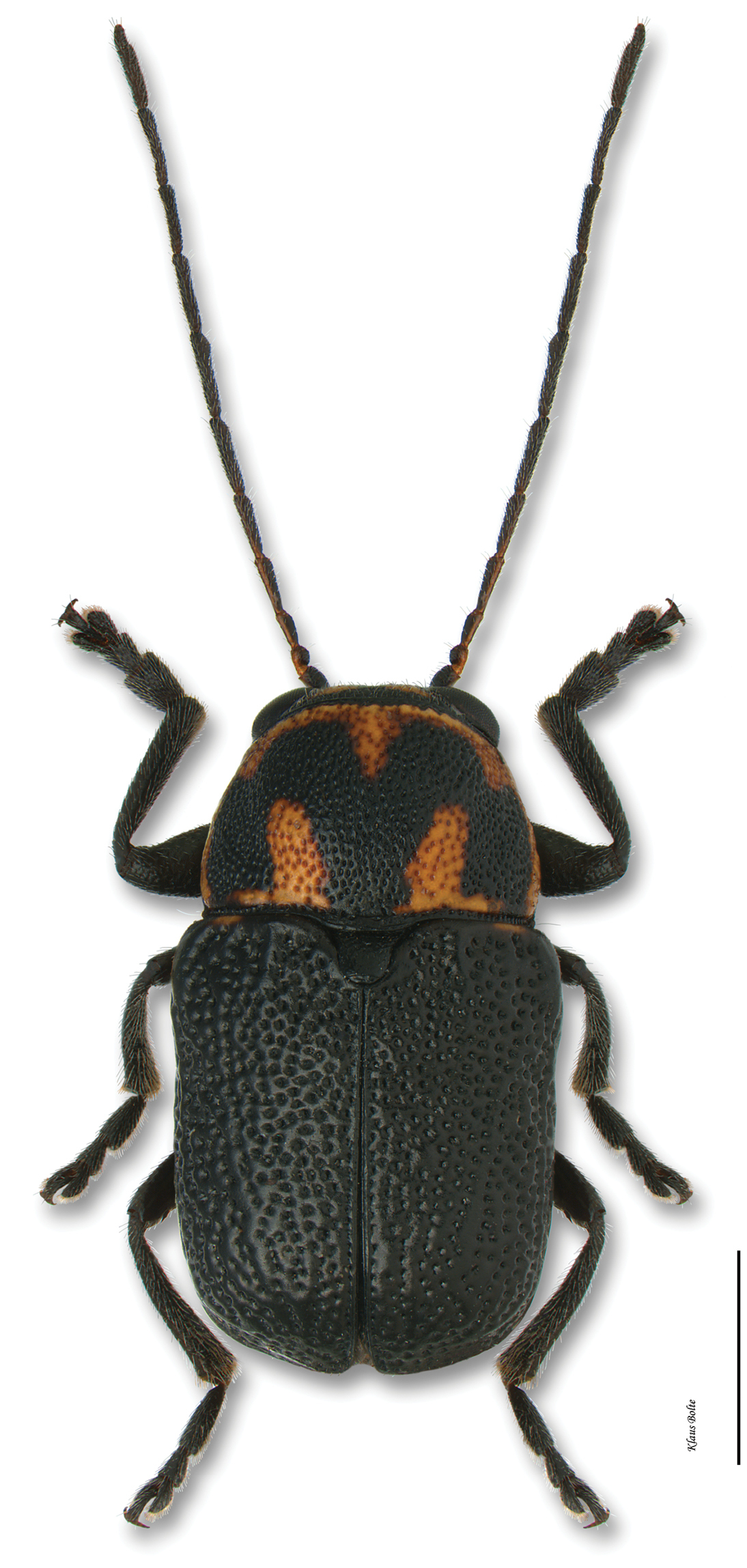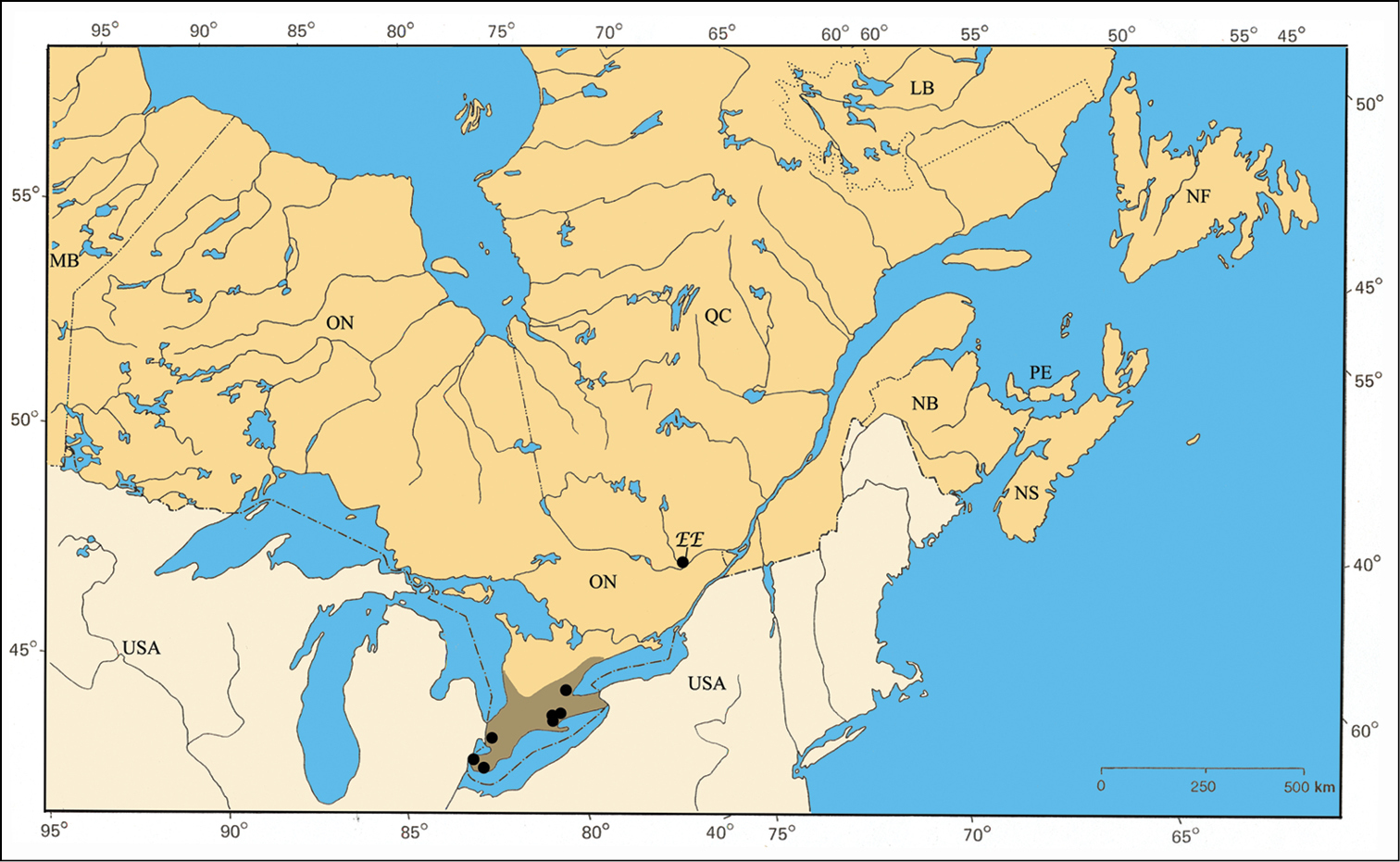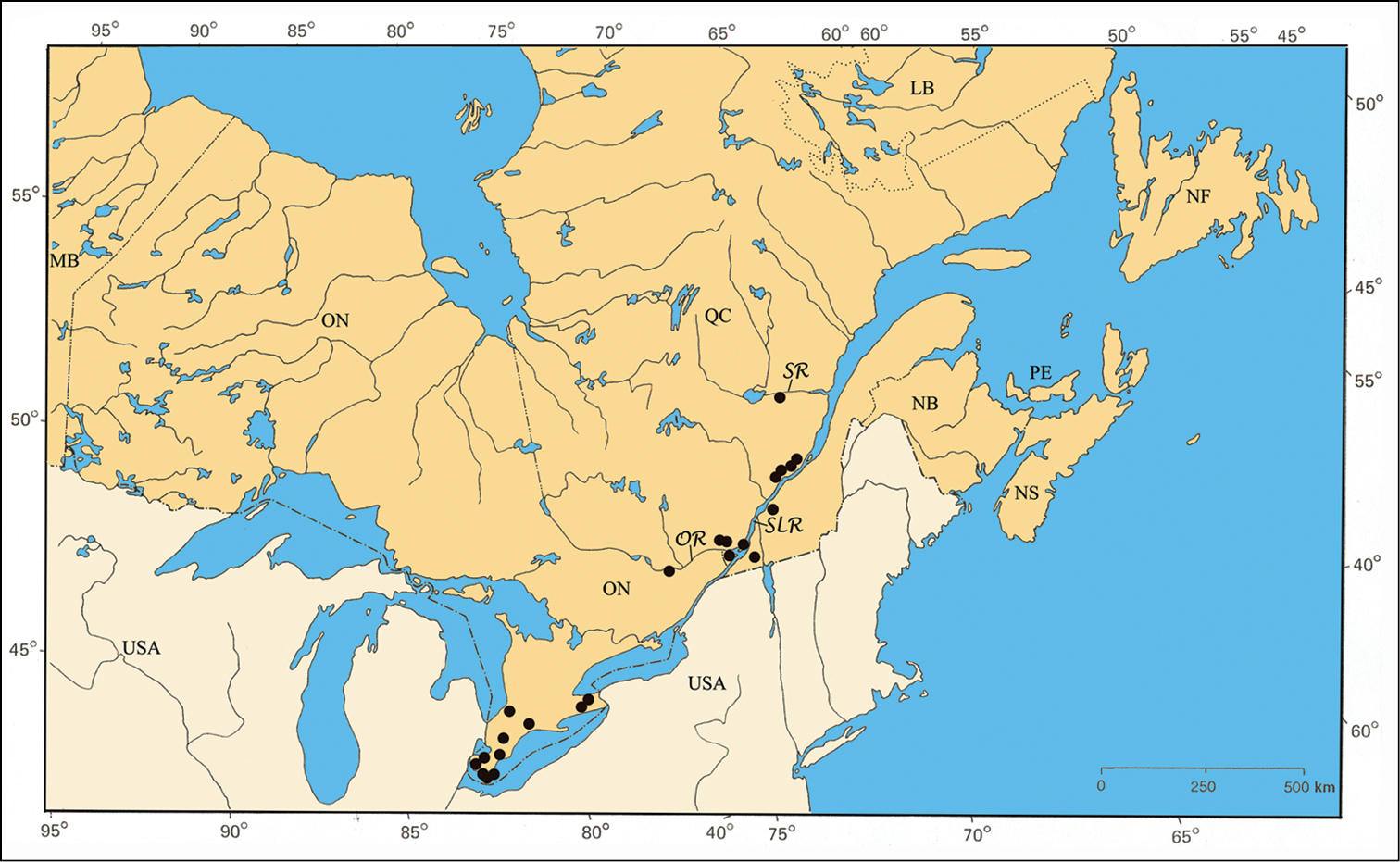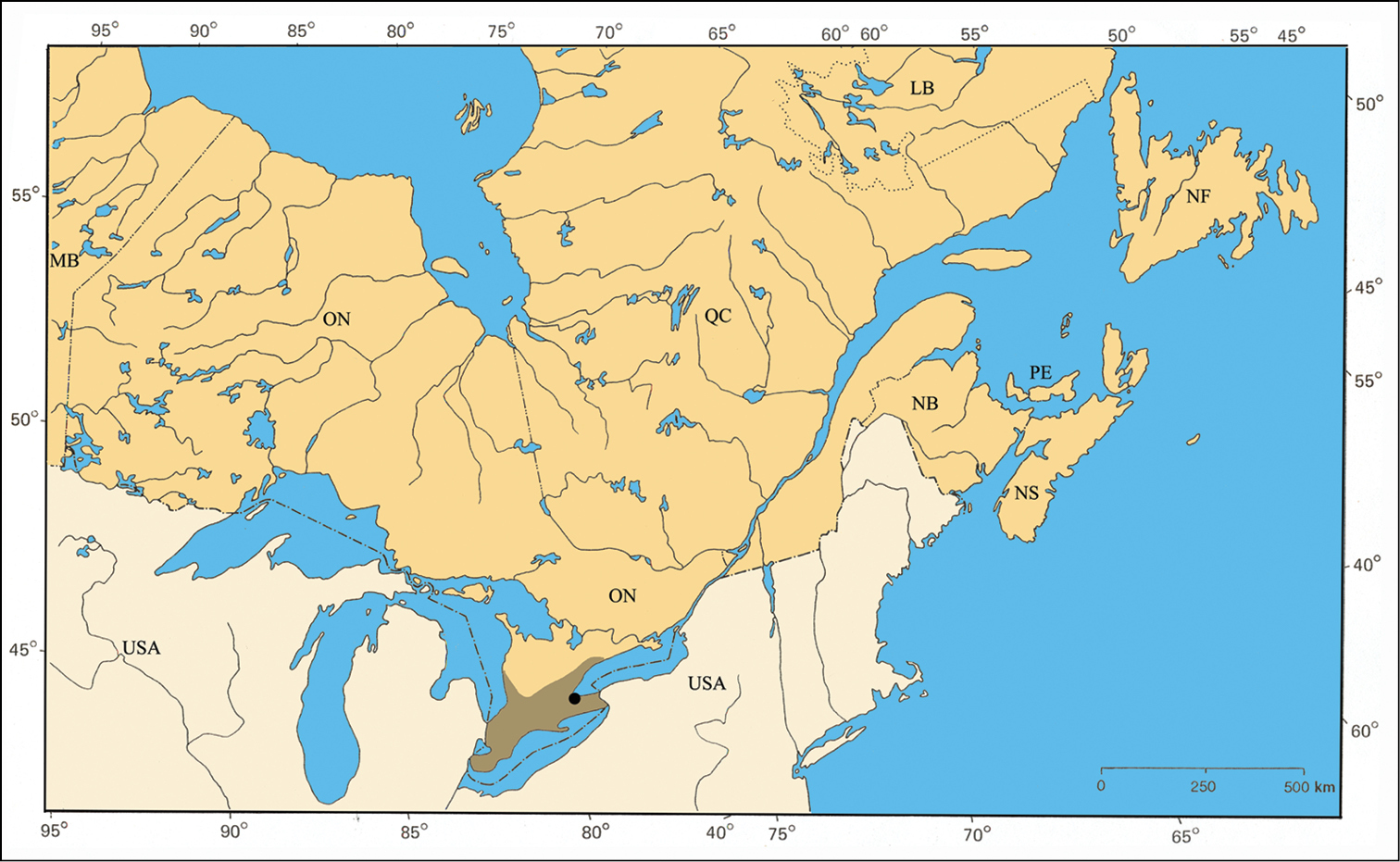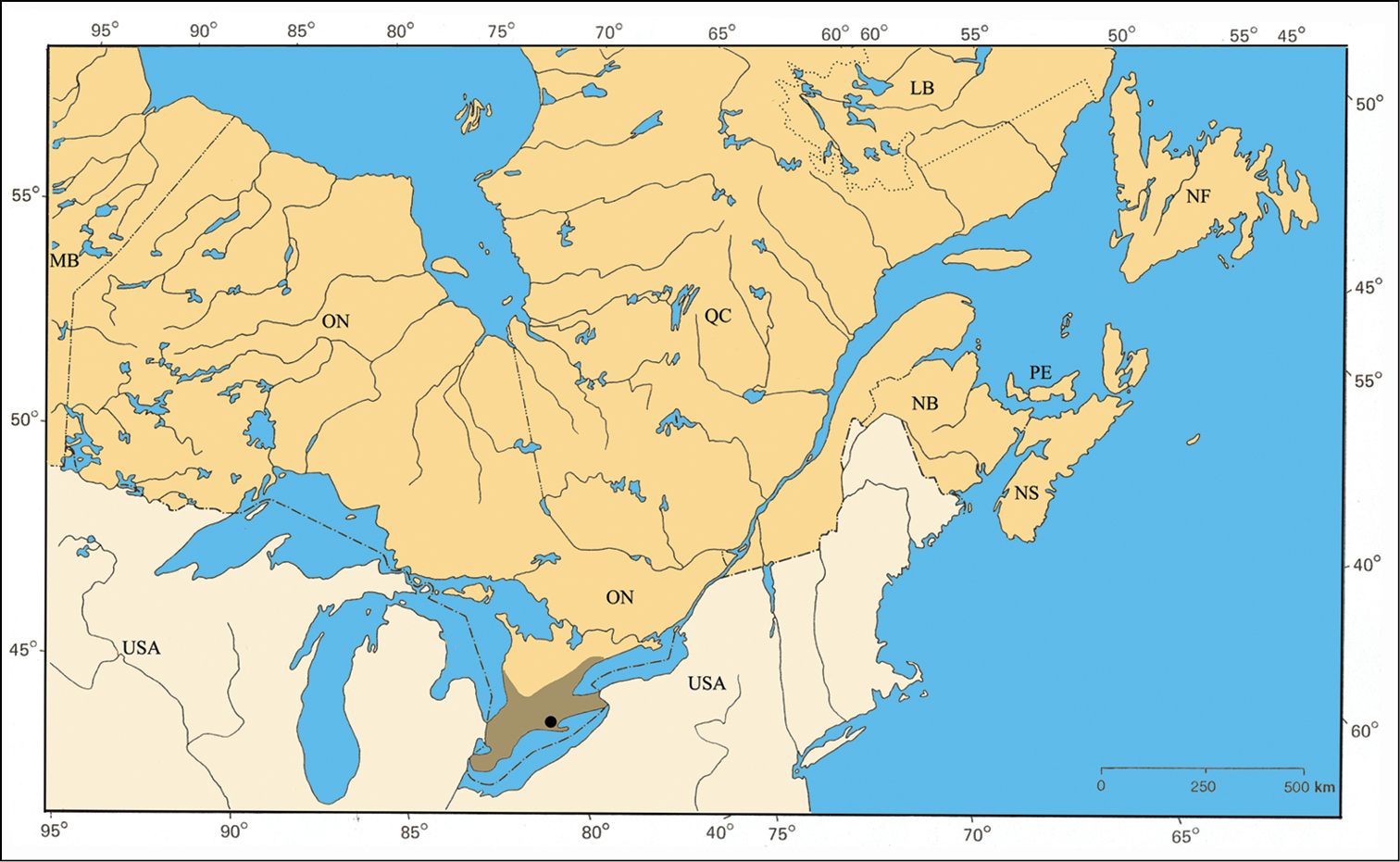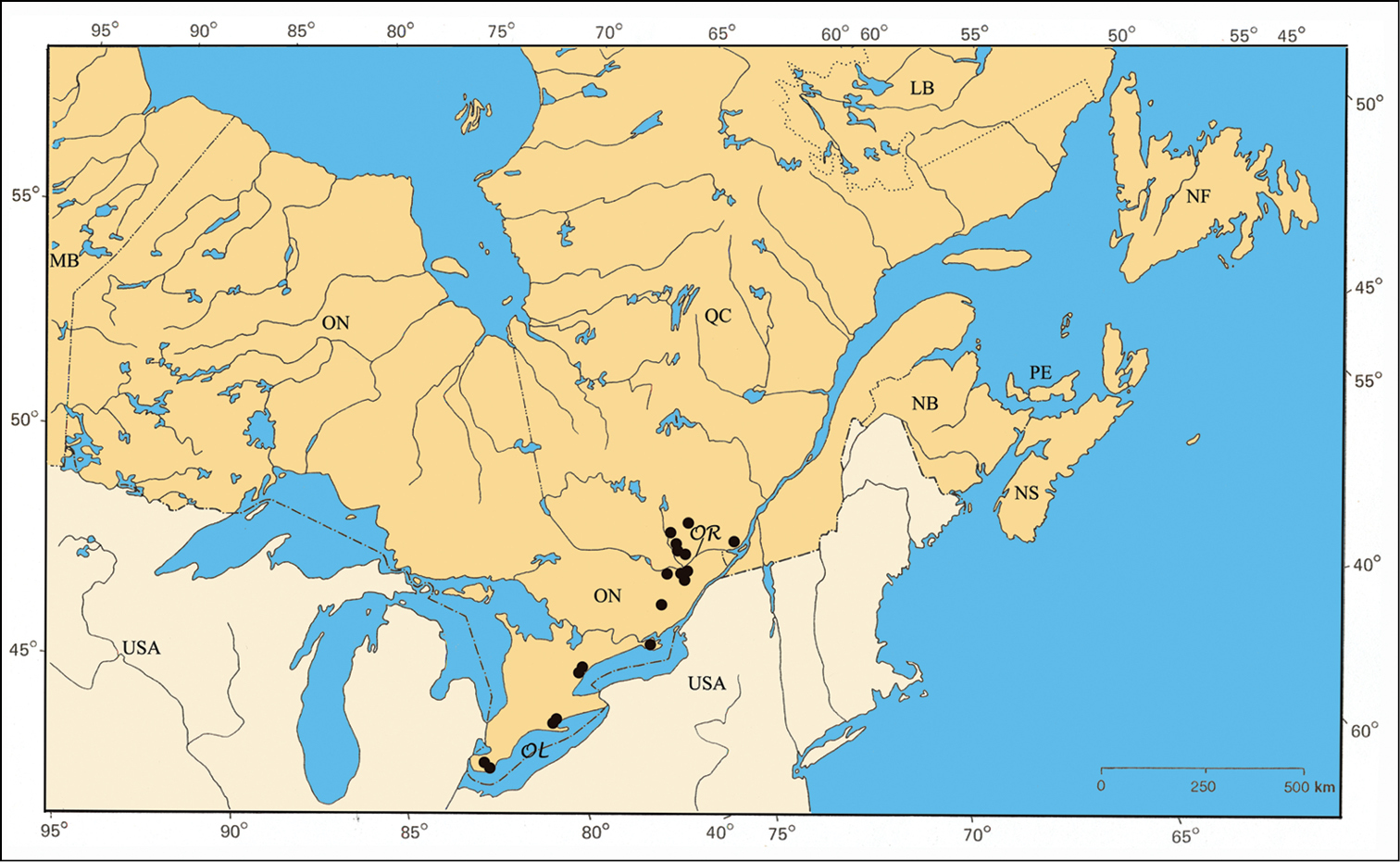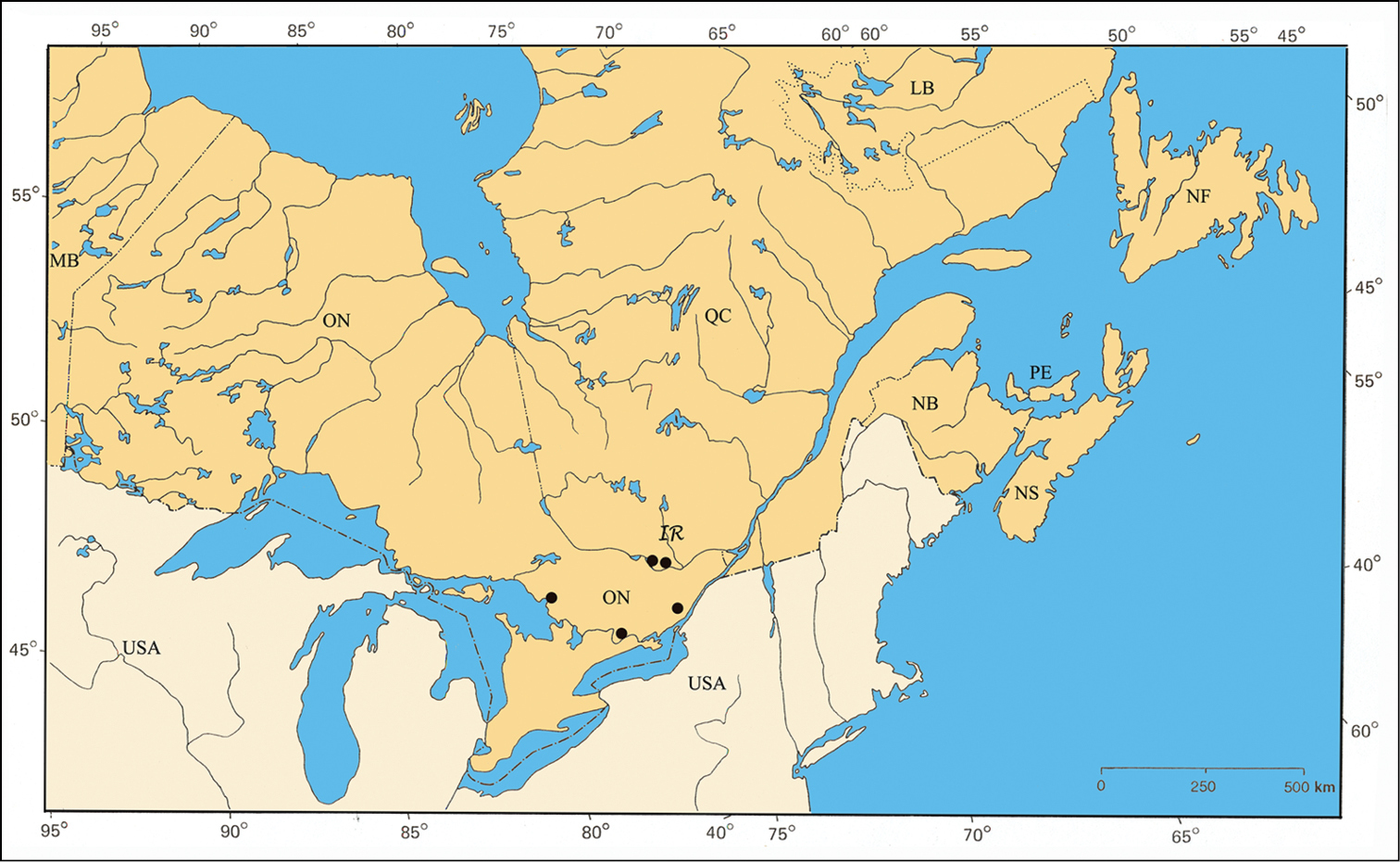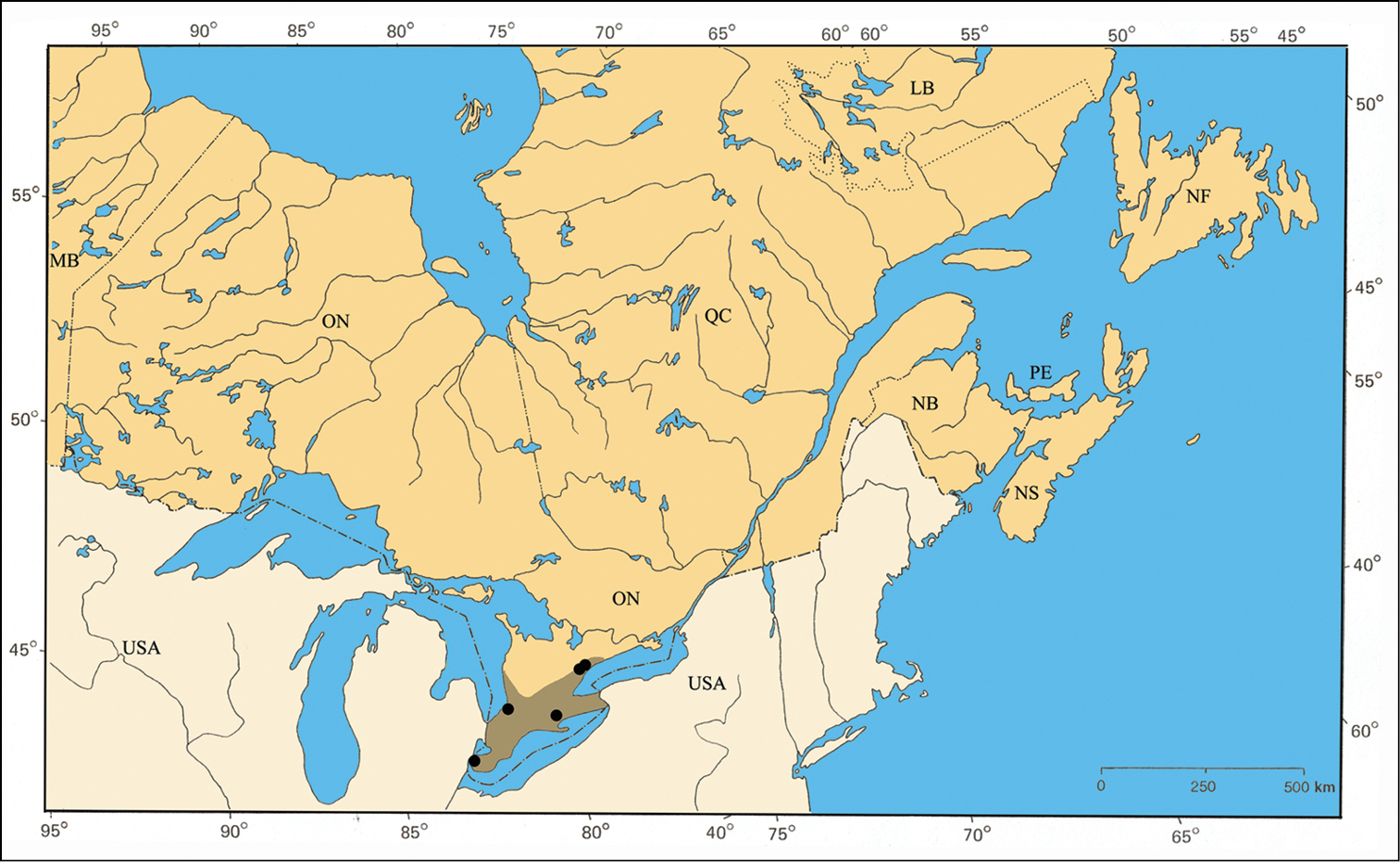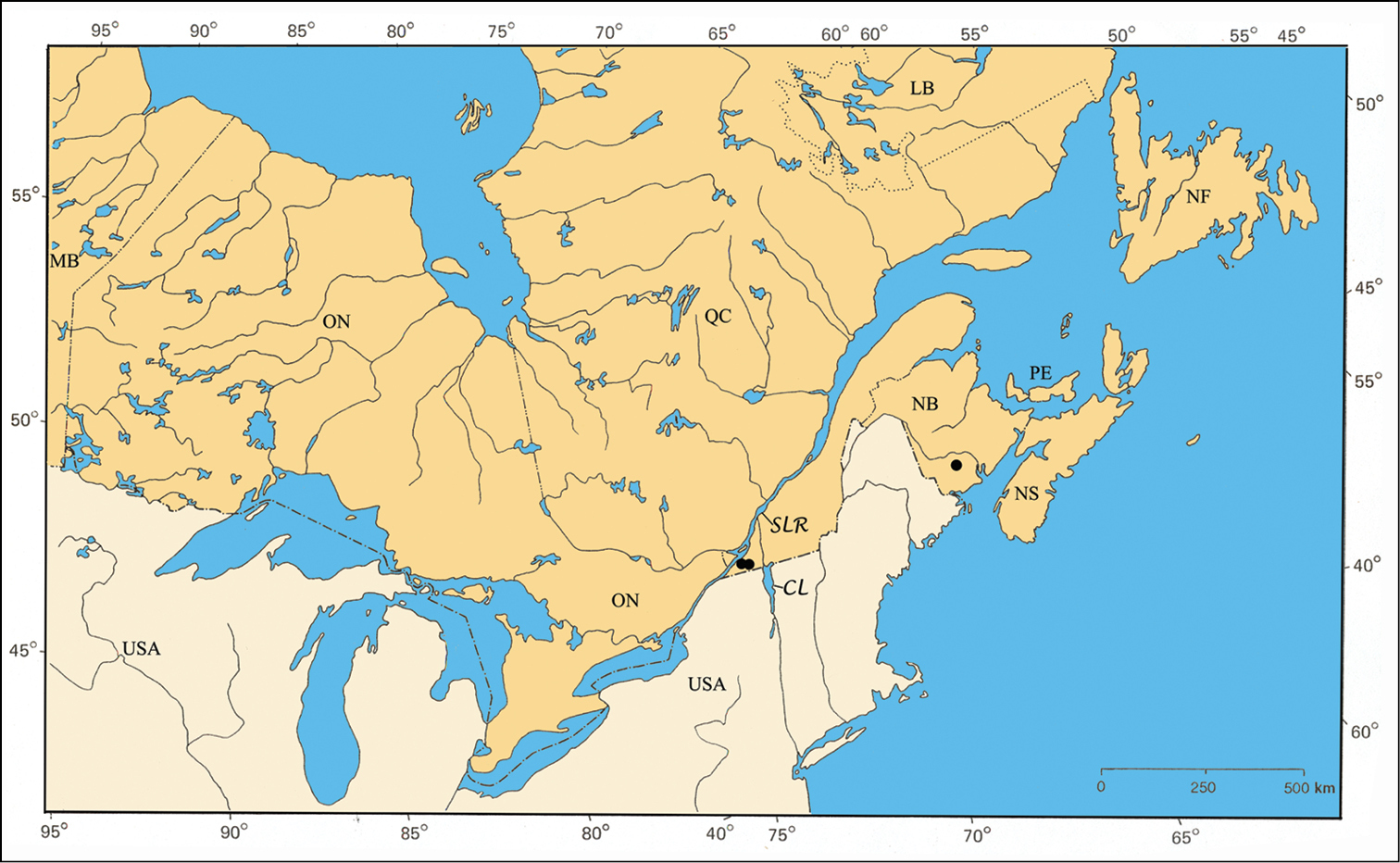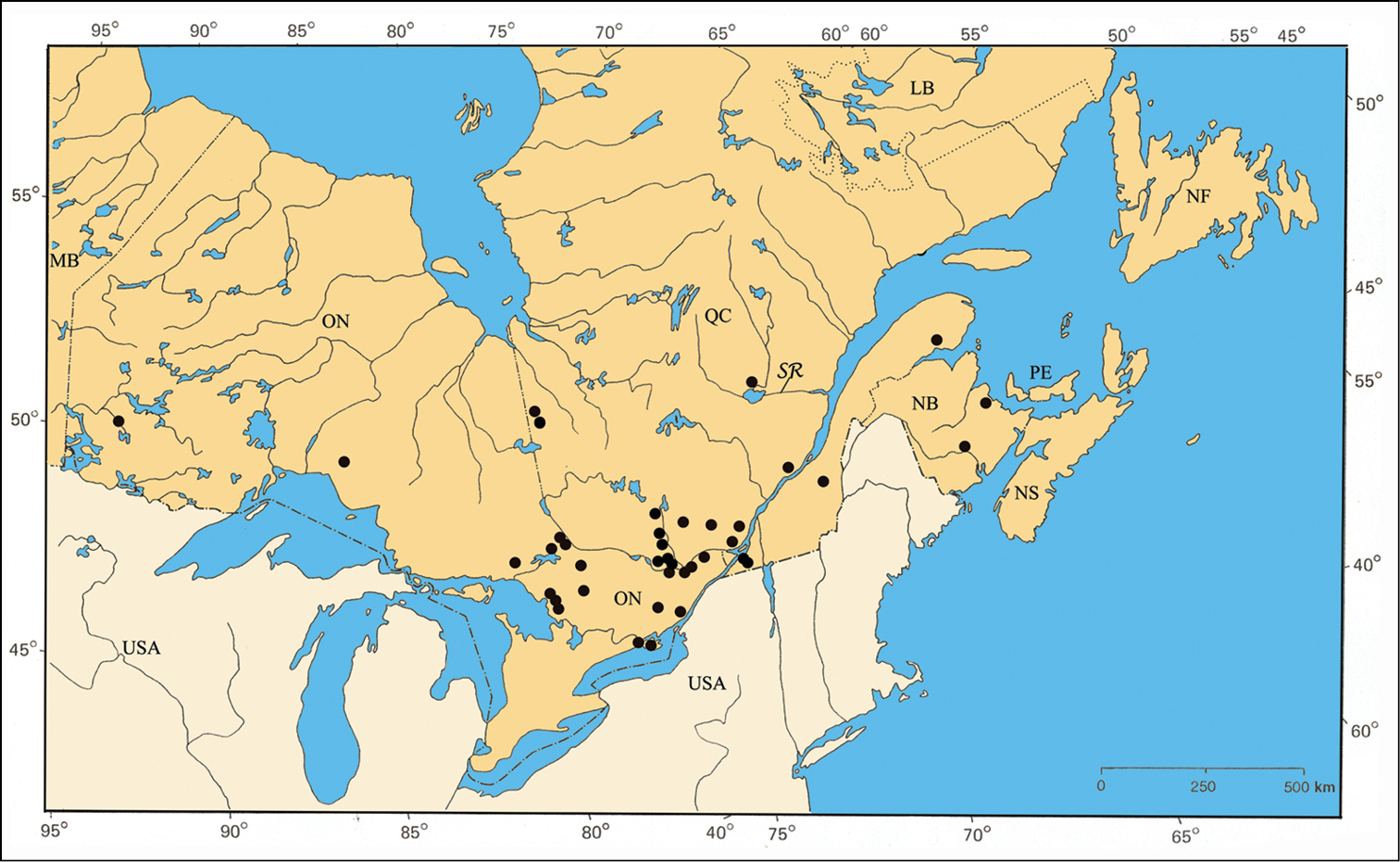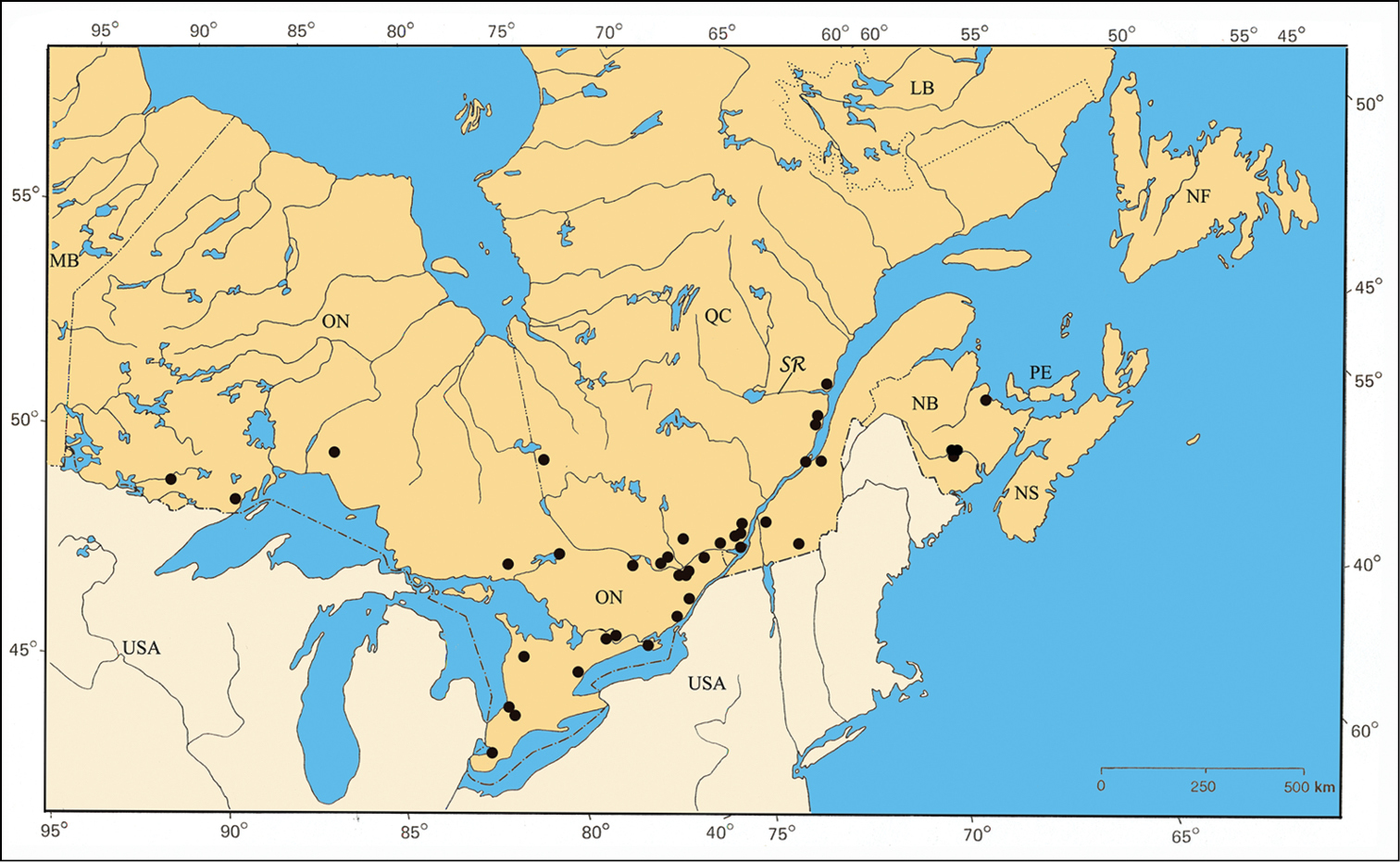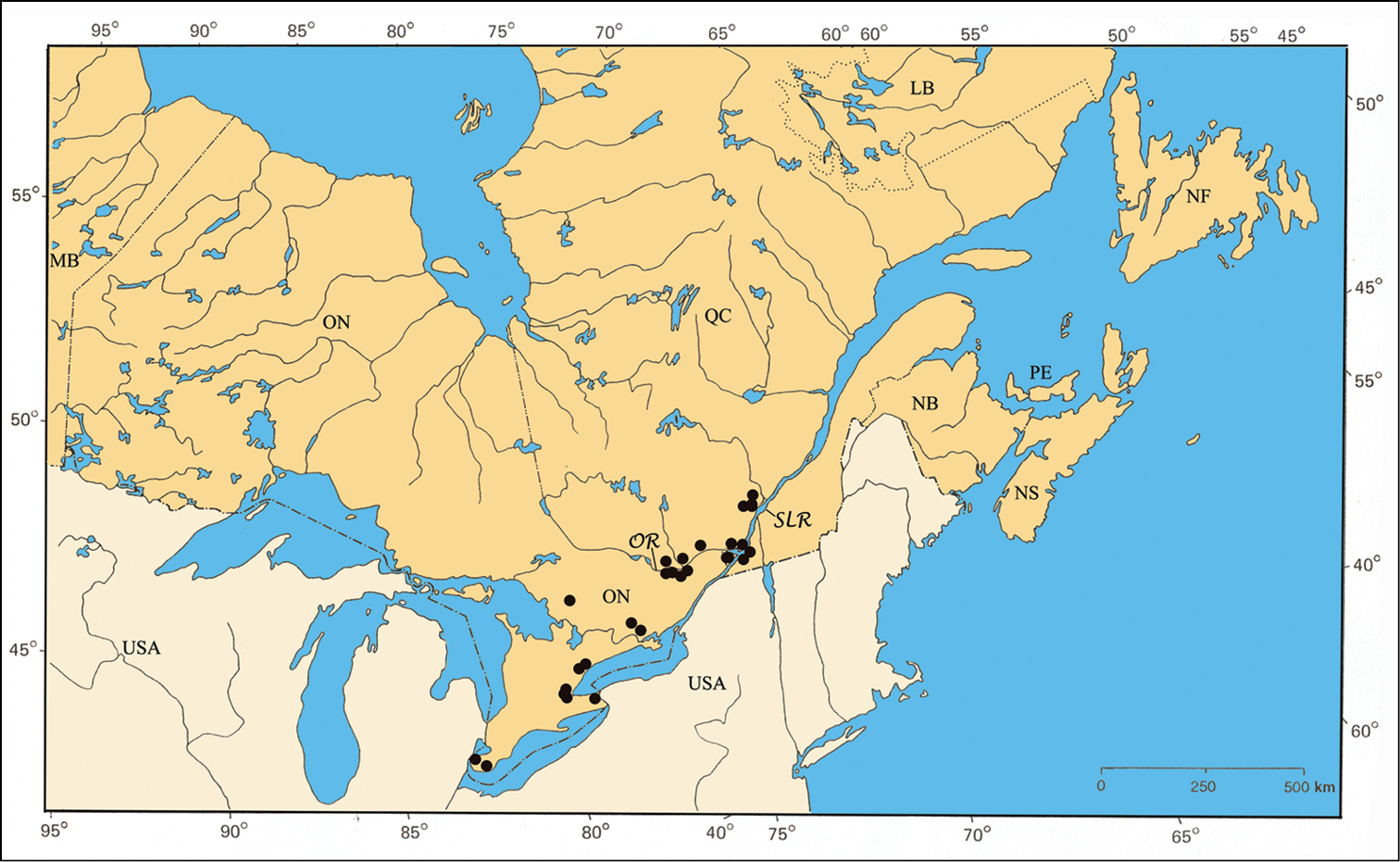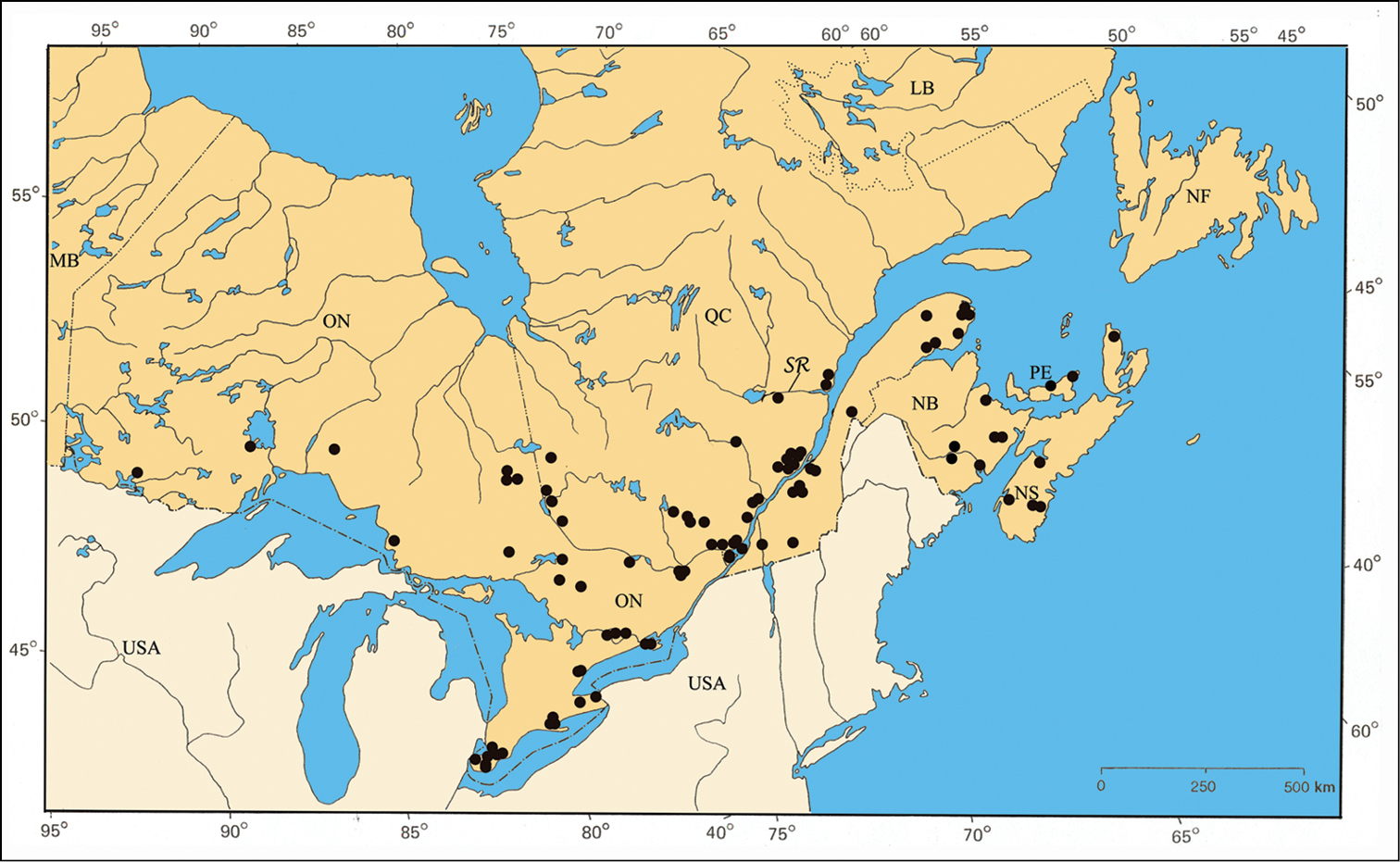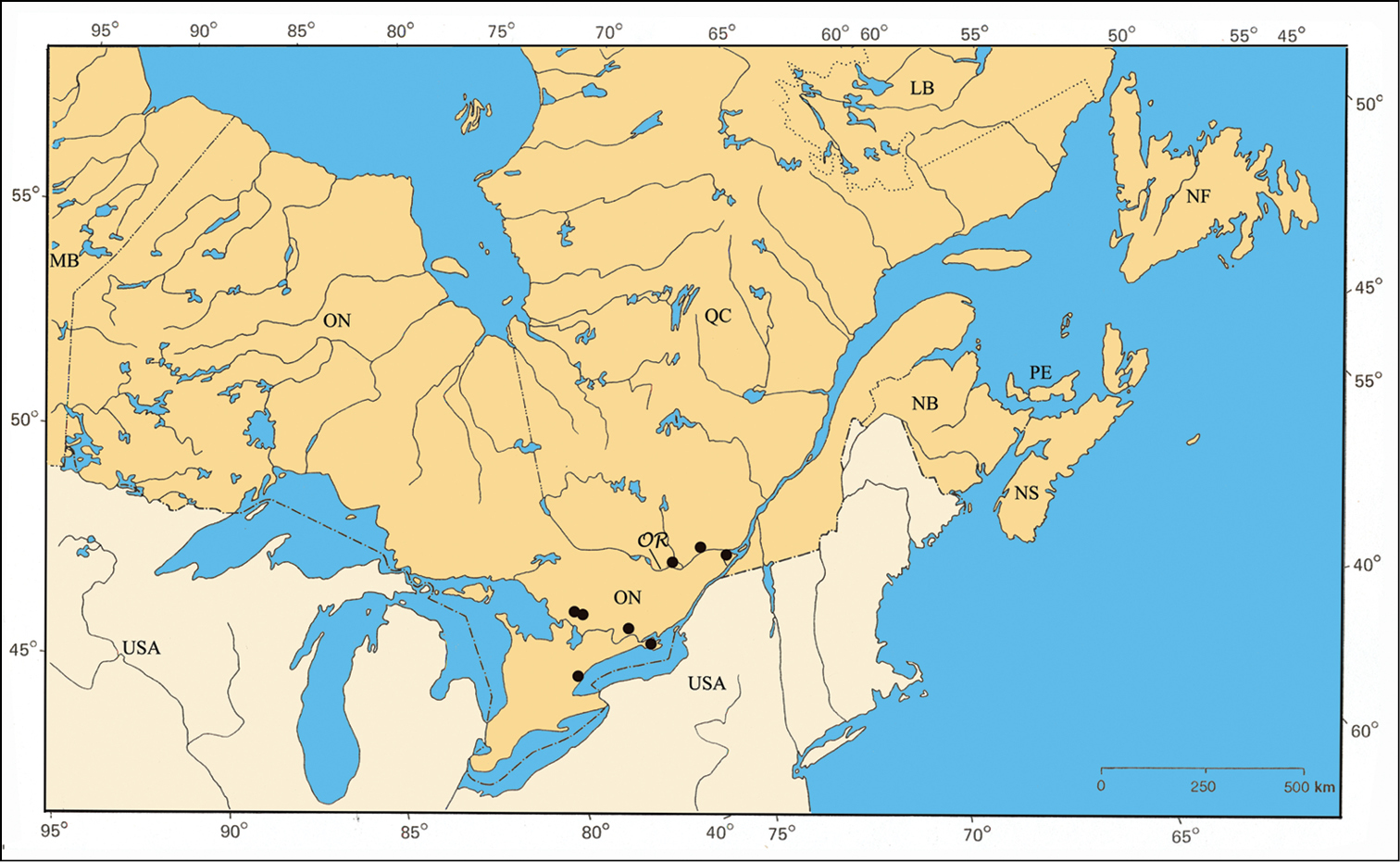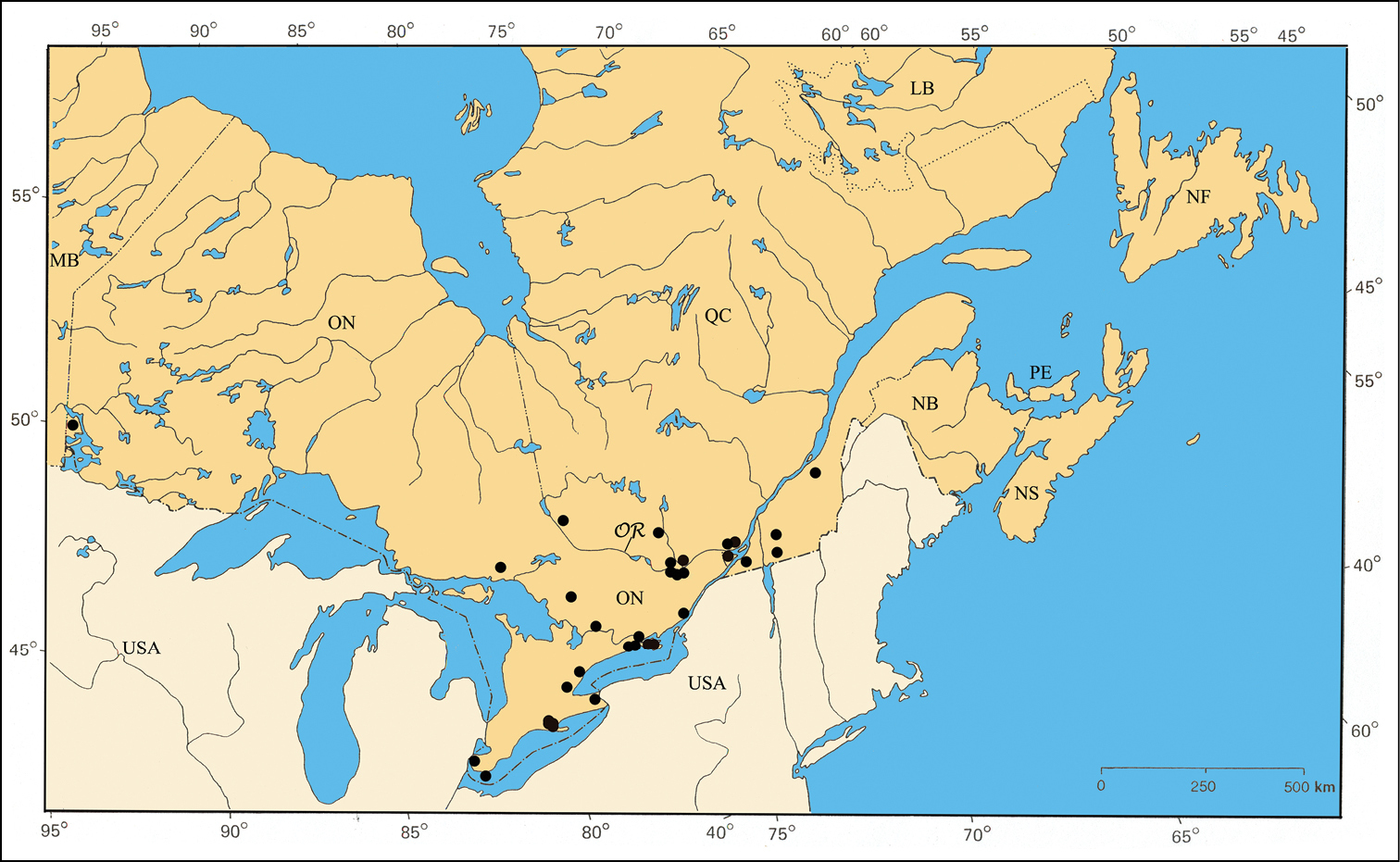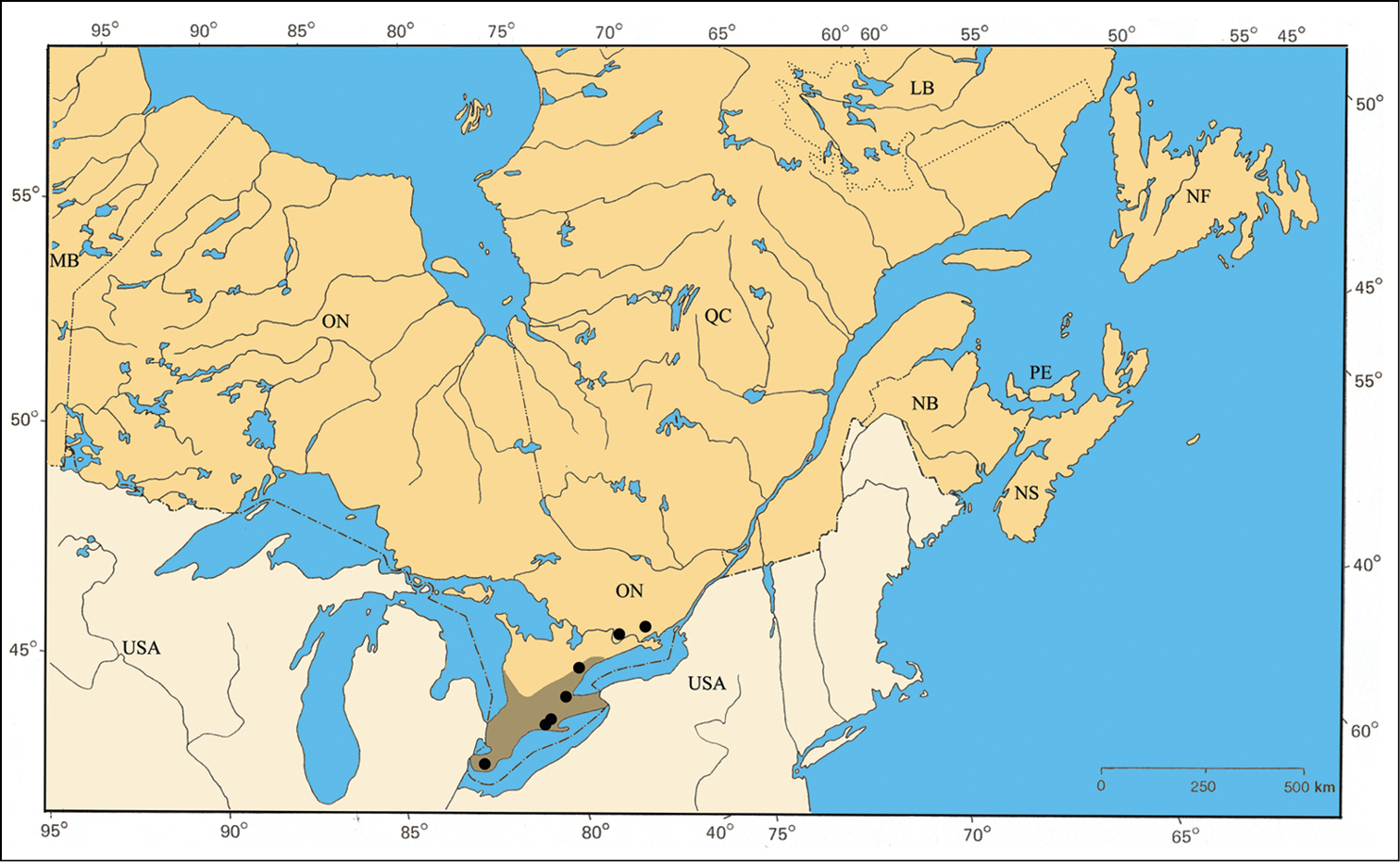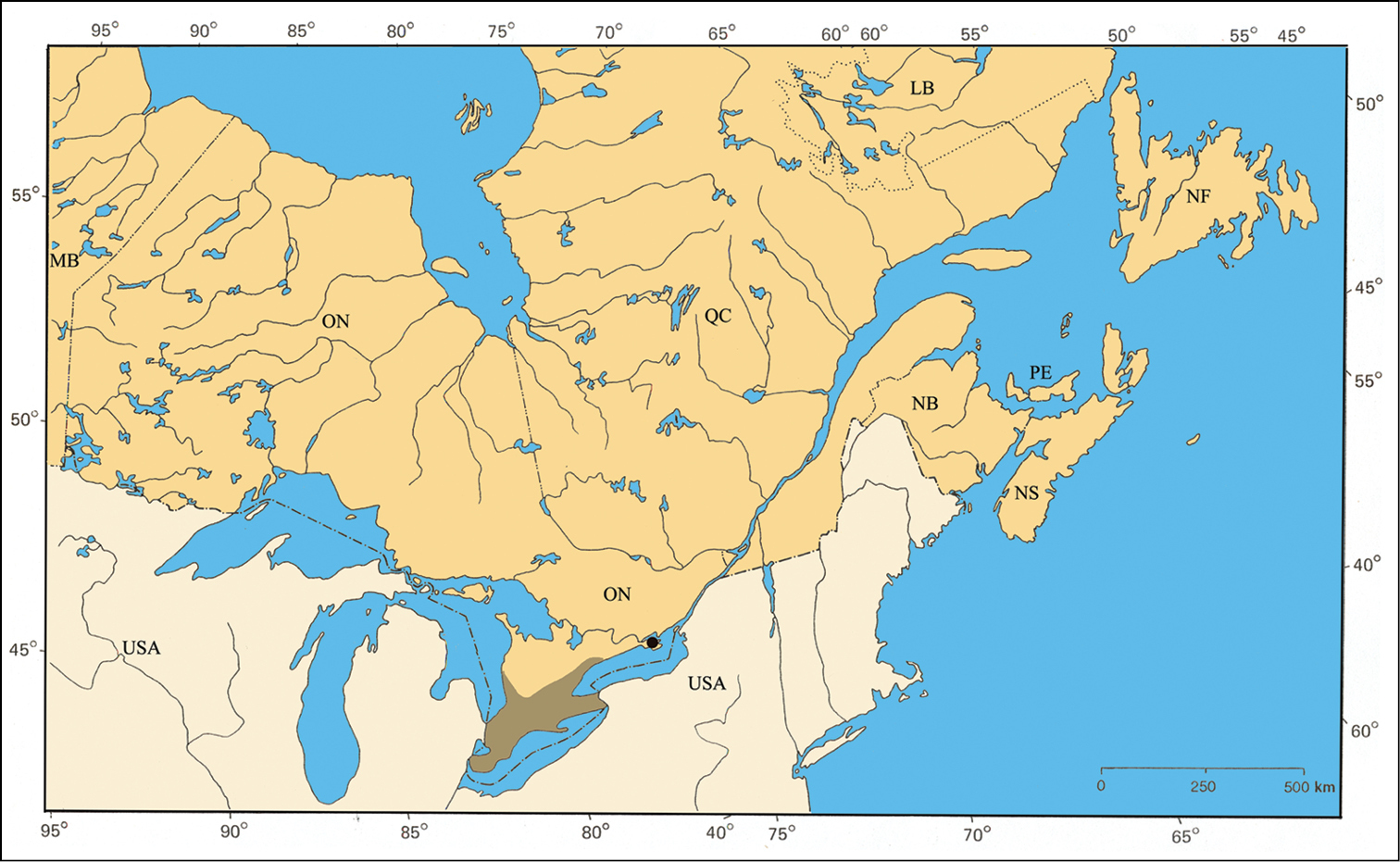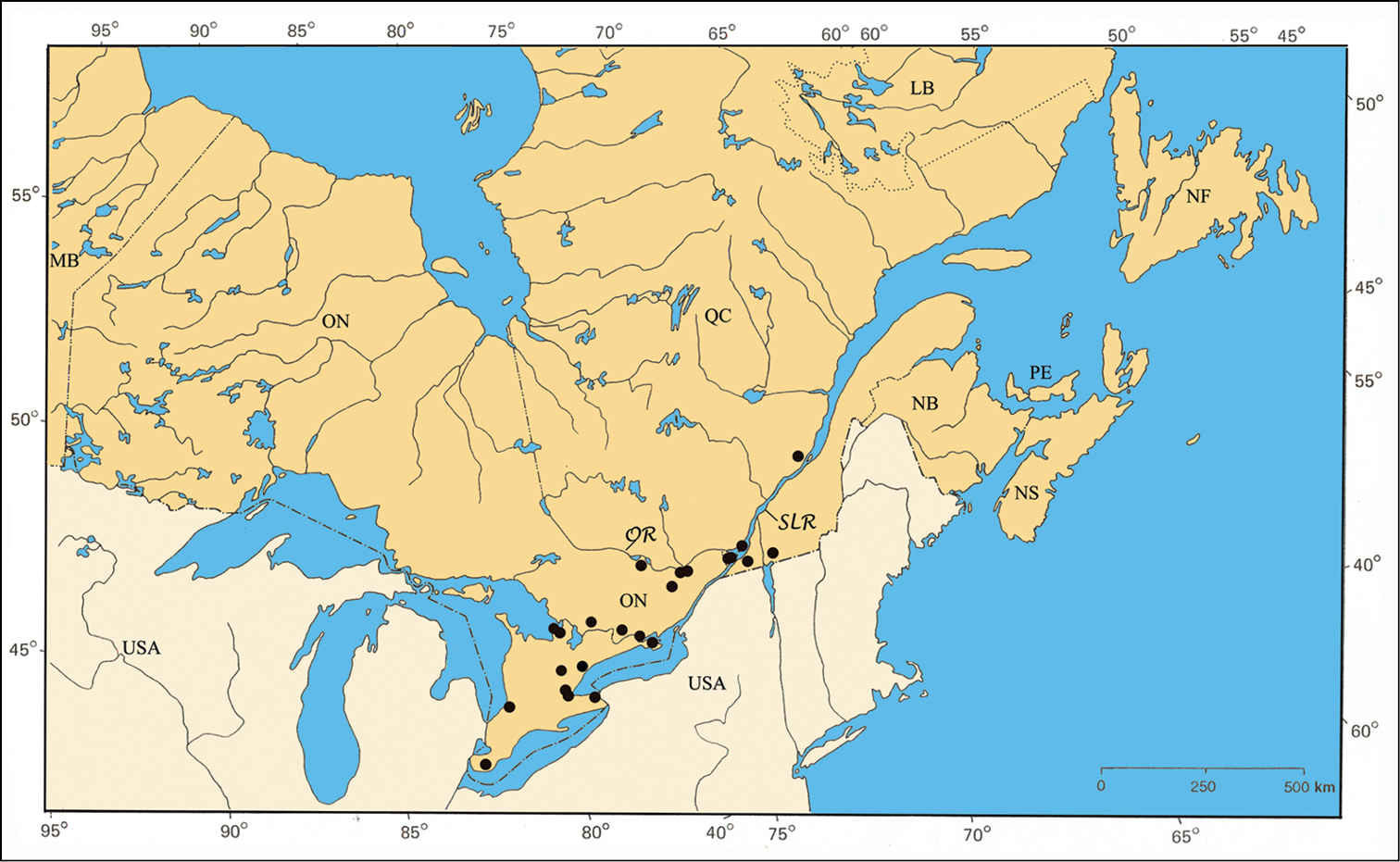






(C) 2013 Robert J. Barney. This is an open access article distributed under the terms of the Creative Commons Attribution License 3.0 (CC-BY), which permits unrestricted use, distribution, and reproduction in any medium, provided the original author and source are credited.
For reference, use of the paginated PDF or printed version of this article is recommended.
Citation: Barney RJ, LeSage L, Savard K (2013) Pachybrachis (Coleoptera, Chrysomelidae, Cryptocephalinae) of Eastern Canada. In: Jolivet P, Santiago-Blay J, Schmitt M (Eds) Research on Chrysomelidae 4. ZooKeys 332: 95–175. doi: 10.3897/zookeys.332.4753
Seventeen Pachybrachis species occurring in eastern Canada [Ontario (ON), Québec (QC), New Brunswick (NB), Nova Scotia (NS), and Prince Edward Island (PE)] are treated by the authors. Two new national records were discovered, both from southernmost Ontario: P. cephalicus Fall and P. luctuosus Suffrian. Four species were new provincial records: P. cephalicus (ON), P. luctuosus (ON, QC), P. obsoletus Suffrian (NB), P. peccans (PE). A fully illustrated key to the Pachybrachis of eastern Canada is provided and supported with extensive photographs, distribution maps, and plant associations.
Three species were distributed from southern Ontario into at least one province in the Maritimes (P. nigricornis (Say), P. obsoletus Suffrianand P. peccans Suffrian). Six species were distributed along the shores of the Great Lakes (Erie, Michigan, and Ontario) and rivers (Ottawa, Saguenay and St. Lawrence), but unknown from central and northern ON and QC (P. bivittatus (Say), P. hepaticus hepaticus (F. E. Melsheimer), P. othonus othonus (Say), P. pectoralis (F. E. Melsheimer), P. spumarius Suffrianand P. trinotatus (F. E. Melsheimer)). Seven species were rare, five being found exclusively from southern ON (P. calcaratus Fall, P. cephalicus, P. luridus (Fabricius), P. subfasciatus (J. E. LeConte)and P. tridens (F. E. Melsheimer)), with two having, in addition, a disjunct population in QC (P. atomarius (F. E. Melsheimer)and P. luctuosus). One species was found to be the northern most extension of an eastern United States (US) distribution into the eastern townships of QC (P. m-nigrum (F. E. Melsheimer)). There were no Pachybrachis that could be considered arctic, subarctic, or boreal species; no specimens were found from Labrador and Newfoundland, and all species had southern affinities. Pachybrachis atomarius, P. calcaratus, P. luridus, P. subfaciatus, and P. tridens, not seen over the last 30–70 years, may be extirpated from eastern Canada.
Les auteurs traitent des 17 espèces de Pachybrachis présentes dans l’est du Canada [Ontario (ON), Québec (QC), Nouveau-Brunswick (NB), Nouvelle-Écosse (NS), Île-du-Prince-Édouard (PE)]. Deux espèces en provenance de l’extrême sud de l’Ontario sont nouvelles pour le pays: P. cephalicus Fall et P. luctuosus Suffrian. Quatre espèces représentent de nouvelles mentions provinciales: P. cephalicus (ON), P. luctuosus (ON, QC), P. obsoletus Suffrian (NB) et P. peccans (PE). La clé d’identification des espèces de l’est du Canada s’appuie sur de nombreuses illustrations en plus d’inclure des cartes de répartition et les associations avec les plantes.
Trois espèces se répartissent du sud de l’ON jusqu’à au moins l’une ou l’autre des provinces Maritimes (P. nigricornis (Say), P. obsoletus Suffrianet P. peccans Suffrian). Six espèces sont limitées aux rives des Grands-Lacs (Érié, Michigan et Ontario), du fleuve Saint-Laurent et des grandes rivières (des Outaouais, Saguenay) sans atteindre le centre et le nord de l’ON et du QC (P. bivittatus (Say), P. hepaticus (F. E. Melsheimer), P. othonus (Say), P. pectoralis (F. E. Melsheimer), P. spumarius Suffrianet P. trinotatus (F. E. Melsheimer)). Cinq, parmi les sept espèces rares, proviennent exclusivement du sud de l’ON (P. calcaratus, P. cephalicus, P. luridus (Fabricius), P. subfasciatus (J. E. LeConte) et P. tridens (F. E. Melsheimer)), alors que les deux autres possèdent, en outre, une population disjointe au QC (P. atomarius et P. luctuosus). Une espèce, présente seulement en Estrie (QC), se trouve à la limite septentrionale de sa répartition dans l’est des États-Unis (P. m-nigrum (F. E. Melsheimer)). Aucune espèce, parmi les Pachybrachis étudiés, n’est arctique, subarctique ou boréale, mais toutes présentent des affinités méridionales. Aucun spécimen en provenance de Terre-Neuve et du Labrador n’a été observé. Les espèces Pachybrachis atomarius, P. calcaratus, P. luridus, P. subfaciatus et P. tridens n’ont pas été vues depuis les 30–70 dernières années de sorte qu’elles sont probablement disparues de la faune de l’Est du Canada.
Coleoptera, Chrysomelidae, Pachybrachis, eastern Canada, taxonomy
In the Catalog of Leaf Beetles of America North of Mexico
When
Thomas
The same year, John Eatton
The beetles collected by the Swiss scientist Louis Agassiz and the Italian explorer John Cabot during the exploration of several regions of Lake Superior (ON) were studied and identified by
The German entomologist Christian Wilhelm Ludwig Eduard Suffrian specialized in Coleoptera, especially Chrysomelidae. He described many North American species, including four in Pachybrachis that are found in eastern Canada: Pachybrachis luctuosus, Pachybrachis obsoletus, Pachybrachis peccans, and Pachybrachis spumarius (
The Catalogue of the described Coleoptera of the United States (
During the next 50 years, several Canadian collectors explored various areas of Ontario and Québec, but no records show that they were successful in collecting Pachybrachis: William Couper in Toronto (ON) and in various localities in the province of Québec (
Pettit (1868–1872) listed 1290 species in a series of articles on beetles collected at Grimsby (ON), including three Pachybrachis species (Pachybrachis mollis, Pachybrachis subfasciatus, and Pachybrachis tridens). His Pachybrachis mollis is now considered a synonym of Pachybrachis tridens (
The priest Léon
In his list of the Ottawa Coleoptera,
In his report on the insects of the Toronto region (ON),
During the same period,
In the thirties, Chagnon published a series of contributions on the most important beetles of the province of Québec in the journal Le Naturaliste canadien (
The list of Coleoptera collected by
The Checklist of Chrysomelidae of Canada, United States, Mexico, Central America and the West Indies of
Edward G. Riley, Shawn M. Clark, R. Wills Flowers and Arthur J. Gilbert are the authors of the most recent synthesis on American Chrysomelidae (
The Catalogue of the Leaf Beetles of America North of Mexico by
An examination of leaf beetle specimens in the largest beetle collections in Kentucky, inventory work in state nature preserves and other protected areas, and a review of the literature revealed 20 species of Pachybrachis present in Kentucky, 14 of which were new state records (
The latest contribution on the eastern Canadian Pachybrachis is by
For the purposes of this study, eastern Canada is defined as provinces east of Manitoba: Ontario (ON), Québec (QC), New Brunswick (NB), Nova Scotia (NS), Prince Edward Island (PE), Newfoundland (NF) and Labrador (LB). When not given on labels, counties were found using the gazetteer of
For each species of Pachybrachis found in eastern Canada, the following information is provided: name, synonymies, habitus photo, brief description of species recognition characters, distribution and maps, label data, recorded or potential host plants, and comments.
For each specimen examined the following information is provided: province, county/district, date, label information that may include potential host plants, habitat or collection method, collector, number of males and females, and museum. If a specimen had a H. C. Fall identification label or was found in Fall’s personal collection (Fall-MCZ), this information was cited before the museum name. Within a species treatment, data are ordered alphabetically by province, county/district, locale, and then date.
Determination of sex is relatively easy as follows: males (Figure 9a) are generally smaller and less robust than females, with the abdomen flat and more or less concave; in females (Figure 9b) the abdomen is convex beneath, the last segment with a deeply rounded fovea (depression). Singleton females of many species cannot be confidently identified without associated males for dissection.
Ten males (when available) of each species were measured using a Leica Z16 APO microscope equipped with a DFC295 digital color camera and Leica Application Suite software.
There are many species of Pachybrachis in the eastern US and Canada that could only be confidently separated and identified via examination of the male reproductive organ (aedeagus). This was accomplished by removing the labels from a pinned (and usually pointed) specimen and placing the pointed, pinned specimen in gently boiling water for one minute. The now relaxed pinned (or separated) beetle was placed in a Petri dish with a small amount of 70% Ethanol. The beetle was held upside down with featherweight forceps and the abdomen pried off with an insect pin. The abdomen was then held by the pygidium with a pin and the aedeagus removed with fine forceps. After drying, the beetle was reattached to a new point using clear nail polish, as were the abdomen and aedeagus.
The scientific and popular names of plants were taken in
The Carolinian Life Zone is by far the richest zone for the Pachybrachis fauna of eastern Canada, several species being exclusively associated to it (e.g. Pachybrachis calcaratus [Map 3], Pachybrachis cephalicus [Map 4], etc.). Some species are primarily present in this zone but also have, small additional northern disjunct populations (e.g. Pachybrachis atomarius [Map 1]). The Carolinian Zone extends into southwestern Ontario between Lakes Huron and Erie. In addition to the usual common trees of the larger Great Lakes-St. Lawrence forest region (e.g. sugar maple [Acer saccharinum Marsh.], beech [Fagus grandiflora Ehrh.], etc.), the northern limits of several deciduous trees are found in this zone: tulip-tree [Liriodendron tulipifera L.], pawpaw [Asimina triloba (L.) Dunal], black walnut [Juglans nigra L.], etc. (
The major rivers seem to play an important role in the distribution of some species. For example, Pachybrachis bivittatus [Map 2] is closely spread along the Great-Lakes-St. Lawrence River system and in the Ottawa River valley. The Saguenay River seems a northern limit impassable for all species.
There are two noticeable disjunct refugia. The most important is the well-known Eardley Escarpment located on the south border of Gatineau Park. It corresponds to about 40 km of steep cliffs oriented southwards which are significantly warmer than the Ottawa Valley below and the Laurentian Highlands above. Eastern red cedar (Juniperus virginiana L.) is well represented on the cliffs, and the relatively recent discovery of its associated olive hairstreak, Callophrys grynea (Hubner), has been an enthusiastically received discovery for butterfly collectors (
The second refugium corresponds to a small zone between the islands Île-aux-Allumettes and Île-du-Grand-Calumet, both in Pontiac County (QC), within the Ottawa River. A special flora has been identified there by botanists, but no results were published. On the other hand,
Finally, the influence of Lake Champlain cannot be ignored. Although almost completely lying in the states of Vermont and New York in the United States, it extends about 10 km across the Canadian border. Its microclimate is important enough to allow some plants and animals to cross the border and reach their northernmost limits in the southeastern townships of Québec (
The major insect collections (and curators) in eastern Canada and the United States, which contained Pachybrachis specimens from eastern Canada, are listed below:
AJGC Art J. Gilbert Collection (private), Fresno, CA
AMNH American Museum of Natural History, New York, NY (Lee Herman)
CDFA California Department of Food and Agriculture, Sacramento, CA (Chuck Bellamy)
CEUM Collection entomologique de l’Université de Montréal, QC (Louise Cloutier)
CFIM Collection en Fiducie de l’Insectarium de Montréal, QC (Stéphane LeTirant)
CNC Agriculture and Agri-Food Canada, Ottawa, ON (Laurent LeSage)
FALL H. C. Fall Collection, Harvard Museum of Comparative Zoology, Cambridge, MA (Phillip Perkins)
FSCA Florida State Collection of Arthropods, Gainesville, FL (Paul Skelley)
LEM Lyman Entomological Museum, McGill, QC (Stéphanie Boucher)
LFC Laurentian Forestry Center (Insectarium René-Martineau) Québec, QC (Jan Klimaszewski)
LSAM Louisiana State Arthropod Museum, Baton Rouge, LA (Victoria Bayless)
MCZ Harvard Museum of Comparative Zoology, Cambridge, MA (Phillip Perkins)
MSUC Michigan State University Collection, East Lansing, MI (Gary Parsons)
RWIC Reginald Webster Insect Collection (private), Charters Settlement, NB
OSUC Ohio State University Collection, Columbus, OH (Creighton Freeman)
UNHM University of New Hampshire, Durham, NH (Donald Chandler)
USNM National Museum of Natural History, Washington D.C. (Alex Konstantinov)
http://species-id.net/wiki/Pachybrachis
There has been some debate as to the correct spelling of the genus Pachybrachis.
Pachybrachis is a member of the subfamily Cryptocephalinae Gyllenhall, 1813, commonly known as the case bearers due to the fact that all known larval stages live in a case constructed of their fecal matter and often plant debris (
In the recent revision of family-group names in Coleoptera (
Useful morphological characters.
Size. The seventeen species can generally be divided into four size classes by average length: very small, <1.75 mm; small, >1.75 mm to 2.35 mm; medium, >2.35 mm to 2.85 mm; and large, >2.85 mm to 3.30 mm. Pachybrachis hepaticus is the only species in the very small category, with a mean length of 1.68 mm. Pachybrachis m-nigrum (2.59 mm), Pachybrachis othonus othonus (2.63 mm), and Pachybrachis luridus (2.65 mm) are in the medium category. Pachybrachis trinotatus (3.09 mm) and Pachybrachis bivittatus (3.12 mm) are the only species with males averaging over 3 mm in length. Small is the largest category, with the remaining eleven species. Mean length and width of males are reported for each species. Females are generally larger, thus accounting for the larger overall sizes reported by
Antennae. In most species (e.g. Pachybrachis atomarius, Habitus 1; Pachybrachis bivittatus, Habitus 2), the length of antennae equals about 2/3 to 3/4 the length of the body. There are two noticeable exceptions. In Pachybrachis hepaticus (Habitus 5) the antennae do not exceed half of the body length, whereas in Pachybrachis trinotatus (Habitus 17) the antennae equal or exceed the body length.
Eyes. The eyes of Pachybrachis pectoralis are close to each other and separated by less than their width (Figure 1a). In most species the distance between the eyes roughly corresponds to their width (e.g. Pachybrachis peccans, Figure 1b). A normal distance between eyes, coupled with the head coloration, can be diagnostic, as in Pachybrachis atomarius that has a largely yellow face (Figure 1c). In Pachybrachis hepaticus, the eyes are very small and markedly remote, separated by much more than their diameter (Figure 1d).
Ocular lines. Many Pachybrachis species have an impressed line, called the ocular line, around the margin of the eyes, and in some species the line diverges from each eye as lines of darker colored punctures between the eyes (e.g. Pachybrachis peccans, Figure 2a). This character is very consistent within each species, and it is easy to see provided the specimens are properly oriented and lighted. In Pachybrachis hepaticus the ocular lines are very short but distinct above the eyes (Figure 2b). In other species, however, such ocular lines are absent (e.g. Pachybrachis spumarius, Figure 2c).
Eyes: a close eyes, Pachybrachis pectoralis b normal eyes, Pachybrachis peccans c normal eyes and yellow face, male Pachybrachis atomarius d remote eyes, Pachybrachis hepaticus.
Ocular lines: a present, Pachybrachis peccans b small, Pachybrachis hepaticus c absent, Pachybrachis spumarius.
Femora. Except for Pachybrachis hepaticus (Figure 3a), the femora on the forelegs of all species (Figure 3b) are incrassate or thickened in relation to the other femora. This character is difficult to see because in most cases legs are folded and pressed tightly against the body. Consequently, it might be necessary to relax the legs and spread them out to compare the front femora with those of the middle and hind legs. When such preparation is achieved, the larger size of the femora becomes evident (e.g. Pachybrachis calcaratus, Habitus 3).
Front femora: a not enlarged, Pachybrachis hepaticus b thickened, Pachybrachis peccans.
Claws. In Pachybrachis, the tarsal claws are all simple (Figures 4a–d), but claws on the forelegs (Figures 4a, b) of several species are distinctly enlarged relative to the claws on the other legs (Figures 4c, d), as in Pachybrachis peccans (Habitus 12) or Pachybrachis pectoralis (Habitus 13). Due to the position of the legs in dead specimens, this character is often easier to see in lateral view (Figures 4c, d) than in front view (Figures 4a, b).
Claws: a, b front claws enlarged c, d normal.
Tibial spurs. In Pachybrachis atomarius (Habitus 1), Pachybrachis m-nigrum (Habitus 8), and Pachybrachis trinotatus (Habitus 17), there is no apical spur on front tibia (Figure 5a), but a tuft of large apical setae grouped together may superficially look like a spur. In Pachybrachis spumarius (Figure 5b, Habitus 14) the front tibial spur is very small, hidden and difficult to see, but the very large and exposed front tibial spur is unique and distinctive of Pachybrachis calcaratus (Figure 5c, Habitus 3). In all species, except Pachybrachis hepaticus, the middle tibiae are armed with small slender apical spur (Figure 5d). In all species studied here, the hind tibiae are unarmed.
Tibial spurs: a absent from front leg, Pachybrachis atomarius b minute on front leg, Pachybrachis spumarius c large on front leg, Pachybrachis calcaratus d small and pointed on middle legs in most species.
Pronotum. In Pachybrachis, the pronotum is margined at base, the margin usually ornamented with a row of large punctures (Figure 6a, close up). This character is very useful to separate Pachybrachis Chevrolat from Cryptocephalus Geoffroy or Bassareus Haldeman. The last two genera superficially look like Pachybrachis but are not margined at the base of the pronotum.
Pronotum: a reddish, with close-up of marginal bead, Pachybrachis bivittatus b mottled, Pachybrachis spumarius c with black M-mark, Pachybrachis m-nigrum d almost black, Pachybrachis nigricornis carbonarius.
The density and pattern of pronotal punctures can be a useful character. Punctures usually dissipate near the side margins, and are generally a darker color than the background.
The pronotal coloration varies from a common mottled pattern (e.g. Pachybrachis spumarius, Figure 6b), to a black M-mark on a light background (e.g. Pachybrachis m-nigrum, Figure 6c), to an almost entirely black pronotum with only yellow basal and lateral markings (e.g. Pachybrachis nigricornis carbonarius, Figure 6d).
Elytra. As on the pronotum, the density and pattern of punctures on the elytra are easily seen and useful characters. The elytral punctures generally form fairly regular deep striae, consisting of one sutural, one marginal and eight discal striae on each elytron, although the first may be somewhat irregular in the basal third (e.g. Pachybrachis luctuosus, Figure 7a). Punctures may be confused in the basal half but with a tendency towards regular rows in the apical half, as in Pachybrachis calcaratus (Figure 7b). Finally, punctures may be completely confused and not aligned at all in rows (e.g. Pachybrachis hepaticus, Figure 7c).
Elytral punctures and coloration: a in rows in deep striae, Pachybrachis luctuosus b confused in basal half, in rows in apical half, Pachybrachis calcaratus c all confused, Pachybrachis hepaticus d confused and mottled, Pachybrachis spumarius e vittate with marginal vitta interrupted, Pachybrachis bivattatus f black, margined with yellow, Pachybrachis nigriconis carbonarius g entirely black, Pachybrachis luridus.
The elytral color pattern is, of course, a very useful character for the identification of many species. The mottled pattern is common (e.g. Pachybrachis spumarius, Figure 7d). Some species are vittate (= with longitudinal black stripes), sometimes with a lateral vitta interrupted as in Pachybrachis bivittatus (Figure 7e). In some species, the elytra are largely black with only a few yellow markings or with narrow apical and lateral margins (e.g. Pachybrachis nigricornis carbonarius, Figure 7f), or the elytra can be entirely black (e.g. Pachybrachis luridus, Figure 7g).
Pygidium. The coloration of the pygidium can be largely yellow (e.g. Pachybrachis bivittatus, Figure 8a), dark with distinct yellow spots of various sizes (e.g. Pachybrachis cephalicus, Figure 8b), or dark with faint small reddish spots (e.g. Pachybrachis spumarius, Figure 8c). A completely black pygidium is distinctive of Pachybrachis atomarius (Figure 8d).
Pygidium: a largely yellow, Pachybrachis bivittatus b with well-defined yellow spots, Pachybrachis cephalicus c with faint reddish spots, Pachybrachis spumarius d black, Pachybrachis atomarius.
Sexes. Males are usually smaller and less robust than females, with their abdomen flat (Figure 9a). In females, the abdomen is convex beneath, the last visible segment having a deep, round, concave depression or fovea (Figure 9b).
Sexes: a male abdomen, ventral view, Pachybrachis bivittatus b female abdomen, ventral view, Pachybrachis bivittatus.
Genitalia. In most cases, individuals of each sex can be identified to species using coloration and external morphological features alone. However, an examination of the aedeagus is essential for the determination of superficially similar and variable species, such as Pachybrachis cephalicus, luctuosus and spumarius.
In Pachybrachis, the basal portion of the aedeagus may appear bulbous (e.g. Pachybrachis luctuosus, Figure 10a) or more tubular (Figure 10b), but we don’t know yet if this character is reliable and consistent. The apical half is usually considerably bent, sometimes at a right angle, the degree of the curvature being an important diagnostic feature. In lateral view, the tip of the aedeagus may appear straight, sinuous and curved upwards, or sinuous and curved downwards (e.g. Pachybrachis spumarius, Figure 10b). In dorsal view, the tip offers various shapes: small, large, pointed, triangular, lanceolate, nipple-shaped (e.g. Pachybrachis spumarius, Figure 10c), etc.
Aedeagus: a lateral view, Pachybrachis luctuosus b lateral view, Pachybrachis spumarius c apex, dorsal view, Pachybrachis spumarius.
Although the genitalic features are very constant and most reliable, they have been rarely described and illustrated in Pachybrachis. In the following key to the males of the 17 species treated here, the aedeagus is reported for only three species when external morphological characters may not be sufficient. The female genitalia are still unknown for all of them.
| 1a | Front femora not thicker than others (Fig. 1.i); eyes small and remote (Fig. 1.iii); punctures of pronotum and elytra dense and confused (Habitus 5) | hepaticus (F. E. Melsheimer) |
| 1b | Front femora thicker than others (Fig. 1.ii); eyes narrowly separated or normal (Fig. 1.iv) | 2 |
| 2a | Ocular lines between eyes present (Fig. 2.i) | 3 |
| 2b | Ocular lines absent (Fig. 2.ii) | 6 |
| 3a | Front claws larger (Figs 3.i, 3.ii) than middle or hind claws | 4 |
| 3b | Front claws not enlarged; size similar to those in middle and hind legs (Figs 3.iii, 3.iv) | 5 |
| 4a | Eyes very close, separated by less than their width; ocular lines fine to indistinct (Fig. 4.i; Habitus 13) | pectoralis (F. E. Melsheimer) |
| 4b | Eyes normal, more distant, ocular lines very distinct, with darker punctures (Fig. 4.ii; Habitus 12) | peccans Suffrian |
| 5a | Last antennomere brownish; pronotum with subrectangular black markings pierced with yellow spots; elytral dark markings diffuse and irregular (Habitus 10) | obsoletus Suffrian |
| 5b | Antennae entirely yellow; pronotum with solid black rectangular markings; elytral dark markings well-defined (Habitus 16) | tridens (F. E. Melsheimer) |
| 6a | Elytra vittate (with longitudinal color stripes) (Fig. 6.i) | 7 |
| 6b | Elytra mottled (Fig. 6.ii), spotted (Fig. 16.iii), or mostly to entirely black (Fig. 6.iv) | 9 |
| 7a | Elytral punctures confused, outer (marginal) vitta often interrupted, pronotum yellow with darker reddish M-shaped mark (Habitus 2) | bivittatus (Say) |
| 7b | Many elytral punctures arranged in rows (Fig. 7.i); pronotum not reddish, rather yellow with black markings of various sizes and shapes (Fig. 7.ii) | 8 |
| 8a | Pronotum black, margined with yellow; sutural, discal and marginal vittae of elytra distinct (Habitus 11) | othonus (Say) |
| 8b | Pronotum yellow with large, black, M-shaped marking; marginal and discal vittae of elytra very variable, usually not distinct (Habitus 9a) | difficilis Fall |
| 9a | Body entirely black, or sides and apex narrowly margined with yellow in some females (Habitus 9b) | carbonarius Haldeman |
| 9b | Pronotum mottled (Fig. 9.i) or with reddish spots (Fig. 9.ii); elytra variable, black (Fig. 9.iii) to mottled (Fig. 9.iv) | 10 |
| 10a | Elytra almost or entirely black (Fig. 10.i) | 11 |
| 10b | Elytra spotted (Fig. 10.ii) or mottled (Fig. 10.iii) | 13 |
| 11a | Antennae longer than body; pronotum reddish with black M-mark; elytra entirely black (Habitus 17) | trinotatus (F. E. Melsheimer) |
| 11b | Antennae shorter than body; pronotum black (Fig. 11.i), mottled (Fig.11.ii), or with M-shaped marking (Fig. 11.iii, H 8 below); if pronotum with M-shaped marking, then elytra mottled, not entirely black | 12 |
| 12a | Elytra entirely black to streaked with whitish-yellow in outer areas; pronotum with reddish sides and upside-down reddish Y-mark (Habitus 7) | luridus (Fabricius) |
| 12b | Elytra with large median reddish spots almost joining at suture, with additional smaller apical spots; pronotum entirely black (Habitus 15) | subfasciatus (J. E. LeConte) |
| 13a | Elytra yellow with black markings; pronotum with well-defined black M-mark; size larger, 3+ mm (Habitus 8) | m-nigrum (F. E. Melsheimer) |
| 13b | Elytra (Fig. 13.i) and pronotum mottled (Fig. 13.ii), no decernable pattern; size smaller, less than 3 mm | 14 |
| 14a | Front tibia with large, curved spur (Fig. 14.i, Habitus 3) | calcaratus Fall |
| 14b | Front tibia with tiny spur (Fig. 14.ii), or without spur (Fig. 14.iii) | 15 |
| 15a | Face largely yellow in males (Fig. 15.i); pygidium entirely black (Fig. 15.iii); pronotum and elytra mottled (Habitus 1) | atomarius (F. E. Melsheimer) |
| 15b | Face largely dark (Fig. 15.ii); pygidium spotted, with spots of some specimens being smaller and fainter than illustrated (Fig. 15.iv) | 16 |
| 16a | Elytral punctures regular in deeply impressed striae; size small (2 mm) (Habitus 6); aedeagus with apical diamond-shaped denticle (Figs 16.i, 16.ii) | luctuosus Suffrian |
| 16b | Elytral punctures confused, not inserted into deep striae (Fig. 16.iii); size larger (2+ mm); aedeagus different (Figs. 17.i, 17.iii) | 17 |
| 17a | Pronotum mostly fuscous, with relatively few pale markings, densely punctate, darker than elytra (Habitus 4); aedeagus slender, sinuous, and sharper at apex in lateral view (Fig. 17.i); aedeagal tip triangular in dorsal view (Fig. 17.ii) | cephalicus Fall |
| 17b | Markings of pronotum and elytra numerous; darker areas dark brown to rufous (Habitus 14); aedeagus sinuous and thicker at apex in lateral view (Fig. 17.iii); aedeagal tip nipple-shaped in dorsal view (Figs. 17.iv) | spumarius Suffrian |
http://species-id.net/wiki/Pachybrachis_atomarius
Habitus 1; Map 1; Figures 1c, 5a, 8dBody largely fuscous, dull, mottled with many yellow spots (Habitus 1); elytral puncturation dense, confused discally, more or less arranged in rows towards rear and sides; face of males predominately yellow; pygidium entirely black, convex (Figure 8d); male size small: length 1.85 ± 0.07 mm, width 1.01 ± 0.03 mm.
The distribution in eastern Canada is restricted in southern Ontario to remnants of the Carolinian forest (
ONTARIO: Essex Co., Ojibway, 7.VIII.1943, S. D. Hicks [6♀, CNC]; same data, except 8.VII.1943, S. D. Hicks [1♀, CNC]; Point Pelee, 9.VII.1931, W. J. Brown [5♂ 1♀, CNC]; Roseland, 24.VI.1944, S. D. Hicks [1♂, CNC]; Lambton Co., Walpole Island [1♂ 1♀, CNC]; Norfolk Co., Normandale, 4.VI.1931, W. J. Brown [1♂ 1♀, CNC]; Turkey Point, 8.VII.1931, W. J. Brown [1♂ 4♀, CNC]; Walsh, 10.VI.1931, W. J. Brown [1♀, CNC]; Ontario Co., Fisher Glen, 12.VI.1931, W. J. Brown [2♂ 6♀, CNC].
QUÉBEC: Pontiac Co., Old Chelsea, 12.VII.1961, J. R. Vockeroth [1♂, CNC].
No plant association records were available from specimens examined, and
Pachybrachis atomarius is one of
Although Pachybrachis atomarius is a typical eastern North American species distributed from Manitoba to Oklahoma to Atlantic states (
Since Pachybrachis atomarius has not been collected in eastern Canada over the last 50 years, it is likely extirpated from the eastern Canadian fauna.
http://species-id.net/wiki/Pachybrachis_bivittatus
Habitus 2; Map 2; Figures 6a, 7e, 8a, 9a, 9bBody very large, primarily yellow (Habitus 2); prothorax suffused with rufous; elytral punctation confused, with somewhat apparent rows on disc; elytral color pattern bivittate, with outer vitta rarely entire (Figure 7e); pygidium yellow (Figure 8a); male size large: length 3.12 ± 0.16 mm, width 1.64 ± 0.05 mm. These characters allow identification of even singleton females.
Pachybrachis bivittatus is a transcontinental species found across Canada and the United States (
ONTARIO: Carleton Co., Constance Bay, 26.VI.1995, B. F. & J. L. Carr [1♀, CNC]; Elgin Co., New Sarum, 16.VI.1956, W. J. Brown [5♂ 5♀, CNC]; Essex Co., Amherstburg, 6.VI.1936, G. M. Stirrett [2♀, CNC]; Belle River, 26.V.1946, S. D. Hicks [1♂, CNC]; Kingsville, 23.V.1962, Kelyone & Thorpe [1♀, CNC]; same data, except 19.VI.1954, G. B. Wiggins [1♀, ROM]; Pelee Island, 24–27.VI.1935, R. C. Osburn [1♂ 1♀, OSUC]; same data, except 4.VII.1940, W. J. Brown [2♀, CNC]; Point Pelee, 29.VI.1931, W. J. Brown [4♂ 7♀, CNC]; same data, except 1.VI.1933, G. M. Stirrett [3♂, CNC]; same data, except 29.V.1955, S. D. Hicks [3♂ 4♀, CNC]; same data, except 28.VI.1961, Kelton & Brumpton [2♂ 1♀, CNC]; Haldimand Co., Dunnville, 7.VII.1961, W. & W. Plath [1♂, USNM]; same data, except 7.VIII.1961, W. Plath [1♂, USNM]; Kent Co., Thamesville, 15.VI.1930, G. M. Stirrett [1♀, CNC]; Rondeau Park, 5.VI.1985, J. M. Campbell & A. Davies [1♀, CNC]; Lambton Co., Grand Bend, 17.VI.1956, W. J. Brown [1♂ 4♀, CNC]; Lincoln Co., Beamsville, 19.VII.1939, S. D. Hicks [3♂ 3♀, CNC].
QUÉBEC: Argenteuil Co., Carillon, 24.V.1974, E. J. Kiteley [2♂ 1♀, CNC]; Deux-Montagnes Co., La Trappe, 5.VIII.1932, J. Ouellet [1♂, CEUM]; Île-de-Montréal Co., Montréal, F. Knab [1♂, USNM]; same data, except 31.V.1941 [1♀, CEUM]; same data, except 15.VI.1961, M. Larochelle [1♂, CEUM]; same data, except 3–14.VII.1969, E. J. Kiteley [4♂ 6♀, CNC]; same data, except 17.VI, J. Ouellet [1♀, USNM]; Nicolet Co., Bécancour, 24.VI.1967, J. L. Laliberté [1♂, IDM]; Portneuf Co., Neuville, 9.VII.1939, J. Filteau [1♂ 1♀, CEUM]; Sainte-Catherine, 17.VI.1953, J. C. Aubé [1♂ 7♀, LEM]; same data, except 8.VII.1956 [2♀, LEM]; Québec Co., Sainte-Foy, 17.VI.1933, V. Boulet [1♀, CEUM]; Cap-Rouge, 27.VI.1956, J. L. Laliberté [2♂ 2♀, IDM]; Saguenay Co., Rivière Deschênes, 22.VI.1966, A. Franeslier [1♀, CEUM]; Saint-Jean Co., Cantic, 25.VI.1983, on Salix amygdaloides Andersson, A. Larochelle [1♂ 3♀, CNC]; Saint- Maurice Co., Pointe-du-Lac, 3.VII.1937 [1♀, CEUM]; Vaudreuil Co., Rigaud, 12.VII.1908, J. Ouellet [1♂, CEUM].
Pachybrachis bivittatus is typically associated with willows (Salix spp., Salicaceae) (
With its large size, bivittate elytra, and close association with willows, Pachybrachis bivittatus is one of the easiest species to identify.
http://species-id.net/wiki/Pachybrachis_calcaratus
Habitus 3; Map 3; Figures 5c, 7bColor dull yellow, with diffuse brown markings on pronotum, with more contrasting markings on elytra (Habitus 3); ocular lines absent; front tibiae of male with subapical rectangular tooth on inner margin, due to abrupt narrowing of tibia, and with long stout curved terminal spur (Figure 5c); terminal spur of front tibia of female reduced to narrow spine; male size small: length 2.09 ± 0.07 mm, width 1.106 ± 0.04 mm.
Pachybrachis calcaratus has been found across the central portion of the United States but only in small numbers (Barney, unpublished data). Within the area of this study, it is restricted to the Carolinian Life Zone in southern Ontario (Map 3).
ONTARIO: Essex Co., Roseland, 24.VI.1942, ‘compared with type’, J. A. Wilcox [1♂, CDFA]; same data, except 24.VI.1944, S. D. Hicks [1♂, CNC].
No information was recorded on the specimens collected in southern Ontario.
Pachybrachis calcaratus is another of
http://species-id.net/wiki/Pachybrachis_cephalicus
Habitus 4; Map 4; Figure 8bPronotum and head generally fuscous, densely punctate and darker than elytra; elytra with puncturation dense and confused (Habitus 4); ocular lines absent; male size small: length 1.94 ± 0.12 mm, width 1.05 ± 0.08 mm.
A typical eastern species distributed from Louisiana to New York to Atlantic Coast (
ONTARIO: Norfolk Co., Walsingham Forest Station, 28.VII.1982, ex. Potentilla or strawberry, L. LeSage [11♂ 14♀, CNC].
Cinquefoil (Potentilla sp.) and strawberry (Fragaria sp.) (both Rosaceae) are the first host associations reported for Pachybrachis cephalicus. The specimens were swept from these two plants growing in a sandy clearing within a dry oak-pine forest (LeSage, personal field notes). Since 1984, the previous Walsingham Forestry Station is part of the St. Williams Dwarf Oak Forest, the largest block of publicly owned forest in the Carolinian Life Zone (
Pachybrachis cephalicus is another of
http://species-id.net/wiki/Pachybrachis_hepaticus_hepaticus
Habitus 5; Map 5; Figures 1c, 3a, 7cFront femora not enlarged in comparison to those of middle and hind legs (Figure 3a); eyes small and remote (Figure 1d); antennae short, less than half body length (Habitus 5); integument densely, diffusely punctate (Figure 7c); elytra tapered to apex; male size very small: length 1.68 ± 0.07 mm, width 0.96 ± 0.07 mm.
Transcontinental, extending from California to Maine (
ONTARIO: Carleton Co., Jockevale, 4.VII.1934, W. J. Brown [1♂, CNC]; Ottawa, 24.VI.1995, [ex. field notes: “pinery forest preserve, on sand dunes…”], B. F. & J. L. Carr [1♀, CNC]; Essex Co., Leamington, 3.VII.1931, W. J. Brown [1♀, CNC]; same data, except 17.VI.1940 [1♂, CNC]; Point Pelee, 24.VI.1931, W. J. Brown [1♂, CNC]; Haldimand-Norfolk Cos., Turkey Point, 24.VII.1984, sweeping in marshy area, L. LeSage [1♀, CNC]; Hasting Co., 10.VII.1938, Brimley [1♀, CNC]; Norfolk Co., Forestville, 15.VI.1931, W. J. Brown [1♂, CNC]; Parry Sound Dist., Scotia Junction, 28.VII.1934, H. W. Wenzel [1♂ 1♀, OSUC]; Prince Edward Co., 22.VI.1919, Brimley [1♀, CNC]; same data, except 28.VI.1921 [1♂, CNC]; same data, except 2.VIII.1925 [1♀, CNC]; Renfrew Co., Arnprior, 20.VII.1941, W. J. Brown [1♀, CNC]; Russell Co., Mer Bleue, 18.VI.1986, W. J. Brown [1♂, CNC]; same data, except 10.VII.1936 [1♀, CNC]; Toronto Co., Toronto, F. Knab [1♀, USNM]; same data, except 26.V.1896, R. J. Crew [1♀, ROM]. Unknown Co., East Ontario, 1885 [1♀, CNC].
QUÉBEC: Deux-Montagnes Co., La Trappe, 30.VI.1931, J. Ouellet [1♂, CEUM]; same data, except 27–29.VI.1933 [21♂ 15♀, CEUM]; same data, except 23.VII.1933 [1♀, CEUM]; same data, except 28.VII.1934 [1♀, CEUM]; same data, except 20.VIII.1936 [1♂, CEUM]; same data, except 26.VIII.1946 [1♀, CEUM]; same data, except 7.VII.1949 [1♂, CEUM]; Gatineau Co., Alcove, 24.VIII.1936, W. J. Brown [1♀, CNC]; Gatineau Park, Meach Lake, 30.VII.1972, A. Davies [1♀, CNC]; Wakefield, 20.VII.1932, W. J. Brown [2♀, CNC]; Wright, 27.VI.1933, G. S. Walley [1♂, CNC]; Labelle Co., Nominingue, 29.VII.1931, J. Ouellet [3♀, CEUM]; same data, except 6–21.VII.1932 [20♂ 13♀, CEUM]; same data, except 4.VII.1933 [2♂ 1♀, CEUM]; same data, except 2.VII.1934 [1♂, CEUM]; same data, except 8.VII.1935 [1♂, CEUM]; same data, except 22.VII.1936 [2♀, MSUC]; same data, except 2.VIII.1936 [1♂, CEUM].
No plant association records were available from specimens examined. Pachybrachis hepaticus hepaticus may be a polyphagous species, considering the number of plant families listed in
Of all the species here studied, the shortest antennae (Habitus 5) and smallest eyes are found in Pachybrachis hepaticus hepaticus. Further investigation may require that a new genus is established for the eastern and western subspecies of hepaticus.
http://species-id.net/wiki/Pachybrachis_luctuosus
Habitus 6; Map 6; Figures 7a, 10aColor black or piceous; ocular lines absent; pronotum and sides of elytra with few yellow marks; elytral punctures confused in scutellar area, in fairly regular rows in apical half; elytral striae deep and quite regular (Habitus 6); aedeagus with terminal nodule and denticle forming small, 90o diamond shape (Figure 10a); male size small: length 1.87 ± 0.10 mm, width 0.95 ± 0.11 mm.
A relatively rare Atlantic species distributed from Alabama to New York in the United States (
ONTARIO: Hastings Co., 20.VI.1952, J. F. Brimley [1♂, CNC]; Parry Sound Dist., Hwy. 69, 12 km S Shawanaga, 13.VII.1995, B. F. & J. L. Carr [1♂, CNC]. Leeds Co., 7.VIII.1950, ex. pine, J. F. Brimley [3♂ 12♀, CNC].
QUÉBEC: Pontiac Co., L’Île-du-Grand-Calumet, 3.VIII.1985, on Pinus resinosa Ait., Larochelle & Larivière [1♂ 1♀, CNC]; Luskville, 4.VII.1985, on Quercus rubra L., Larochelle & Larivière [1♂, CNC].
A large series was taken on pine in Leeds Co., ON. Pachybrachis luctuosus was first reported from Pinus virgiana P. Mill. in Alabama (
Pachybrachis luctuosus is another of Fall’s (1915) Group C species that have “great variation in the degree of (elytral) maculation.” Fall commented that he would not be surprised if Pachybrachis carolinensis Fallwas a paler form of Pachybrachis luctuosus. Our comparison of aedeagi of specimens identified by Fall as either luctuosus or carolinensis revealed the same, distinctive form – the subplanar surface with one median subapical denticle. Pachybrachis carolinensis appears to be a larger, more yellow variation, but more work needs to be done. Pachybrachis luctuosus is reported for the first time in Canada, and therefore, is also a first record for ON and QC.
http://species-id.net/wiki/Pachybrachis_luridus
Habitus 7; Map 7; Figure 7gBody dull black, densely, coarsely punctured; pronotum black with anterior median line and sides red or reddish yellow, varying to almost entirely red; elytra mottled with yellow, especially toward sides, varying to entirely yellow to entirely black (Habitus 7); front claws of male much enlarged (as in Figure 4a); male size medium: length 2.65 ± 0.23 mm, width 1.45 ± 0.12 mm.
Occuring in the eastern half of the United States (
ONTARIO: Essex Co., Ojibway, 9.VI.1943, S. D. Hicks [1♀, CNC]; Lambton Co., Grand Bend, 20.VII.1930, G. E. Shewell [1♀, CNC]; Simcoe Co., 19.VI.1939, G. S. Walley [1♀, CNC]; Toronto Co., Toronto, 26.VI.1896, C. T. Hills [2♂ 2♀, LEM]; same data, except 15–30.VI.1927, L. J. Milne [1♀, UNHC]; same data, except F. Knab [29♂ 20♀, USNM]; Toronto, High Park, 4.VI.1897 [3♂ 2♀, ROM]; Unknown Co., Black Creek, 14.VI.1897 [1♀, ROM]; Springfield [2♀, ROM]; Can., G. M. Greene [1♂, USNM].
No plant association records were available from Canadian specimens. In the United States, the false indigos (Baptisia leucantha T. & G., Baptisia tinctoria (L.) R. Br.) (Fabaceae) were the associations most often cited by authors (
http://species-id.net/wiki/Pachybrachis_m-nigrum
Habitus 8; Map 8; Figure 6cPronotum usually with thick, black, M-shaped marking; elytra yellow with variable black markings, but these usually leaving basal, lateral and sutural margins yellow, in addition to a basal and median yellow spots on each elytron (Habitus 8); male size medium: length 2.59 ± 0.11 mm, width 1.42 ± 0.07 mm.
A typical eastern species distributed in the eastern half of the United States (
NEW BRUNSWICK: York Co., 15 km W of Tracy, off Rt 645, 45.6837°N, 65.8809°W, 22.vii.2007, red pine forest, sweeping foliage of Comptonia peregrina, R. P. Webster [1?, RWIC].
QUÉBEC: Châteauguay Co., Ormstown, 12.VII.1977, sweeping, E. J. Kiteley [1♀, CNC]; same data, except 30.VII.1978 [1♂, CNC]; Huntingdon Co., Covey Hill, 30.VI.1927, G. S. Walley [1♀, CNC]; same data, except 1.VII.1927, W. J. Brown [1♀, CNC].
An old record by
Based upon external morphlogy, these specimens appear to be Pachybrachis m-nigrum. However, extensive dissections of material from across the eastern half of the US reveal an externally similar species, but with a distinctly different aedeagus, from the midwestern states (Barney, unpublished data).
http://species-id.net/wiki/Pachybrachis_nigricornis
Habitus 9a, 9b, 9c; Map 9; Figures 6d, 7fPronotum strongly alutaceous and opaque, more finely punctate than elytra. In subspecies difficilis, black stripes usually complete and distinct (Habitus 9a), but in some specimens fused together. In subspecies carbonarius, elytra largely black (Habitus 9b), margined with yellow, or with yellow at edge of elytra in some females (Habitus 9c); male size small: length 2.20 ± 0.14 mm, width 1.21 mm ± 0.06 mm (difficilis); length 2.10 ± 0.07 mm, width 1.17 ± 0.04 mm (carbonarius).
The species Pachybrachis nigricornis is distributed across the eastern two-thirds of North America (
NEW BRUNSWICK: Kent Co., Kouchibouguac National Park, 7.VII.1978, Code 7785K, H. Goulet [3♂, CNC]; same data except Code 7754F [1♂ 1♀, CNC]; same data, except 13.VII.1977, code 5599I, G.A. Calderwood [1♂ 1♀, CNC]; same data, except 4.VIII.1977, code 5779G [1♂, CNC]; same data, except 25.VIII.1977, code 5849Y, S.J. Miller [1♂ 1♀, CNC]; Queens Co., Jemseg, 18.VI.1981, ex. Potentilla simplex, L. LeSage & D. Ward [1♀, CNC].
ONTARIO: Carleton Co., Britannia, 14.VI.1949, R. de Ruette [2♀, CNC]; Constance Bay, 12.VII.1996, lot 3, B. F. & J. L. Carr [1♀, CNC]; Innis Point, 9–16.VII.1985, Interception trap, J. Denis & L. Dumouchel [1♂, CNC]; Ottawa, 17.VII.1912, G. Ouellet [1♀, IDM]; Hasting Co., Trenton, 28.V.2000, Evans [1♂, CNC]; Kenora Co., Berens River, 4–9.VII.1938, W. J. Brown [1♂ 1♀, CNC]; Hwy 17, 15 km east of Borups Corners, 23.VI.1996, lot 2, B. F. & J. L. Carr [1♀, CNC]; Leeds Co., Saint-Lawrence Island National Park, Grenadier Island Center, 27.V.1975, sweeping, E. Sigler [1♀, CNC]; Lennox - Addington Co. Kaladar, 21.VII.1996, lot 3, B. F. & J. L. Carr [1♂, CNC]; Muskoka Co., Bala, 24.VI.1956, W. J. Brown [3♂ 11♀, CNC]; Nipissing Co., Algonquin Provincial Park near Brent, 19.VIII.1980, R. Baranowski [1♀, CNC]; Hwy11, 30 km north of North Bay, 14.VII.1995, lot 3, B. F. & J. L. Carr [1♂ 1♀, CNC]; Hwy 17, 13 km west of Mattawa, 14.VI.1995, lot 1, B. F. & J. L. Carr [2♀, CNC]; Parry Sound Co., Parry Sound, 12.VII.1961, G. Brumpton [2♂, CNC]; same data, except 12.VII.1995, lot 1, B. F. & J. L. Carr [1♂, CNC]; Hwy 69, 12 km south Shawanaga, 13.VII.1995, Lot 3, B. F. & J. L. Carr [1♀, CNC]; Prescott Co., Alfred Bog, 8.VI.1982, breeding, ex. Cassandra calyculata, L. LeSage [4♂ 4♀, CNC]; same data, except 4.VI.1982, ex. Ericaceae [2♂ 4♀, CNC]; Prince Edward Co., 23.VI.1933, J. F. Brimley [1♀, CNC]; same data, except 1.VII.1936 [1♂, CNC]; same data, except 28.VI.1939 [1♂, CNC]; same data, except 19.VII.1942 [1♂, CNC]; same data, except 11–18.VI.1947 [12♂ 7♀, CNC]; same data, except 9.VI.1948 [8♂ 7♀, CNC]; same data, except 21.VI.1950 [2♀, CNC]; same data, except 17.VI.1953 [8♂ 14♀, CNC]; same data, except 19.VII.1961 [1♂, CNC]; same data, except 2.VII.2000, Evans [1♀, CNC]; Russell Co., Mer Bleue, 13.VI.1932, W. J. Brown [2♂ 1♀, CNC]; same data, except 30.VI.1932 [5♂, CNC]; same data, except 26.VII.1932 [1♂, CNC]; same data, except 30.VI.1934 [1♂, CNC]; same data, except 10.VIII.1936 [1♂, CNC]; same data, except 25.VII.1932, L. J. Milne [6♂ 3♀, CNC]; same data, except 29.VI.1954, E. C. Becker [2♂ 2♀, CNC]; same data, except 3.VII.1981, ex. Cassandra calyculata, L. LeSage [1♂ 1♀, CNC]; same data, except 30.VII.1979, sweeping, H. Goulet [1♂, CNC]; Sudbury Co., Sudbury, 1898 [1♀, CNC]; Thunder Bay Co., Manitouwadge, paper yard, 3.VII.1985, T. Baker [1♂ 1♀, CNC]; 59 km north junction of highways 516 & 599, 24.VI.1992, lot 1 B. F. & J. L. Carr [1♂, CNC].
QUÉBEC: Beauce Co., Beauceville, 21.VI.1937, Frère Étienne-Maurice [1♀, CEUM]; Bonaventure Co., Cascapédia, 22.VI.1933, W.J. Brown [1♂ CNC]; same data, except 9.VII.1933 [1♂, CNC]; same data, except 16.VIII.1933 [1♀, CNC]; Châteauguay Co., Ormstown, 12.VII.1977, E. J. Kiteley, sweeping [1♂, CNC]; Deux-Montagnes Co., La Trappe, VII.1933 [1♂ 1♀, autolycus, var. difficillis Fall, Fall-MCZ]; same data, except 25.V.1929, P. Leopold [4♀, CEUM]; same data, except 2–19.VI.1936 [1♀, CEUM]; same data, except 21.VI.1933, J. Ouellet [5♂ 3♀, CEUM]; same data, except 23.VII.1933 [1♂, CEUM]; same data, except 3–28.VII.1934 [2♂ 1♀, CEUM]; same data, except 3–17.VII.1935 [1♂ 1♀, CEUM]; same data, except 15.VI.1946 [1♂, CEUM]; Gatineau Co., Aylmer, 11.VI.1932, W. J. Brown [6♂ 4♀, CNC]; Gracefield, 22.VI.1937, O. Peck [1♂, CNC]; Kazabazua, 28.VIII.1928, W. J. Brown [1♀, CNC]; Lytton, 1.VII.1981, weeds, side of road, A. Larochelle [1♂, CNC]; Mont King, Parc de la Gatineau 7–14.VII.1997, L. LeSage & C. Lacroix [1♂ CNC]; Huntingdon Co., Saint-Antoine- Abbé, 16.VI.1983, fern, A. Larochelle [2♀, CNC]; Joliette Co., Joliette, 12.VII.1922, J. Ouellet [1♂ 2♀, CEUM]; Labelle Co., Nominingue, 21.VII.1932 [1♂, autolycus, var. difficillis Fall, Fall-MCZ]; same data, except 12–19.VII.1932, J. Ouellet [4♂ 3♀, CEUM]; same data, except 4.VII.1934, L. Daviault [1♀, CEUM]; Lac-Saint-Jean-Ouest Co., Mistassini, 28.VII.1944, A. Robert [1♂ 1♀, CEUM]; Montcalm Co., Parc du Mont-Tremblant, 22.VI.1956, A. Robert [1♀, CEUM]; same data, except 11.VII.1961 [1♀, CEUM]; Pontiac Co., Beech Grove, 10.VIII.1966, H. Goulet [1♂, CNC]; Portneuf Co., Sainte-Catherine, 3.VII.1956, J. C. Aubé [1♀, LEMC]; Territoires-du-Nouveau-Québec Co., Casa-Berardi, 22–29.VI.1997, interception trap, P. Paquin [2♂, LEM]; same data, except 6–27.VII.1997 [4♂ 2♀, LEM]; same data, except 3–24.VIII.1997 [3♂ 1♀, LEM]; Chemin Selbale, 6–27.VII.1997, interception trap, P. Paquin [1♂ 4♀, LEM].
Although over 200 specimens were examined, the only potential host plants recorded by collectors were Cassandra calyculata (L.) D. Don (Ericaceae) and Potentilla simplex Michx. (Rosaceae).
http://species-id.net/wiki/Pachybrachis_obsoletus
Habitus 10; Map 10Background color yellow, with numerous, usually not sharply outlined black spots on both pronotum and elytra (Habitus 10); eyes distant; ocular lines faint; male size small: length 1.87 ± 0.16 mm, width 0.98 ± 0.08 mm.
Species broadly distributed from North Dakota to New Mexico to Atlantic Coast in the United States (
NEW BRUNSWICK: Kent Co., Kouchibouguac National Park, 21.VII.1977, Code 5680L, D. J. Brown [1♀, CNC]; same data, except 17.VII.1978, Code 7291K, D. B. Lyons [1♀, CNC]; Queens Co., Canning Grand Lake near Flowers Cove, 1.VII.2004, D. Sabine and R. Webster [2♂ 2♀, RWIC]; White’s Cove, Grand Lake, 24.VII.1957, ex. Salix lucida [2♂ 2♀, CNC]; Sunbury Co., 9.5 km NE Jct. 101 & 645, 22.VII.2007, R. P. Webster [1♀, RWIC]; York Co., Fredericton, French Lake, 20.VII.1931, C. W. Maxwell [1♀, LEM]; Fredericton, 22.VII.1936, R. E. Balch [1♀, CNC]; French Lake, 2.VI.1928, W. J. Brown [1♀, CNC].
ONTARIO: Carleton Co., Carp, 5.VII.1932, W. J. Brown [1♂, CNC]; Merivale, 16.VII.1936, W. J. Brown [2♀, CNC]; Stittsville, 18.VII.1963, J. F. McAlpine [1♂, CNC]; Stittsville, 18.VIII.1963, Malaise trap [1♀, CNC]; Durham Co., Durham, VI.1969, [1♀, CNC]; Hastings Co., 10.VII.1938, J. F. Brimley [2♀, CNC]; same data, except 16.VII.1950 [2♀, CNC]; same data, except 31.VI.1936 [1♀, CNC]; Marmora, 19.VI.1952, J. R. Vocheroth [1♂, CNC]; same data, except 4.VII.1952, J. R. McGillis [1♀, CNC]; same data, except 18.VIII.1952, E. H. N. Smith [1♀, CNC]; Kent Co., Tilbury, 20.VIII.1947, on willow, S. D. Hicks [1♀, CNC]; Lambton Co., Grand Bend, 11.VII.1939, G.E. Shewell [1♀, CNC]; same data except 20.VII.1939 [1♀, CNC]; Lanark Co., Bell’s Corners, 6.VI.1942, F.I. Survey 1942, Rec 5436C, White Pine [1♀, CNC]; Leeds Co., Mulcaster Island, Saint-Lawrence Island National Park, 17.VIII.1976, Sweeping Pinus strobus, Code 4438, W. Reid [1♀, CNC]; Thwartway Island, Saint-Lawrence Island National Park, 18.VII.1976, Malaise trap, Code 4147-M, W. Reid [3♀, CNC]; Middlesex Co., Coldstream, 22.VI.1922, A. A. Wood [1♂ 5♀, CNC]; Nipissing Co., North Bay, 11.VII.1972, E. J. Kiteley [1♂, CNC]; Peterborough Co., 3.VII.1958, J. F. Brimley [1♀, CNC]; Prescott, Co., Alfred Bog, 7.VI.1982, sweeping vegetation in a bog, L. LeSage [2♂, CNC]; Prince Edward Co., 12.VII.1914, J. F. Brimley [1♀, CNC]; same data, except 29.XI.1914 [1♀, CNC]; same data, except 11.VII.1920 [1♂, CNC]; same data, except 15–30.VII.1922, J. F. Brimley [3♀, CNC]; same data, except 19.VI.1926 [1♀, CNC]; same data, except 6.VII.1935 [1♂, CNC]; same data, except 28.VI.1936 [1♀, CNC]; same data, except 26.VII.1936 [1♀, CNC]; same data, except 17.VIII.1938 [1♀, CNC]; same data, except 9.VII.1941 [1♀, CNC]; same data, except 5.VII.1942 [3♀, CNC]; same data, except 18.VI.1947 [1♀, CNC]; same data, except 29.VIII.1948 [1♀, CNC]; same data, except 29.VI.1949 [1♀, CNC]; same data, except 31.VIII.1949 [1♂, CNC]; same data, except 19.VII.1950 [1♀, CNC]; same data, except VII.1953 [2♂ 4♀, USNM]; same data, except 24.VII.1955 [1♀, CNC]; same data, except 29.VII.1956 [4♂ 10♀, CNC]; same data, except 26.VI.1966 [1♀, CNC]; Renfrew Co., Chalk River, 3.VIII.1937, J. M. Cameron [1♀, LEM]; Russell Co., Mer Bleue, 30.VI.1932, W. J. Brown [1♀, CNC]; same data, except 17.VII.1936 [1♀, CNC]; same data, except 2.VII.1938, G. E. Shewell [1♂, CNC]; Sudbury Co., Sudbury, 4.VIII.1979, R. S. Anderson [1♀, CNC]; Thunder Bay Dist., Black Sturgeon Lake, 1–15.VIII.1956, Lindberg [1♂1♀, CNC]; Jarvis Island, 20.VIII.1952, on white pine, J. F. McAlpine [1♂, CNC]; Manitouwadge, 22.VI.1988, T. Baker [1♂, CNC]; same data, except 30.VII.1992 [1♂, CNC]; Toronto Co., Toronto, 27.V.1896, H. R. [1♀, LEM]; Quetico Provincial Park, 8.VIII.1982, C. B. Barr [2♀, LSAM]; Unknown Co., East Ontario [1♀, CNC].
QUÉBEC: Abitibi Co., Duparquet, 7.VIII.1983, ex. Pinus banksiana Lamb., A. Larochelle [1♀, CNC]; Berthier Co., Berthierville, 8.VII.1950, A. Robert [1♀, CEUM]; Lanoraie, VII.1935, G. Chagnon [1♀, H. C. Fall, CEUM]; Charlevoix-Est Co., Clermont, 17.VIII.1982, ex. Pinus strobus L., A, Larochelle [2♀, CNC]; Port-au-Saumon, 19.VIII.1982, ex. spruce sp., A. Larochelle [1♂, CNC]; Drummond Co., Saint-Cyrille, 10.VII.1982, ex. Cassandra calyculata, L. LeSage [1♂ 1♀, CNC]; Gatineau Co., Wakefield, 5.VIII.1974, ex. Pinus strobus, R. Sexton [1♀, CNC]; Île-Jésus Co., Île-Jésus, 5.VII.1935, G. Chagnon [1♀, CEUM]; Montcalm Co., Parc du Mont-Tremblant, 13.VIII.1932, A. Robert [1♂, CEUM]; Montgomery Co., Saint-Jean-d’Orléans, 22.VII.1957, J. L. Laliberté [1♀, IDM]; Montmagny Co. Montmagny, 8.VIII.1981, ex. Pinus strobus L., A. Larochelle [1♀, CNC]; Pontiac Co., Beech Grove, 15.VIII.1948, S. D. Hicks [3♀, CNC]; Saguenay Co., Grandes-Bergeronnes, 15.VIII.1982, ex. Pinus resinosa Ait., A, Larochelle [1♀, CNC]; Stanstead Co., Barnston, 26.VIII.1984, ex. Thuya sp., Larochelle & Larivière [1♀, CNC]; Terrebonne Co., Terrebonne, 1.VII.1933, J. Ouellet [1♀, CEUM]; Vaudreuil Co., Rigaud, 19.VII.1985, ex. Pinus strobus L., Larochelle & Larivière [2♀, CNC]; same data except 20.V.1977, sweeping sumac sp., E. J. Kiteley [1♀, CNC]; Saint-Lazare, 6.VIII.1985, ex. Betula papyrifera Marsh., A. Larochelle [1♂, CNC].
Pachybrachis obsoletus may be associated with peat bogs in eastern Canada. Specimens were collected in Alfred Bog (
Pachybrachis obsoletus has a broad distribution from Manitoba to Oklahoma and eastwards to the Atlantic Ocean, with Alberta and British Columbia disjunct from this main area (
http://species-id.net/wiki/Pachybrachis_othonus_othonus
Habitus 11; Map 11Body robust. Pronotum black, with all margins and narrow median anterior stripe yellow; each elytron black, with rather narrow sub sutural, discal and marginal vittae yellow; legs yellow. Punctures of pronotum larger and denser than those on elytra; elytral punctures in somewhat regular rows on disc and sides (Habitus 11); male size medium: length 2.63 ± 0.12 mm, width 1.56 ± 0.09 mm.
A typical eastern species distributed from North Dakota to Texas to the Atlantic Coast in the United States (
ONTARIO: Carleton Co., Britannia, 17.VI.1948, S. D. Hicks [1♂, CNC]; same data, except 23.VI.1950, R. de Ruette [1♀, CNC]; Constance Bay, 14.VII.1950, S. D. Hick [1♀, CNC]; Dirleton, 4.VII.1956, S. D. Hicks [1♀, CNC]; Ottawa, 7.VIII.1914, F. G. Ouellet [1♂, IDM]; same data, except 15.VII.1957, J. E. H. Martin [1♂, CNC]; Essex Co., Leamington, 24.VI.1940, W. J. Brown [1♀, CNC]; Ojibway, 27.VI.1943, S. D. Hicks [1♀, CNC]; same data, except 10.VI.1944 [1♂, CNC]; Roseland, 17–24.VI.1944, S. D. Hicks [1♂ 3♀, CNC]; same data, except 17.VI.1946 [2♀, CNC]; same data, except 30.VI.–13.VII.1946 [2♂ 9♀, CNC]; Halton Co., Burlington, 1920, G. M. Stirrett [1♂ 1♀, CNC]; Hastings Co., Chatterton, 16.VII.1950, J. F. Brimley [2♂, CNC]; same data, except 2.VII.1951, J. C. Martin [1♀, CNC]; Marmora, 6.VII.1951, J. F. McAlpine [1♂, CNC]; same data, except 29.VIII.1952, C. Boyle [1♂, CNC]; Lanark Co., Bell’s Corners, 15–26.VI.1950, S. D. Hicks [1♂ 2♀, CNC]; same data, except 4.VII.1950 [1♀, CNC]; Niagara Co., St. Catherines, Decew Falls, 27.VII.1940, S. D. Hick [1♀, CNC]; Toronto Co., Kingsport, 3.VII.1965, D. D. Munroe [1♂ 1♀, CNC]; Toronto, 26.VI.1896, C. T. Hills [1♂ 2♀, LEM]; same data, except 27.V.1896 [1♂ 2♀, LEM]; same data, except 9.VI.1905, E. C. Oakley [3♀, ROM]; same data, except F. Knab [3♂ 1♀, USNM]; Wentworth Co., Ancaster, 10.VII.1965, J. E. Martin [2♂, CNC].
QUÉBEC: Berthier Co., Berthierville, 27.VII.1938, J. Ouellet [1♀, CEUM]; same data, except 8.VII.1950 [1♀, CEUM]; Lanoraie, 1.VII.1932 [1♂, CEUM]; Chambly Co., Boucherville, 1.VII, J. Ouellet [1♀, CEUM]; Deux-Montagnes Co., Saint-Eustache, 12.VIII.1917, J. Ouellet [2♀, CEUM]; Saint-Placide, 13.VII.1931, J. Ouellet [1♀, CEUM]; Gatineau Co., Aylmer, 21.VII.2009, ex. Hypericum, Lythrum, Daucus, graminées, etc, L. LeSage [1♀, CNC]; Île-de- Montréal Co., Montréal, 14.VII.1904, Beaulieu [1♀, USNM]; Joliette Co., Joliette, 12.VII.1909, J. Ouellet [1♀, CEUM]; same data, except 7–13.VII.1922 [29♂ 46♀, CEUM]; Napierville Co., Saint-Rémi, 1.VII.1920, J. Ouellet [1♂ 1♀, CEUM]; Papineau Co., Montebello, 16.VII.1937, J. Ouellet [1♀, CEUM]; Pontiac Co., Beech Grove, 18.VII.1951, J. F. McAlpine [1♀, CNC]; Yarm, 23.VII.1955, C. H. Mann [1♂, CNC]; Vaudreuil Co., Hudson Heights, 24–30.VII.1956, Lindberg [1♀, CNC]; Rigaud, 5.VII.1920, J. Ouellet [2♂ 1♀, CEUM].
No specific plant associations were recorded on labels of specimens examined.
http://species-id.net/wiki/Pachybrachis_peccans
Habitus 12; Map 12; Figures 1b, 2aOcular lines prominent (Figure 2a); males with enlarged foreleg claws (Figures 4a, b); color extremely variable, ranging from yellowish with faint black spots to almost black speckled with small yellow marks (Habitus 12); male size small: length 2.15 ± 0.16 mm, width 1.13 ± 0.09 mm.
Transcontinental species, widely distributed from Texas to Yukon to Atlantic Coast (
NEW BRUNSWICK: Kent Co., Kouchibouguac National Park, 5–6.VII.1977, M. Ivanochko [40♂ 28♀, CNC]; same data, except 5–19.VII.1977, S. J. Miller [2♂ 7♀, CNC]; same data, except 8–13.VIII.1977 [2♂ 1♀, CNC]; same data, except 27.VII.1977, G. A. Calderwood [1♀, CNC]; same data, except 4.VIII.1977 [1♂ 1♀, CNC]; same data, except 16.VI.1978, D. B. Lyons [1♂, CNC]; Kings Co., Mechanic’s Lake, 30.VII.1926 [1♂, CNC]; Penobsquis, 21–31.VII.1926, C. A. Frost [1♂ 2♀, CNC]; Queens Co., Canning Grand Lake near Flowers Cove, 1.VII.2004, D. Sabine and R. Webster [1♂, RWIC]; Saint John Co., St. John, 8.VII.1902, W. McIntosch [1♀, USNM]; same data, except 19.VI.1981, sweeping vegetation, D. R. Ward [1♂ 1♀, CNC]; York Co., New Maryland Charters Settlement, 27.VI.2004, R. P. Webster [1♂, RWIC].
NOVA SCOTIA: Annapolis Co., Annapolis Royal, 21.VII.1928, W. J. Brown [1♂ 1♀, CNC]; Inverness Co., Cape Breton Highlands National Park, Grande Falaise, 30 m, 0.5 km north, 9.VI.1983, forest, flood plain, H. Goulet [1♂, CNC]; Kings Co., Kentville, 20.VI.1981, sweeping, D. Ward [1♀, CNC]; Queens Co., Greenfield Queens, 13.VI.1910, P. G. Bolster [1♀, MCZ]; Port Medway & vic. Queen, 7–20.VII.1910 [2♂ 2♀, MCZ].
ONTARIO: Algoma Dist., Lake Superior Provincial Park, Agawa Bay Campground, 8.VII.1970, ROM Field Party [1♂ 2♀, ROM]; Carleton Co., Britannia, 14.VI.1949, R. de Ruette [1♂, CNC]; Britannia Bay, 3.VI.1959, S. D. Hicks [2♂ 1♀, CNC]; Britannia Heights, 16.VII.1958, S. D. Hicks [1♀, CNC]; same data, except 7.VII.1961, ex. Populus balsamifera [17♂ 12♀, CNC]; Constance Bay, 30.VIII.1982, L. J. Milne [1♀, CNC]; Ottawa, 14.VI.1972, F. G. Ouellet [1♀, IDM]; Cochrane Dist., Smoky Falls, Mattagami River, 6.VII.1934, G. S. Walley [1♂, CNC]; Timmins, 16.VI.1982, on plants in gravel, J. Pilny [1♀, CNC]; same data, except Mattagami River, 48°30'N, 81°15'W, 16.VI.1982, Pilny & Motz [2♀, CNC]; Essex Co., Belle River, 26.V.1946, S. D. Hicks [1♀, CNC]; Leamington, 4.VI.1937, G. S. Walley [1♂ 3♀, CNC]; Ojibway, 9.VI.1943, S. D. Hicks [2♂ 2♀, CNC]; same data, except 28.V.1944 [1♂ 1♀, CNC]; Pelee Island, VI.24, R. C. Osburn [1♂, OSU]; same data, except 3.VII.1931, W. J. Brown [2♀, CNC]; same data, except 11.VI.1940, ex. Salix [6♂ 4♀, CNC]; Point Pelee, 23–29.VI.1931, W. J. Brown [18♂ 18♀, CNC]; same data, except 3.VII.1931 [1♂ 1♀, CNC]; same data, except 29.V.1940 [3♂ 2♀, CNC]; same data, except 1.VII.1940 [1♂ 2♀, CNC]; same data, except 3.VI.1929, L. J. Milne [5♂ 5♀, CNC]; same data, except 1.VI.1933, ex. willow, G. M. Stirrett [2♂ 4♀, 6, CNC]; same data, except 19–20.V.1955, ex. Salix interior, S. D. Hicks [2♂ 8♀, CNC]; same data, except 30.V.1929, G. S. Walley [3♂ 3♀, CNC]; same data, except 25.VI.1920, N. K. Bigelow [1♂ 1♀, ROM]; Point Pelee National Park, 6.VI.1981, ex. Salix spp., L. LeSage & D. Ward [1♂, CNC]; same data, except 29.VII.1982, L. LeSage [1♂ 1♀, CNC]; Haldimand Co., Dunville, 30.V.1954, R. Plath [1♂ 1♀, USNM]; Hastings Co., Marmora, 1.VII.1952, sweep from Rubus spp., G. P. Holland [1♀, CNC]; Kenora Dist., Malachi, 13–14.VII.1947, W. Y. Watson [1♂ 1♀, ROM]; Willard Lake, 22.VI.1992, lot 1, B.F. & J.L. Carr [1♂, CNC]; Kent Co., Erieau, 26.VI.1932, ex. Cornus sp., G. M. Stirrett [5♂ 4♀, CNC]; Rondeau Park, 3.VI.1981, L. LeSage [3♂ 11♀, CNC]; same data, except 4.VI.1981, ex. Salix spp. [2♀, CNC]; same data, except 29.V.1985, marsh trail [2♂ 3♀, CNC]; same data, except 28.V.1985, sandy beach [1♀, CNC]; same data, except 7.VI.1981, sifted litter under willows, L. LeSage & D. Ward [4♂ 7♀, CNC]; same data, except 3.VI.1981, sweep willow and grasses, D. Ward [1♂, CNC]; same data, except 5.VI.1985, under willow, J. M. Campbell & A. Davies [1♂, CNC]; Lanark Co., Bell’s Corner, 30.VI.1950, S. D. Hicks [1♀, CNC]; Niagara Co., Ridgeway, A. H. Kilman [1♀, ROM]; Nipissing Dist., Algonquin Park, 18.VI.1922, J. McDunnough [2♀, CNC]; same data, except 4.VII.1965, W. F. O. [1♀, CNC]; North Bay, 11.VII.1972, E. J. Kiteley [1♀, CNC]; North Bay, Trout Creek, 25.VI.1984, willow [1♀, CNC]; Norfolk Co., Hemlock, 9.VIII.1945, ex. Salix, G. M. Stirrett [1♂ 1♀, CNC]; Turkey Point, 8.VI.1931, W. J. Brown [2♂ 1♀, CNC]; same data, except 24.VII.1984, sweeping in marshy area, L. LeSage [5♂ 1♀, CNC]; Walsingham Forestry Station, 25.VII.1984, sweeping in ditch, L. LeSage [1♂ 3♀, CNC]; Parry Sound Dist., Burk’s Falls, 14.VII.1926, F. P. Ide [1♀, CNC]; Scotia Junction, 28.VIII.1934, H. W. Wenzel [1♂, OSU]; Peel Co., Port Credit, 4.VII.1908 [1♂, ROM]; Peterborough Co., Hastings, 2.VI.1934, J. F. Brimley [2♀, CNC]; same data, except 31.VI.1934 [1♀, CNC]; same data, except 9.VI.1935 [1♀, CNC]; same data, except 4.VI.1950 [1♀, CNC]; same data, except 5.IX.1956 [2♀, CNC]; Prince Edward Co., same data, except 9–13.VII.1941 [1♀, CNC]; same data, except 24.VII.1945 [1♀, CNC]; Prince Edward Co., Picton, 22.VI.1985, M. Davis [1♀, CNC]; Rainy River Dist., 13–15.VII.1924, J. F. Brimley [2♀, CNC]; same data, except 24.VIII.1924 [1♀, CNC]; Renfrew Co., Petawawa, 17.VI.1980, ex. Comptonia peregrina, L. LeSage [1♀, CNC]; Sudbury Dist., Sudbury 1988 [1♂ 1♀, CNC]; same data, except Wickham [1♀, USNM]; Thunder Bay Dist., Black Sturgeon Lake, 1–15.VIII.1956, Lindberg [7♂ 24♀, CNC]; Manitouwadge, 22.VII.1983, T. Baker [2♀, CNC]; same data, except 7.VII.1991, on weeds near woodpile pine logs, [1♂, CNC]; same data, except 21.VI.1992 [1♀, CNC]; 59 km north of junction of highway 516 & 599, 24.VI.1992, lot 2, B.F. & J.L. Carr [1♀, CNC]; Timiskaming Dist., Elk Lake, 30.VI.1958, G. H. Dieke [1♂, USNM]; Toronto Co., Toronto, F. Knab [10♂ 6♀, USNM]; same data, except 2.VII.1894, [1♀, ROM]; same data, except VII.1933 [2♂ 2♀, ROM]; same data, except 30.V.1896, H. R. [1♂ 1♀, LEM]; same data, except 26.VI.1896, C. T. Hills [1♀, LEM]; same data, except 20.VI.1908, R. J. Crew [1♀, ROM]; same data, except 8.VI.1926, E. C. Oakley [1♂ 2♀, LEM]; same data, except VII.1933, L. J. Milne [2♀, UNHC]; Victoria Co., Fenelon Falls, Lindsay, 17.VI.1959, ex. Salix sp., F.I.S. [1♂, CNC]; Unknown Co., Sultan road, 68 km west of junction of highway 144, 26.VI.1996, Lot 2, B.F. & J.L. Carr [1♂ 2♀, CNC].
PRINCE EDWARD ISLAND: Kings Co., Souris, 12.VII.1993, ex. lowbush blueberry, M. E. M. Smith [2♂ 1♀, CNC]; Queens Co., PEI National Park Stanhope Campground, 13.VIII.1991, D. S. Chandler [2♂, UNHC].
QUÉBEC: Abitibi Co., Saint-Vital-de-Clermont, 9.VIII.1983, sweeping weeds in Pinus banksiana Lamb. forest, A. Larochelle [1♂, CNC]; Argenteuil Co., Saint-Philippe-d’Argenteuil, 21.VI.1983, ex. Betula populifolia Marsh., Larochelle [1♂, CNC]; Arthabaska Co., Blandford, 21.VI.1980, ex. Salix sp., A. Larochelle [1♀, CNC]; Bellechasse Co., Saint-Étienne, 1.VI.1980, J. C. Aubé [3♂ 2♀, LEM]; Berthier Co., Berthierville, 4.VI.1944, A. Robert [1♀, CEUM]; Bonaventure Co., Carleton, 29.VII.1981, waste land on weeds, A. Larochelle [1♂, CNC]; Cascapédia, 11–14.VI.1933, W. J. Brown [7♂ 12♀, CNC]; Port-Daniel, 30.VII.1981, field on weeds, A. Larochelle [1♂, CNC]; Brome Co., Knowlton, 10–12.VII.1928, G. H. Fish [2♂ 1♀, CNC]; Champlain Co., La Tuque. 8.VIII.1981, ex. Myrica asplenifolia L., A. Larochelle [1♀, CNC]; Chicoutimi Co., Jonquière, 27.VI.1970, ex. Populus tremuloides, C. Chantz [1♂, AJGC]; Deux-Montagnes Co., La Trappe, 25.V.1929, P. Leopold [1♀, CEUM]; same data, except 27.VI.1933, J. Ouellet [3♂ 1♀, Det. by H. C. Fall, CEUM]; same data, except 2.VII.1933 [2♂ 1♀, CEUM]; same data, except 28.VI.1935 [14♂ 19♀, CEUM]; same data, except 23.VII.1950 [2♂ 2♀, CEUM]; Saint-Placide, 4.VI.1933 [1♀, CEUM]; Gaspé-Est Co., Gaspé, 7.VII.1931 [1♂, Fall-MCZ]; same data, except 25.VII.1954, W. J. Brown [1♂ 2♀, CNC]; Percé, 30.VII.1981, roadside, on weeds, A. Larochelle [1♀, CNC]; Val-d’Espoir, 18.VIII.1939, J. Ouellet [1♀, CEUM]; Gatineau Co., Lytton, 1.VII.1981, ex. Salix sp., A. Larochelle [1♀, CNC]; Île-de- Montréal Co., Montréal, 28.VI, J. Ouellet [1♀, CEUM]; same data, except 2.VII.1917 [1♂, CEUM]; same data, except 30.V.1940, A. Robert [2♂ 3♀, CEUM]; same data, except 15.VI.1951, M. Larochelle [1♀, CEUM]; same data, except 17.VI.1980, E. J. Kiteley [1♀, CNC]; same data, except 30.V.1981 [1♂, CNC]; Joliette Co., Joliette, 15.VII.1924 [1♂, Fall- MCZ]; same data, except, 15.VII.1917, J. Ouellet [3♀, CEUM]; same data, except 7–13.VII.1922 [2♂ 2♀, CEUM]; same data, except 7–15.VII.1924 [15♂ 5♀, CEUM]; same data, except 12.VI.1930 [1♂, CEUM]; Kamouraska Co., Sully, 24–26.VI.1936, J. Ouellet [33♂ 45♀, CEUM]; same data, except 1–2.VII.1936 [17♂ 26♀, CEUM]; same data, except 9.VII.1936 [25♂ 24♀, CEUM]; same data, except 13–14.VII.1936 [18♂ 22♀, CEUM]; same data, except 21.VII.1936 [2♂ 4♀, CEUM]; Labelle Co., Lac Saguay, 19.VI.1981, ex. Salix sp., A. Larochelle [1♀, CNC]; Nominingue, 25.VIII.1930, J. Ouellet [1♀, CEUM]; same data, except 12–24.VII.1932 [22♂ 37♀, CEUM]; same data, except 24.VII.1933, A. Robert [1♂ 2♀, CEUM]; same data, except 19.VI.1934, L. Daviault [1♂, CEUM]; same data, except 21.VII.1932 [1♀, Fall- MCZ]; Lévis Co., Lauzon, 29.VI.1932, J. Ouellet [1♀, CEUM]; Montcalm Co., Parc du Mont-Tremblant, 15.VIII.1954, A. Robert [1♂ 1♀, CEUM]; same data, except 27.VI.1971, E. J. Kiteley [1♂, CNC]; Nicolet Co., Blandford, 21.VI.1980, A. Larochelle [1♀, CNC]; Papineau Co., Montebello, 3.VII.1937, J. Ouellet [1♀, CEUM]; Portneuf Co., Lac Sergent, 2.VII.1961, J. L. Laliberté [1♀, IDM]; Saint-Augustin, 17.VI.1967, J. L. Laliberté [1♂, IDM]; same data, except 22.VI.1977 [1♂, IDM]; Sainte-Catherine, 8–14.VII.1956, J. C. Aubé [7♂ 4♀, LEM; 2♂ 2♀, AMNH, 1♂, USNM]; same data, except 19.VI.1957 [1♂, LEM]; same data, except 11.VI.1960 [1♀, LEM]; same data, except 9–15.VII.1960 [1♂ 1♀, LEM; 1♀, USNM]; same data, except 26.VII.1961 [2♀, LEM]; same data, except 5.VIII.1961 [1♀, LEM]; same data, except 15.VII.1956, J. L. Laliberté [1♂ 2♀, IDM]; Québec Co., Cap-Rouge, 27.VI.1959, J. C. Aubé [1♂, LEM]; same data, except 24.VI.1981, D. R. Ward [1♀, CNC]; Lac Beauport, 11–23.VII.1956, J. L. Laliberté [1♂ 2♀, IDM]; Québec, 15.VI.1957, J. C. Aubé [1♂, LEM; 1♂, AMNH]; Saguenay Co., Grandes- Bergeronnes, 20.VII.1981, field on weeds, A. Larochelle [1♀, CNC]; Rivière Barthélemy, 22.VII.1981, field on weeds, A. Larochelle [1♂, CNC]; Tadoussac, 23.VII.1932, A. F. Winn [3♀, CEUM]; Saint-Jean Co., Saint-Jean-sur-Richelieu (as “St. Johns”), F. Knab [1♂, USNM]; Saint-Maurice Co., Pointe-du-Lac, 11.VII.1926, J. L. Laliberté [1♀, IDM]; same data, except 5.VIII.1927 [1♂ 1♀, IDM]; same data, except 26.VII.1928 J. L. Laliberté [1♀, IDM]; same data, except 20.VII.1936 [2♀, IDM]; Soulanges Co., Rivière-Beaudette, 10.VIII.1985, Larochelle & Larivière [1♀, CNC]; Témiscamingue Co. Laniel, 5–6.VI.1963, W. Gagné [1♂, CNC]; Notre- Dame-du-Nord, 36.VI [2♂, CEUM]; Vaudreuil Co., Rigaud, 13.VII.1973, sweeping Salix sp., E. J. Kiteley [3♂ 3♀, CNC]; same data, except 7.VI.1985, willow in flower (Salix sp.), Larochelle & Larivière [1♂, CNC]; same data, except 7.VI.1985, old field birch (Betula populifolia Marsh.), Larochelle & Larivière [1 ♀, CNC]; Saint-Lazare, 20.VI.1983, ex. Salix fragilis L., A. Larochelle [1♀, CNC]; Mont Lyall 1500 ft, 31.VII.1933, W. J. Brown [2♂ 4♀, CNC].
Large series of Pachybrachis peccans were reportedly taken on Populus balsami-fera L. and Salix spp. (Salicaceae). Other plant associations recorded on labels were Populus tremuloides Michx.; lowbush blueberry (Vaccinium angustifolium Ait.) (Ericaceae); Rubus spp. (Rosaceae); and Comptonia peregrina (L.) (Myricaceae). Larvae were reared on dead leaves of sand-bar willow (Salix interior Rowlee) by
Pachybrachis peccans was the most commonly examined species (over 900 specimens; Table 1). It has also the largest distribution, being found from Nova Scotia to Yukon (Map 12). Pachybrachis peccans is reported here for the first time from PE.
List of Pachybrachis species recorded from eastern Canada, with number of specimens examined per province. No specimens were found bearing a label from Newfoundland or Labrador.
| ON | QC | NB | NS | PE | Total | |
|---|---|---|---|---|---|---|
| Pachybrachis atomarius (F. E. Melsheimer) | 32 | 1 | 0 | 0 | 0 | 33 |
| Pachybrachis bivittatus (Say) | 59 | 43 | 0 | 0 | 0 | 102 |
| Pachybrachis calcaratus Fall | 2 | 0 | 0 | 0 | 0 | 2 |
| Pachybrachis cephalicus Fall |
25 |
0 | 0 | 0 | 0 | 25 |
| Pachybrachis hepaticus hepaticus (F. E. Melsheimer) | 19 | 91 | 0 | 0 | 0 | 110 |
| Pachybrachis luctuosus Suffrian |
17 |
3 |
0 | 0 | 0 | 20 |
| Pachybrachis luridus (Fabricius) | 66 | 0 | 0 | 0 | 0 | 66 |
| Pachybrachis m-nigrum (F. E. Melsheimer) | 0 | 4 | 1 | 0 | 0 | 5 |
| Pachybrachis nigricornis (Say) | 143 | 82 | 11 | 0 | 0 | 236 |
| Pachybrachis obsoletus Suffrian | 87 | 22 | 14 |
0 | 0 | 123 |
| Pachybrachis othonus othonus (Say) | 59 | 94 | 0 | 0 | 0 | 153 |
| Pachybrachis peccans Suffrian | 337 | 483 | 93 | 9 | 5 |
927 |
| Pachybrachis pectoralis (F. E. Melsheimer) | 15 | 36 | 0 | 0 | 0 | 51 |
| Pachybrachis spumarius Suffrian | 179 | 142 | 0 | 0 | 0 | 321 |
| Pachybrachis subfasciatus (J. E. LeConte) | 18 | 0 | 0 | 0 | 0 | 18 |
| Pachybrachis tridens (F. E. Melsheimer) | 8 | 0 | 0 | 0 | 0 | 8 |
| Pachybrachis trinotatus (F. E. Melsheimer) | 53 | 11 | 0 | 0 | 0 | 64 |
| Total per province | 1119 | 1012 | 119 | 9 | 5 | 2264 |
*New national record for Canada,
**New provincial record.
As one of several species in North America having distinct ocular lines, enlarged claws, and varying degrees of maculation, there is much potential confusion with other species.
http://species-id.net/wiki/Pachybrachis_pectoralis
Habitus 13; Map 13; Figure 1aForm, especially of the male, narrower than usual; color dull yellow, maculate with brown or black (Habitus 13); surface not or scarcely shining; eyes narrowly separated; ocular lines present (Figure 1a); front tibiae sinuate on inner margin beyond middle; front claws of male obviously, though not greatly, enlarged; male size small: length 1.92 ± 0.07 mm, width 0.96 ± 0.04 mm.
Eastern species distributed from Nebraska to Texas to Atlantic Coast in the United States (
ONTARIO: Hastings Co., 10.vii.1938, J. F. Brimley [2♀, CNC]; same data, except 5.VIII.1957 [1♀, CNC]; Muskoka Dist., Norway Point Lake of Bays, 30.XI.1922, J. McDunnough [1♀, CNC]; Prince Edward Co., 3.VIII.1938, J. F. Brimley [3♂ 3♀, CNC]; Kawartha Gull Lake, 2.VIII.1943, J. F. Brimley [2♂, CNC]; same data, except 19.VII.1950 [1♀, CNC]; Toronto Co., Toronto, 15–30.VI.1927, L. J. Milne [1♀, CNC]; Unknown Co., East Ontario [1♂, CNC].
QUÉBEC: Gatineau Co., Mont King, Parc de la Gatineau, 19.VIII.1996, L. LeSage [8♂ 13♀, CNC]; same data, except 6.IX.1996 [1♀, CNC]; same data, except 28.V.1997 [1♀, CNC]; same data, except 21.VII.1997 [1♂ 3♀, CNC]; Pontiac Co., Luskville, 4.VII.1985, ex. Quercus rubra L. Larochelle & Larivière [1♀, CNC]; same data except 30.VII.1985, ex. Quercus alba L. [1♂, CNC]; Vaudreuil Co., Rigaud, A. Robert [2♂ 2♀, CEUM]; same data, except 20.VIII.1984, ex. Quercus rubra L., Larochelle & Larivière [2♂, CNC]; same data except 19.VIII.1985, ex. Quercus rubra L., Larochelle & Larivière [1♀, CNC].
No information is available from the specimens examined. According to
No specimens from New Brunswick and Nova Scotia, from where this species was reported by
http://species-id.net/wiki/Pachybrachis_spumarius
Habitus 14; Map 14; Figures 2b, 5b, 6b, 7d, 8c, 10b, 10cElytra and pronotum with small yellow spots and diffuse rufous mottled marks; prothoracic puncturation dense, extending to side margins (Habitus 14); ocular lines absent; aedeagus tubular with terminal nodule (Figure 10b) or nipple-shaped apex when seen from above (Figure 10c); male size small: length 1.91 ± 0.13 mm, width 1.06 ± 0.05 mm.
Eastern species distributed from southern Saskatchewan to Texas to Atlantic Coast (
ONTARIO: Carleton Co., Britannia, 28.VI.1931, L. J. Milne [1♂ 1♀, UNHC]; same data, except 19.VII.1949, R. de Ruette [1♀, CNC]; Britannia Heights, 16.VII.1958, S. D. Hicks [1♂, CNC]; Constance Bay, 10.VII.1941, W. J. Brown [1♀, CNC]; Carp, 5.VII.1932, W. J. Brown [1♂, CNC]; Essex Co., Ojibway, 24.VI.1945 [1♀, CNC]; Pelee Island, 3.VII.1931, W. J. Brown [1♂ 1♀, CNC]; Roseland, 26.VI.1944, S. D. Hicks [1♀, CNC]; Hasting Co., 2.IX.1934, J. F. Brimley [1♂ 1♀, CNC]; same data, except 25.VII.1954 [1♂, CNC]; Leeds Co., Lindsay Island, Saint Lawrence Island National Park, 15.VII.1976, ex. Betula papyrifera, W. Reid [2♂, CNC]; Mermaid Island, Saint Lawrence Island National Park, 23.VII.1976, W. Reid [1♀, CNC]; Lennox & Addington Co., 16.VII.1939, J. F. Brimley [1♀, CNC]; same data, except 6.IX.1948 [1♀, CNC]; same data, except 10.VII.1949 [3♀, CNC]; Lincoln Co., DeCew Falls, 27.VII.1940, S. D. Hicks [1♀, CNC]; Norfolk Co., Turkey Point Provincial Park, 24.VII.1984, sweeping in mixed forest, L. LeSage [3♂, CNC]; Walsingham, 11.VII.1956, W. J. Brown [6♂ 7♀, CNC]; Walsingham Forest Station, 25.VII.1984, ex. Rhus typhina, L. LeSage [45♂ 47♀, CNC]; Northumberland Co., 2.IX.1950, J.F. Brimley [1♀, CNC]; Prince Edward Co., 10.VII.1935, J. F. Brimley [3♂ 3♀, CNC]; same data, except 21–25.VII.1937 [5♂ 9♀, CNC]; same data, except 3.VII.1938 [1♀, CNC]; same data, except 13.VII.1941 [1♂, CNC]; same data, except 16.VII.1947 [6♂ 2♀, CNC]; same data, except 5–19.VII.1950 [3♂ 3♀, CNC]; same data, except 5.VII.1953 [1♀, CNC]; same data, except 7.VII.1954 [1♂ 1♀, CNC]; Clearwater Bay, 30.VII.1996, sweeping miscellaneous vegetation, B. F & J. L. Carr [2♀, CNC]; Toronto Co., Toronto, 15.VIII.1908, R. J. Crew [1♀, ROM]; Kelly Lake, 26.VII.1933, L. J. Milne [1♂, UNHC]; Victoria Co., Coboconk, 2.VIII.1948, J. F. B. [2♂ 1♀, CNC]; Unknown Co., East Ontario [1♂ 1♀, CNC].
QUÉBEC: Bagot Co., Saint-Pie, 1.VII.1985, ex. Acer rubrum L., Larochelle & Larivière [1♂, CNC]; Châteauguay Co., Ormstown, 12.VII.1977, sweeping sumac, E. J. Kiteley [3♂ 2♀, CNC]; Deux-Montagnes Co., La Trappe, 19–22.VII.1945, J. Ouellet [1♂ 1♀, CEUM]; same data, except 7.VII.1946, [1♀, CEUM]; same data, except 13–15.VII.1949 [2♂ 4♀, CEUM]; same data, except 8–23.VII.1950, ex. Virginia sumac [27♂ 35♀, CEUM]; same data, except 1–8.VIII.1950, ex. Virginia sumac [9♂ 5♀, CEUM]; same data, except 27.VII.1951 [6♂ 7♀, CEUM]; Gatineau Co., Mont-King, Parc de la Gatineau, 19.VII.1981, P. Bélanger [1♂ 2♀, LFC]; Kazabazua, 3.IX.1967, H. J. Teskey [1♀, CNC]; Missisquoi Co., Phillipsburg, 15–19.VII.1969, J. L. Laliberté [1♂ 1♀, IDM]; same data, except 29.VII.1972 [3♂ 4♀, IDM]; same data, except 22.VI.1975 [2♂, IDM]; Pontiac Co., Luskville, 30.VII.1985, ex. Quercus alba L., Larochelle & Larivière [1♀, CNC]; Témiscamingue Co., Laniel, 14.VIII.1932, W.J. Brown [1♀, CNC]; Vaudreuil Co., Hudson Heights, 24–30.VII.1956, Lindberg [1♂ 1♀, CNC]; Rigaud, 26.VII.1902, F. Knab [1♂ 1♀, USNM]; same data, except 25.VII.1939, A. Robert [1♂, CEUM]; same data, except 15.VIII.1972, on sumac, E. J. Kiteley [3♂, CNC]; same data, except 13.VII.1973, sweeping sumac [1♂ 3♀, CNC]; same data, except 22.VII.1974, on sumac [3♂ 2♀, CNC]; same data, except 27.VIII.1977, on sumac [1♂ 1♀, CNC]; same data, except 16.VIII.1984, ex. Rhus typhina L., Larochelle & Larivière [1♀, CNC]; Saint-Lazare, 9.VIII.1982, UV light in a pine plantation, A. Larochelle [1♀, CNC].
Several specimens were recorded as being collected from Rhus typhina L., Virginia sumac, or just sumac (Anachardiaceae), which are various names for the same plant.
Pachybrachis spumarius is the second most commonly collected species in eastern Canada and can often be found in large series on Rhus spp. (Table 1).
http://species-id.net/wiki/Pachybrachis_subfasciatus
Habitus 15; Map 15Color dark, pronotum with sides narrowly yellow; elytra with red or yellow, more or less broad, irregular or indented transverse median fascia often interrupted at suture, and with red or yellow apical spot (Habitus 15); Disc of pronotum often, and head more rarely, variegated with reddish yellow; male size small: length 2.21 ± 0.09 mm, width 1.18 ± 0.06 mm.
Eastern species distributed from Kansas to Louisiana to Atlantic Coast in the United States (
ONTARIO: Essex Co., Leamington, 6.VII.1931, G. S. Walley [1♀, CNC]; same data, except 9.VI.1937 [1♀, CNC]; Hastings Co., 19.VII.1938, J. F. Brimley [2♀, CNC]; Lennox & Addington Co., 16.VII.1938, J. F. Brimley [1♂, CNC]; Norfolk Co., Normandale, 5.VI.1931, W. J. Brown [1♀, CNC]; Walsingham, 3.VI.1944, W. J. Brown [3♀, CNC]; same data, except 11.VII.1956 [2♀, CNC]; Northumberland Co., Hamilton, 15.VII.1981, M. Sanborne [1♂, CNC]; Toronto Co., Toronto, 15.VI.1896 [3♀, LEM]; same data, except 30.V.1897, C. T. Hills [1♂ 1♀, LEM].
No records are available from the specimens examined.
Pachybrachis subfasciatus is another possible example of a species once living in the Carolinian Zone which may have been extirpated from the Canadian fauna. No specimens were collected in the last 55 years. If its association with black walnut is correct, this may explain its rarity, or even extinction, since
http://species-id.net/wiki/Pachybrachis_tridens
Habitus 16; Map 16Color pale yellow with broad, sharply limited, black markings; antennae (usually) and legs entirely yellow (Habitus 16). Lustre dull. Eyes separated by about twice length of basal antennomere in male, and by two and one-half to three times length of this antennomere in female. Ocular lines fine. Front claws of male not enlarged (as in Figure 4c); male size small: length 1.93 ± 0.10 mm, width 1.01 ± 0.04 mm.
Pachybrachis tridens is an eastern species distributed from Manitoba to Texas to the Atlantic Coast in the United States (
ONTARIO: Prince Edward Co., 21–28.VI.1950, J. F. Brimley [3♂ 5♀, CNC].
No records are available from the specimens examined. Poison ivy (Toxicodendron radicans (L.) Kuntze) (Anachardiaceae) was given as the preferred host by
Since Pachybrachis tridens has not been collected in the last 55 years, it can be considered as extirpated from the Canadian fauna. Formerly, it was probably restricted to the Carolinian Life Zone, which is now reduced to minute remnants. For this reason, the Manitoba record reported by
http://species-id.net/wiki/Pachybrachis_trinotatus
Habitus 17; Map 17Pronotum red with heavy, sharply defined, black M-mark, and with pale anterior and lateral margins; elytra entirely black (Habitus 17); male size large: length 3.09 ± 0.13 mm, width 1.75 ± 0.09 mm.
Pachybrachis trinotatus is an eastern species distributed from Kansas to the Atlantic Coast in the United States (
ONTARIO: Carleton Co., Stittsville, 26.VII.1961, G. Brumpton [1♂, CNC]; Essex Co., Leamington, 27.VI-3.VII.1931, W. J. Brown [1♂ 1♀, CNC]; Hamilton Co., Ancaster, 2.VII.1958, J. E. H. Martin [1♂, CNC]; Hastings Co., 10.VII.1938, J. F. Brimley [1♀, CNC]; same data, except 24.VII.1960, J. F. Brimley [1♂ 1♀, CNC]; Marmora, 2.VII.1952, C. Boyle [1♀, CNC]; Lambton Co., Grand Bend, 10.VII.1939, G. E. Shewell [1♂ 1♀, CNC]; Lanark Co., Bell’s Corners, 15.VII.1954, S. D. Hicks [3♂ 2♀, CNC]; same data, except Lanark, Kerr Lake 13.VII.1975 [1♂, CNC]; Lincoln Co., DeCew Falls, 29.VI.1940, S. D. Hicks [1♂, CNC]; same data, except 27.VII.1940 [1♂ 1♀, CNC]; same data, except VIII.1941 [1♂, CNC]; Northumberland Co., Hamilton, 14–19.VII.1984, M. Sanborne [1♀, CNC]; Prince Edward Co., 21.VII.1937, beaten from oak, J. F. Brimley [1♀, CNC]; same data, except 4.VII.1946 [1♀, CNC]; same data, except 11.VIII.1947 [1♀, CNC]; same data, except 14.VII.1948 [1♀, CNC]; same data, except 10.VIII.1948 [1♀, CNC]; same data, except 20.VI.1949 [1♂, CNC]; same data, except 6.VII.1949 [1♀, CNC]; same data, except 17.VII.1950 [5♂ 3♀, CNC; 1♂, AMNH; 2♂ 1♀, St. John’s wort blossom, FSCA]; same data, except 7.VII.1955 [1♂, CNC]; same data, except 29.VII.1956 [1♀, CNC]; same data, except 27.VII.1962 [1♂ 1♀, CNC]; Renfrew Co., Hwy 512 15 km W Eganville, 5.VII.1996, B. F. & J. L. Carr [1♂, CNC]; Simcoe Co., Craighurst, 30.VIII.1963, G. G. E. Scudder [1♀, CNC]; Tiny Township, Cawaja Beach, 17.VII.1968, J. C. E. Riotte [1♂ 1♀, ROM]; Toronto Co., Toronto, Kelly Lake, 13–26.VII.1933, L. J. Milne [2♂ 1♀, UNHC]; Victoria Co., Coboconk, 7.VIII.1940, S.D. Hicks [1♀, CNC]; Wellington Co., Guelph, VII.1924, D. C. B. Duff [1♂, ROM].
QUÉBEC: Huntingdon Co., Covey Hill, 1.VII.1927, W. J. Brown [1♂, CNC]; Île-de-Montréal, Montréal, 10.VII.1977, sweeping field, E. J. Kiteley [1♂, CNC]; Missisquoi Co., Phillipsburg, 31.VII.1972, J. L. Laliberté [1♂, IDM]; Québec Co., Québec, 26.VII.1902, F. Knab [1♂ 1♀, USNM]; Vaudreuil Co., Hudson Heights, 24–30.VII.1956, Lindberg [1♀, CNC]; Rigaud 29.VI.1907, J. Ouellet [1♂, CEUM]; same data, except 18.VIII.1921 [2♂, CEUM]; same data, except 23.VII.1974, E. J. Kiteley [2♀, CNC].
No information was available from specimens examined.
With its black elytra and reddish pronotum ornamented with a large, black, M-shaped marking, Pachybrachis trinotatus is very easily distinguished from all other Canadian species of the genus (Habitus 17). It is widely distributed in southern Ontario but is found only in the Ottawa River Valley and south of the eastern Townships in Québec (Map 17). Both areas very likely represent its northernmost distribution limit in this province.
According to the Catalog of Leaf Beetles of America North of Mexico (
The Pachybrachis relictus records cited by
A review of the distribution and abundance of the seventeen Pachybrachis species reveals four general groups: (1) species distributed from Ontario into at least one province in the Maritimes (Pachybrachis nigricornis, Pachybrachis obsoletus and Pachybrachis peccans); (2) species distributed along the shores of the Great Lakes (Erie, Michigan and Ontario) and rivers (Ottawa, Saguenay and St. Lawrence), but unknown from central and northern ON and QC (Pachybrachis bivittatus, Pachybrachis hepaticus hepaticus, Pachybrachis othonus othonus, Pachybrachis pectoralis, Pachybrachis spumarius and Pachybrachis trinotatus); (3) rare species exclusively from southern ON (Pachybrachis calcaratus, Pachybrachis cephalicus, Pachybrachis luridus, Pachybrachis subfasciatus and Pachybrachis tridens) and/or with an additional disjunct population in QC (Pachybrachis atomarius and Pachybrachis luctuosus); and (4) species having the northernmost extension of an eastern US distribution into the southeastern Townships of QC (Pachybrachis m-nigrum). There are no Pachybrachis that could be considered arctic, subarctic, or boreal species; no specimens were found from Labrador or Newfoundland; and all species had southern affinities.
Pachybrachis bivittatus, Pachybrachis hepaticus and Pachybrachis peccans are transcontinental species extending from the Atlantic to the Pacific Oceans. They are common across eastern Canada, and have been collected rather recently (1990s – present).
A large group of species found in this study share a similar eastern United States Pachybrachis distribution, occurring from the Atlantic coastal states into the Great Plains: Pachybrachis atomarius, Pachybrachis luridus, Pachybrachis m-nigrum, Pachybrachis nigricornis, Pachybrachis obsoletus, Pachybrachis othonus othonus, Pachybrachis pectoralis, Pachybrachis spumarius, Pachybrachis subfasciatus, Pachybrachis tridens, and Pachybrachis trinotatus (
The remaining species, Pachybrachis calcaratus, Pachybrachis cephalicus, and Pachybrachis luctuosus, were from the relatively small, southern Carolinian Ecozone, but their North American distribution is not as well defined or widespread as the others (
Of course, any faunal survey such as this is only as good as the naturalists and collectors out in the field. There have been five major collectors of eastern Canadian Pachybrachis: J. Ouellet, 680 specimens during 1900s to 1940s; J. F. Brimley, 257 specimens during 1910s to 1950s; W. J. Brown, 234 specimens during 1920s to 1950s; S. D. Hicks, 120 specimens during 1940s and 1950; and L. LeSage, 224 specimens during 1980s to 2000s. This demonstrates that 57% of all eastern Canada Pachybrachis ever collected were found by four collectors between 1900 and 1959. The loss of habitat appears to be accompanied by a loss of people monitoring the habitats. Hopefully, the species cited above as possibly being extirpated from eastern Canada are still out there waiting to be rediscovered.
One of the consequences of global warming of the climate is that many plant and animal species will move northward.
Dorsal habitus of Pachybrachis atomarius. Scale bar, 1mm.
Dorsal habitus of Pachybrachis bivittatus. Scale bar, 1 mm.
Dorsal habitus of Pachybrachis calcaratus. Scale bar, 1 mm.
Dorsal habitus of Pachybrachis cephalicus. Scale bar, 1 mm.
Dorsal habitus of Pachybrachis hepaticus hepaticus. Scale bar, 1 mm.
Dorsal habitus of Pachybrachis luctuosus. Scale bar, 1 mm.
Dorsal habitus of Pachybrachis luridus. Scale bar, 1 mm.
Dorsal habitus of Pachybrachis m-nigrum. Scale bar, 1 mm.
Dorsal habitus of Pachybrachis nigricornis difficilis. Scale bar, 1 mrn.
Dorsal habitus of Pachybrachis nigricornis carbonarius. Almost black. Scale bar, 1 mm.
Dorsal habitus of Pachybrachis nigricornis carbonarius. Yellow at edge of elytra. Scale bar, 1 mm.
Dorsal habitus of Pachybrachis obsoletus. Scale bar, 1 mm.
Dorsal habitus of Pachybrachis othonus othonus. Scale bar, 1 mm.
Dorsal habitus of Pachybrachis peccans. Scale bar, 1 mn.
Dorsal habitus of Pachybrachis pectoralis. Scale bar, 1 mm.
Dorsal habitus of Pachybrachis spumarius. Scale bar, 1 mm.
Dorsal habitus of Pachybrachis subfasciatus. Scale bar, 1 mm.
Dorsal habitus of Pachybrachis tridens. Scale bar, 1 mm.
Dorsal habitus of Pachybrachis trinotatus. Scale bar, 1 mm.
The known distribution of Pachybrachis atomarius in eastern Canada. Carolinian Zone in dark beige; EE – Eardley Escarpment.
The known distribution of Pachybrachis bivittatus in eastern Canada. OR – Ottawa River; SLR – St. Lawrence River; SR – Saguenay River.
The known distribution of Pachybrachis calcaratus in eastern Canada. Carolinian Zone in dark beige.
The known distribution of Pachybrachis cephalicus in eastern Canada. Carolinian Zone in dark beige.
The known distribution of Pachybrachis hepaticus hepaticus in eastern Canada. OL – Ontario Lake; OR – Ottawa River.
The known distribution of Pachybrachis luctuosus in eastern Canada. IR – Île-du-Grand-Calumet in Ottawa River.
The known distribution of Pachybrachis luridus in eastern Canada. Carolinian Zone in dark beige.
The known distribution of Pachybrachis m-nigrum in eastern Canada. CL – Champlain Lake; SLR – St. Lawrence River.
The known distribution of Pachybrachis nigricornis in eastern Canada. SR – Saguenay River.
The known distribution of Pachybrachis obsoletus in eastern Canada. SR – Saguenay River.
The known distribution of Pachybrachis othonus othonus in eastern Canada. OR – Ottawa River; SLR – St. Lawrence River.
The known distribution of Pachybrachis peccans in eastern Canada. SR – Saguenay River.
The known distribution of Pachybrachis pectoralis in eastern Canada. OR – Ottawa River.
The known distribution of Pachybrachis spumarius in eastern Canada. OR – Ottawa River.
The known distribution of Pachybrachis subfasciatus in eastern Canada. Carolinian Zone in dark beige
The known distribution of Pachybrachis tridens in eastern Canada. Carolinian Zone in dark beige.
The known distribution of Pachybrachis trinotatus in eastern Canada.
The assistance of the curators of the collections listed above was greatly appreciated. They are thanked for allowing us to study their Pachybrachis holdings. Robert Bourchier (Agriculture Canada, Lethbridge Research Centre, Biological Control) forwarded to us historical specimens identified in the past as “Pachybrachis obsoletus.” Klaus Bolte (Bio Imaging) is credited for all habitus photos, as well as photos of various structures, and Henri Goulet (ECORC) is credited for some close-ups of heads. André Larochelle and Marie-Claude Larivière generously provided host plant information preserved in their field notes. The comments and suggestions of Shawn M. Clark and an anonymous reviewer of a manuscript version of the present communication are most appreciated.


